#similarly the character arcs are also altered as a result of this. and so at some point the guesses feel like me taking way too much liberty
Explore tagged Tumblr posts
Text
Superhero Roundtable: Invincible
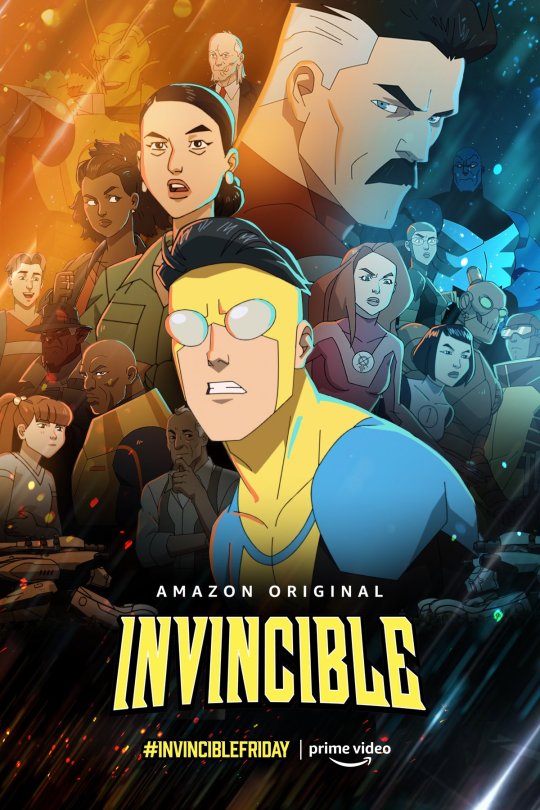
How do structural mythology, cultural studies, and cultural history reflect the series’ world and world-building around superheroes?
Invincible, much like many modern iterations of the “Capepunk” superhero genre that explores superheroism in a “realistic” manner accompanied by dark comedy and gruesome conflicts, offers commentary and its own unique premise on the cultural studies, cultural history, and structural mythology especially. The structural mythology of the show that initially borrows and parodies the structural mythologies of shows like The Justice League (2001) constantly explores what it means to be a hero through the main character, Mark Grayson. The 17-year-old half-human-half-Viltrumite high school student grapples with not just having to learn how to use his new powers, but also what being a superhero means, a concept that Mark struggles with throughout his entire career. A modest example of this is how Mark dubs his superhero alter-ego as “Invincible”, yet throughout the series, he is constantly beaten to near death and loses many major conflicts. Additionally, his father, otherwise known as Omni-man, someone whom Mark initially looks up to and models his superhero identity and perspective after, reveals to Mark that he comes from an alien race whose purpose is to conquer the universe and nearly kills Mark after Mark’s refusal to join in his father’s conquest. This is one of the most pivotal events in the series, as not only did it result in the death of thousands of people, but also is the beginning of the deconstruction of the illustrious image superheroes held and greatly influenced Mark’s career as a superhero.
youtube
The media of Invincible, which includes both the show and the graphic novel from which the show is adapted, greatly reflects cultural beliefs in their audience, more so in the comics, and adds onto these shaped beliefs. Apart from the show bolstering a wide array of superheroes from many different races and ethnicities, Invincible adds to the cultural view that anyone can wear the mask, a view famously explored through Spider-man media. Superhero monikers in the world of Invincible, primarily in the comics, are interchanged and evolved upon e.g. numerous people taking on variations of Omni-man’s identity and a few characters temporarily and permanently stepping in as Invincible with their own perspectives on what that position means.
The comic run of Invincible spans from 2003 to 2018, meaning there is a large element of cultural history that each major arc of the comic run is influenced by, however, the current run of the show makes some attempt to modernize some of the cultural history elements. One that particularly jumps out is the change in values of broadcasting and information exchange and how that has played a part in the growing caution and distrust for authoritative bodies, namely the U.S. government, among the younger generation. In some scenes in the show, as Mark is starting to develop agency in being a superhero, he has numerous arguments with Cecil Stedman, the government agent in charge of the Global Defense Agency, and even defies orders that Cecil gives him in acts of both rebellion and growth in his own ideologies on ‘superheroing’.
In what ways are the superheroes and their abilities informed by their racial, gender, sexual, and cultural identities?
In many cases, superheroes in Invincible are inspired by already existing superhero entities of both Marvel and DC with a range of alterations, some of which are informed by their racial, gender, sexual, and cultural identities. Both Mark and his father Nolan exhibit powers popularized by DC’s Superman that also similarly stem from their cultural identity as aliens, namely, Viltrumites from the planet Viltrum. Though not explicitly explored in the early stages of Mark’s career, his Asian identity also plays a role in his superhero identity. Many male characters seemingly naturally have some degree of increased physical strength and durability as part of their abilities with very few exceptions like Rex-Splode whose ability is able to create explosions by charging molecules to an unstable level of power. Most female superheroes exhibit abilities that aren’t necessarily akin to physical strength or explosiveness and more so some form of manipulation of matter, with very specific exceptions in characters like Monster Girl who shares similarities to Marvel’s Hulk in that she can transform into a large monster with supernatural strength, durability and healing, and War Woman who bares similarity to DC’s Wonder Woman in numerous ways, including her supernatural strength, speed, and durability
youtube
The show also shamelessly plays into the trope of having black male characters have superstrength and/or supernatural durability, as there are numerous black male characters, both heroes and villains, who have almost the exact same abilities with the exception of characters like Darkwing, the Batman-inspired superhero.
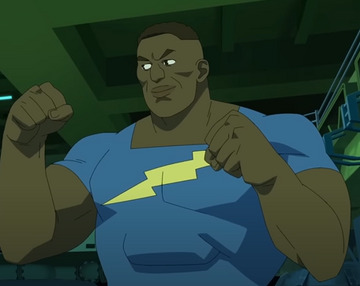
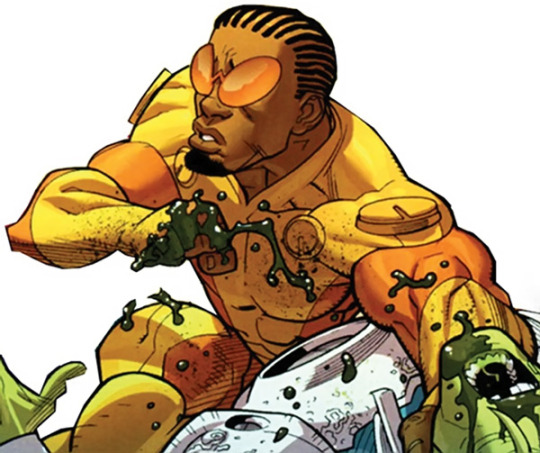

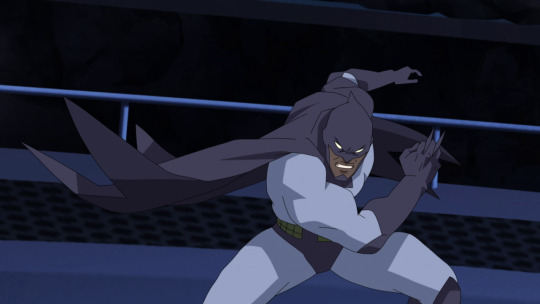
In what ways do costumes and concealing identities further separate the superheroes from normal society? How necessary is it for the superheroes to hide their true identities to successfully achieve their goals?
The show takes some time to explore the process of how superheroes pick their costumes and how they choose to have their identities displayed, such as hiding one of their identities or making attempts to separate them.
A somewhat common trend among some superheroes of the world, usually superheroes who have had experience in the careers or are generally older, is that they don’t wear a mask or any sort of garment that could skewer their identity, which makes a lot of sense for superheroes who don’t have separate identities in their day-to-day lives, but for characters like Omni-man/Nolan Gray and Atom Eve/Samantha Eve Wilkins, one of Mark’s friends and allies, they’re still able to hide and separate their identities without using a mask of some sort. This isn’t quite successful for Eve as Mark is able to recognize her at school after encountering her as her superhero counterpart earlier, and she offers an explanation that most people don’t expect someone they know to be a superhero, a very Hannah Montana situation that mostly works. Mark, however, has a number of reasons as to why he has to wear a mask, especially for the safety of his friends and family, as there are numerous cases in the comics where villains exploit his identity as well as his ties to his Father.
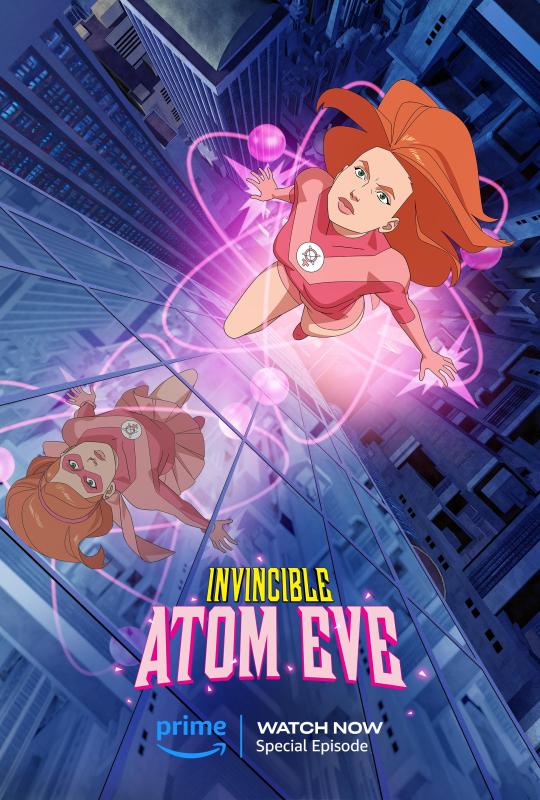
The costume designs also play a part in separating the superheroes from society and are explicitly described as symbols. When he starts, Mark builds his costume with the notable goggles and bandana to hide his identity. He later visits Art Rosenbaum, a suit tailor who designs many of the costumes of the show, and we see him create Invincible’s suit and mask that he dawns for most of his career that helps hide his identity as Mark Grayson (an important detail that will be explored quite soon in the series). When picking a suit design with Art, Mark states that he doesn’t like the orange and yellow suit designs and wants something “more iconic” (hence the yellow ‘I’ in the middle of his suit). This reflects both Mark’s understanding of the superhero identity that is modeled greatly after his father who dawns an ‘iconic’ white and red suit with the letter ‘O’ on it, a symbol, as Omni-man describes it, and the design of other superheroes entities of the time that dawned sleek black lines and colors that accompanied whatever other color scheme the superhero wore.
youtube
How do the economic, political, and social events that occurred during the series’ creation and broadcast cultivate and inform the superheroes’ decisions and actions?
The Invincible comics began its run in 2003, meaning some of the comic elements and stories may have been influenced by the period of time in which there was a heavy focus on the United States combatting terrorism following the events of 9/11, as many “alien threats” dealt with by the superheroes resemble this period. Sam Raimi’s Spider-Man (2002) also came out a year prior and is heralded as a large influence in comic book superheroes, most likely also being an influence in the creation of Invincible as they share very many similar elements (and even have various comic runs where both characters crossover to work alongside each other and are drawn by the same artist).
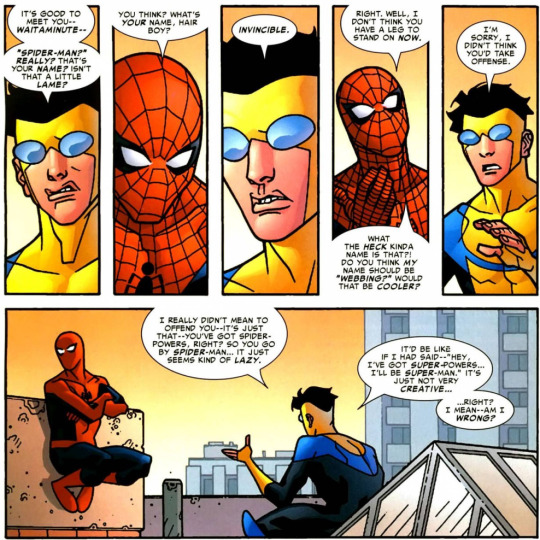
Nonetheless, the T.V. show that’s been broadcasting since 2021 very much attempts to modernize the story, and we see elements of more transparent Government involvement (or rather more exposure into the credibility of the Government) following major events such as Trump’s impeachment. Additionally, in recent years there has been general dialogue and questioning over the State following more and more largely broadcasted and empowering social justice movements and mass protests in recent years (e.g. the Black Lives Matter movement) that have worked to counter a lot of authoritative policies as well as deconstruct prevailing social constructs. In the show, this can be reflected by how Invincible (and several superhero characters) begins to make more of his own decisions instead of simply following orders given to him by Cecil, as well as a general distrust for Government authorities by the general public due to either their reliance on Superheroes and their continuous exploitation of people, both superheroes and non-superheroes.
How do the superheroes question themselves, each other, and their obligations and duties to the people around them?
Mark especially questions his role and obligation as Invincible as his plate grows larger, takes on more responsibilities and constantly has his beliefs toyed with. Growing up with a father as a superhero, being a superhero just like him had been Mark’s dream for 17 years. However, after having his whole world shattered when his father revealed himself to be a world conqueror playing “superhero” and “family man” as a means to accomplish his goal of conquering Earth, killing the most powerful superheroes and thousands of civilians due to Mark refusing to join in the conquest, Mark begins the continuous journey of questioning his role and responsibility as a superhero, often fearing he would turn out like his father and constantly blames himself for the destruction Omni-man/Nolan caused. Even in the second episode, we see Invincible learn the nuances and difficulties of superhero work when he causes the death of an Old lady while trying to evacuate her from an alien invasion.
youtube
youtube
A common theme in the show is the irony of Mark’s superhero name, Invincible, and how he is often going up against threats that are a lot more powerful than him and he repeatedly gets beat up and loses his battles. This takes a toll on Mark, causing him to question his abilities more often than not, as well as those close to him e.g. his mother. It also plays into the theme of growing up and independence and all the challenges that come along with it.
youtube
Atom Eve also goes through her own journey of establishing her obligation and duties as a superhero, as she comes to the realization that her abilities (the power to see and manipulate matter at subatomic levels) could be used for more humanitarian purposes like solving world hunger and building homes rather than being reduced to violence in the form of crime fighting. She leaves her superhero team in order to pursue this goal, which she learns comes with its own challenges that cause her to question whether or not she’s doing the right thing.
youtube
Our season 1 antagonist, Omni-man, has his own journey of questioning himself and his obligation as a superhero. Initially, his militaristic, planet-conquest mindset that is instilled in Viltrumite culture is conflicted when he comes to Earth and learns about humanity and societies on Earth, developing an obligation to protect the planet, even if he planned to conquer it in the future. Even after revealing his goal was to “breed” a suitor, a.k.a Mark, that could help him on his conquest, he is unable to follow through because he’s overcome with emotion and memories of his time on Earth while nearly killing his son. In the 4th episode of the 2nd season, Omni-man shares a vulnerable moment with Mark/Invincible where he talks about how he doesn’t understand why he cares for and feels obligated to protect a “weak” alien species, why he feels like this should be his purpose instead of the Viltrumite conquest, and why death and the guilt of his actions suddenly begins to weigh on him for the first time in his life. The episode ends with Omni-man fighting his ex-comrades to protect an alien planet alongside his son, completely showing an overhaul in his initial ideologies, and is prepared to die for the Thraxan alien species.

@theuncannyprofessoro
19 notes
·
View notes
Note
How do you think campaign one would’ve gone if Dorian was the 8th PC member of Vox Machina instead of a certain sorcerer I shall not name? In this potential AU Dorian would be sticking around past the Kraghammer Arc obviously.
Unfortunately I don’t think I can give an in depth answer to this question for two reasons:
1- I have not actually watched C1. 😅 I have absorbed things through dashboard osmosis, Kith and Kin, and now, TLOVM. But have not formally watched the campaign.
2- As someone who likes approaching narratives from a character-first perspective I don’t usually dive too deep into possible AU’s that come from replacing characters with each other? Esp with something like CR that is deeply, deeply character based, I assume C1 would have looked fundamentally different with a different (permanent) character added into the mix, in the same way that C2 missing any of the M9 characters would most likely be a different story entirely. I think even if I knew VM better- IMO, adding a character, removing a character, replacing, etc, alters the underpinnings of the story, and I honestly am not sure I have any idea what the new outcome would look like. 🤔
As a compromise, some guesses on specific character interactions I could indulgently imagine happening (please remember point 1 above) (this is all just fun speculation, wildly indulgent, etc).
- I think Dorian might get drowned out a little easily in the beginning- he tries very hard to be pleasant and polite and easygoing, and I feel like it might work against him in early-ish C1, at least with what I know of VM.
- Dorian and Keyleth would probably get along REALLY well!! Thinking about this makes me quite happy, actually: so much to discuss around mantles on shoulders, heavy expectations, not quite feeling steady in your own skin and capabilities for one reason or another.
- (possibly Pike and Dorian for similar reasons, although I’m less sure there).
- Vax, Vex, and Scanlan would probably enjoy flirting with him to see him blush and it would be very funny. Percy would also find it funny but would probably do it a little less often.
- Percy and Dorian either bonding over High Society Bullshit, or one of them being wary of the other person because of their own complex relationships/feelings about it.
#critical role#spar speaks#my apologies if this isnt what you want I think I just don't quite jive with these sort of character swap AUs bc imo#it fundamentally alters the story. like still could be a VERY good story but its an entirely different one and should be treated as such#similarly the character arcs are also altered as a result of this. and so at some point the guesses feel like me taking way too much liberty#;P that said dorian would have been a lovely alternative to That Char yes#dorian#vox machina#ish?#speculation#idk if this entirely counts as meta#ask away!
18 notes
·
View notes
Text

Ancient races, telepaths, planet-killer starships, a warrior caste cabal that refuses to accept the war is over and a cliffhanger ending that leaves our heroes at their lowest point. ‘Aurora Burning’ has all this. But as I’ll discuss, so did some popular 1990s sci-fi.
‘Aurora Burning’ is the second part of the ‘Aurora Cycle’ trilogy. Before reading further, you should read my comments on book 1 (‘Aurora Rising’) as this review builds on my previous post.
Advancing the plot & multiple viewpoints
One of my criticisms of ‘Aurora Rising’ is it was largely a novel devoted to developing the key characters, while only doing the mot basic set up for the major plot arc of the trilogy. ‘Aurora Burning’ continues to develop the characters, but the story arc is moved forward much more in book two. The big picture plot finally begins to unfold, as Squad 312 race across the galaxy seeking to acquire the ultimate weapon they need for the battle with the ancient enemy.
The ‘multiple viewpoints’ issue I complained of in my review of book one isn’t as much of a big deal here. In part this is because we’re more familiar with the characters. But it’s also made easier because for much of the book the characters are in different locations or solving problems that are unique to them.
My enjoyment of the story has definitely increased as a result of these two things being addressed. As such, the final book of the series is now next on my reading list. I’d also give the trilogy a higher recommendation than I did based on ‘Aurora Rising’ alone. Though that comes with the caveat that one probably has to read the entire trilogy for maximum enjoyment.
But there’s an elephant in the room that we need to address. One I hinted at in my previous post where I raised the issue of how many familiar sci-fi tropes the novel drew on.
Caution: Spoilers past this point.
Acknowledging the past, but a little too familiar in parts
I’m going to hypothesise the authors of the Aurora series are fans of 90’s sci-fi.
There’s numerous references to Star Trek. For example, we have ‘Picard6’ (a location), ‘The Janeway’ (a ship), and a race called the Rikerites. There’s also a scene (part of a training simulation) where the dialogue sounds a lot like Morpheus’ “do you think that’s air you’re breathing” speech from ‘The Matrix’.
The plot also involves a god-like race called the Eshvaren seeding the galaxy with beings created in their likeness. While this isn’t a unique idea, it’s another that appears in Star Trek:TNG S6E20 ‘The Chase’.
The beings from Trek created life in order to leave behind a legacy, while the Eshvaren seeded life across the galaxy in order to give rise to telepathic beings who would become the trigger for their super weapon and win the ancient war against the Ra’haam. In this regard, the Eshvaren are perhaps more like the Vorlons from Babylon 5. The Vorlon’s manipulated the DNA of younger races to create telepaths for their future war with ‘The Shadows’ . They also altered the DNA of younger races to ensure those aces would see a god-like vision if they ever saw a Vorlon outside its encounter suit.
Another similarity: The Warbreed Cabal in the ‘Aurora’ series are a group of Syldrathi warriors who refused to accept the peace treaty with the Terrans and who start a civil war. In this regard they’re a lot like the warrior caste in Babylon 5, who similarly initiate a civil war, in part because of their dissatisfaction with the decision to make peace with Earth. (Another example: Ronan in ‘Guardians of the Galaxy’, yet another warrior who refuses to accept a peace treaty.)
There’s probably more, but these are the most obvious ones that stand at at the moment.
Signs and Portents
Based on these similarities, I predict:
The Eshvaren turn out to be a bit like the Vorlons. Ancient race who portray themselves as the light/good but who end up being problematic in their own way.
Aurora finds some sort of resolution that doesn’t involve fulfilling the Eshvaren’s desire for her to wipe up the Ra’haam. In Babylon 5, the protagonists force a confrontation between the Vorlons and Shadows then tell them to ‘get the hell’ out of the galaxy and leave it to the younger races.
Time travel shenanigans. This has already been teased in ‘Aurora Burning’. The question is, will we see something akin to Babylon 5 ? (1) In B5 the enemy is defeated in the past by sending a weapon and hero to the past. Most likely this will take the form of at least one of our heroes time travelling and influencing the formation of the Aurora Legion. (2) ‘Babylon 5’ has “a Minbari not of Minbar” as a result of Sinclair travelling to the past and adopting the identity of Valenn. would not be surprised to see something similar involving a human and Syldrathi.
Anyway, I’ll leave the predictions here so I can actually get on with reading the final book. Let’s see in a few weeks how I actually fared with the predictions.
2 notes
·
View notes
Text
Dean’s Body as a Punching Bag
Ever since I made this post about Sam and (his lack of) bodily autonomy (as well as the follow-up post that carries the theme through the other 10 seasons), I’ve been trying to determine what the corollary for Dean is. Re-watching 5x01 made it jump out at me in a huge way:
The bodies of the people that Dean loves are consistently used in a way that hurts/harms Dean and metes out violence against him. And it is specifically his loved ones’ bodies themselves, not shapeshifters or lookalikes or Leviathan either. It is the people he loves’ hands and fists and weapons.
(I need a snappier way to word that, but bear with me).
Where Sam’s bodily autonomy violations occur before he’s born, and are seen as early as the pilot with Azazel in his room and with the Woman in White, Dean’s analogous theme doesn’t sneak in until the mid-season finale with Asylum.
In this episode, Sam gets infected with a sort of ghost-possession/ghost-sickness (another example of a violation of his bodily autonomy) and his internal anger becomes external, focused on Dean. Sam attacks Dean violently, and Dean goes so far as to hand over a (thankfully unloaded) gun and in this altered state, Sam actually tries to shoot him.
Ouch. The person Dean loves and most wants to protect had his body violated and used against Dean. This theme is going to carry us through the next, eh, 10 or so seasons, with some tail-end examples even after that.
In Season 1 we have Asylum mid-season, and we have the finale in which John is possessed by Azazel and hurts Dean most grievously, almost kills him. In Season 2, Sam is possessed by Meg and shoots Dean (in the arm). In Season 3, we had a writers’ strike and a season cut short so I can’t think of any examples there (but lots of other shit to unpack for another day).
The in Season 4, we have Sex and Violence, which is super interesting. While Dean is the one targeted by the siren and therefore the one whose body is used against his brother to hurt him, the actual violence doesn’t start until Sam is also infected. Sam’s body is violated by being held at knifepoint by his brother and his mouth forced open to accept the siren’s venom, but then it’s a fist-fight, a showdown. Both brothers’ bodies being used to hurt the other, but getting to that point required Sam’s body to similarly be ready to be used against Dean.
Season 5 is literally bookended by instances of this happening. First, true to the idea that Dean sees Bobby as family, Bobby becomes possessed by a demon and he violently attacks Dean. And then Swan Song, most famous example by a huge margin, Sam is possessed by Lucifer and is fist-fighting Dean, destroying his face and killing him with his fists, and it is his overwhelming love for Dean that allows him to overcome this possession and save the world.
The theme is carried forward for a few more seasons, pretty much until that narrative turning point in Season 10 that I mentioned in my post about Sam. In Season 6, soulless!Sam allows Dean to be hurt by a monster, harming him by proxy. In season 7, Sam is hallucinating and almost shoots Dean. In season 8, Cass is programmed by Naomi to kill Dean, and in the episode Goodbye Stranger beats him to a pulp before overcoming this programming. In season 9, when Gadreel reveals himself and takes over Sam’s body and kills Kevin, he also attacks Dean.
Skipping Season 10 for a hot sec (more on that below), Lucifer also later possesses Cass in Season 11 and harms both Sam and Dean. In Season 12, we get brainwashed Mary attacking her sons (and overcoming possession thanks to Dean). And possibly examples from S13-15 that I’m missing (Garth being affected by Michael? Cass being affected by Rowena’s spell? Both Sam and Dean were affected by the Witch from Wizard of Oz, right? I honestly can’t recall the late seasons near so well). But regardless we see the theme play out in the final 5 seasons, just less and a bit different than it had prior.
-
Now, let’s unpack the S10 shift a bit, and why it changes things for this theme of Dean’s.
In S9, Dean takes on the Mark of Cain under the weight of guilt and self-loathing from having violated Sam’s bodily autonomy by tricking him into being possessed by an angel (and forcibly having him possessed by a demon to then fix that angelic possession). In this instance, Dean is willfully taking on something that alters his own body, and the narrative between he and Sam is flipped. Now Dean is the one with something ‘evil’ marring his body and impacting it outside his control, and now Sam is the one who is ignoring Dean’s protests and autonomy in order to save him from this thing, consequences be damned.
That 2.5 season role-reversal arc was huge for how it changed Sam’s storyline for the final 5 seasons, and similarly huge for how it impacts Dean’s.
Dean is now the one whose body is being used as a weapon against those he loves most, and he is the one suffering that loss of autonomy and control over himself. He is sick with bloodlust, is turned into a demon, is drawn to the First Blade, and is not in full control of himself. When the Darkness is unleashed and Dean suffers the emotional consequences of feeling tied to and drawn to this monster (woman? celestial being? godlike person?) against his will.
The Mark/Darkness narrative shows us that Dean’s body might belong to him, but it too can be corrupted against his will. Dean learns that he won’t always be able to choose, learns what it means not to have control over his own body. That while he puts his family as his duty above all else, while he would sacrifice literally everything (his body, his soul, the entire universe) for his little brother, the opposite might also be true, even if Dean doesn’t want it to be.
(And I said elsewhere that I fundamentally believe this narrative role-reversal was a consequence of him overstepping his ownership over Sam by tricking him into taking Gadreel. Their positions are swapped because they have to be, because narratively it becomes necessary for Dean to know what this loss of autonomy feels like, and for Sam to override his brother’s choices, or else they may never find a sense of equilibrium again).
By the time this Mark/Darkness narrative wraps up, Dean is fundamentally, irrevocably changed. Where in Season 5 it was completely unthinkable that he would agree to be a vessel for Michael, it is in the finale of Season 13, just two seasons after the Darkness storyline wraps up, that we see him take Michael into himself as a snap, in-the-moment decision. What was previously unthinkable is now canon.
Because Dean is now different. Because his core of protecting Sam is the same, but his theme of how others' bodies are used against him has now upended itself, and he now has had his body used against others.
In my post about Sam, I said that in the end for the final seasons, the narrative has shifted from Dean owning Sam’s body to Sam also owning his own, and them acknowledging that they are in this together as a result of Season 10. I believe that happens with Dean as well, owing to this reversal. Sam has now taken some ownership over Dean’s body by getting rid of the Mark, and Dean has relinquished some of his tight-fisted control over himself.
So Sam is sharing ownership over his body with Dean (in the vein of “I can’t pretend you won’t do whatever you can to keep me alive, even if I don’t want it, but we’re in this together” and “if we die we do that together too”), and Dean is also sharing ownership over his body with Sam (in the vein of “I’m no longer convinced you’re going to abandon me, so the things that I will do to keep you by my side will be met equal between us” and “when it comes to keeping you safe, it’s my autonomy I will give up first, not yours”).
-
But what does this particular form of bodily-violence-from-family say about Dean from a thematic standpoint?
In my post about Sam, I talked about how the themes of possession (ghost and demon) and demon blood are inherently about bodily autonomy and free will.
For Dean, thinking through this theme of his loved ones being used to hurt him, I’m torn trying to find the way to word it, but I feel that it has to do with his themes of self-effacement as love, as protection and duty. It’s about being willing to suffer anything (even to the point of death) to protect his family, the ones he loves most. Family is the end-all-be-all to Dean, and protecting his family (most especially his little brother) is the core and heart of his character. It is a duty and a responsibility and a calling and a purpose.
To remix a quote from the film Legend, Dean’s devotion to his brother (and to a lesser extent, to everyone else he calls family) is how he measures himself. There’s no single word for it, as it’s a mix of protection as love, as an instinct, but also as a fundamental duty, an identity. His internal compass.
So Dean’s narrative invokes free will in a very different way than Sam’s. Dean always had and has free will. He had the will to sell his soul, the will to refuse Michael. He has autonomy over his body and he has choice, so much so that he makes choices over and over for Sam. Instead, Dean’s struggles with autonomy of self as related to his constant effacement (to the point of complete ego-destruction and physical loss of self) for the people he loves. He will die, sell his soul, let himself be beat to a pulp, and anything more that the situation calls for, so long as it means protecting or not harming his loved ones.
The original Swan Song end is a tragedy of Shakespearean proportions, in the style of Greek tragedy. Sam’s struggle for autonomy, and the moment he claims that autonomy for himself, he falls into the Pit for eternity. Dean’s original intended Swan Song ending is analogous: a struggle to exist as more than his duty to his family, and right after he accepts that Sam is allowed to choose Lucifer and death for himself while Dean may continue on living, he then chooses to fall into the Pit after his brother so they could be together (in Hell, in the Cage) eternally.
Both of them have these absolute tragic flaws and in the first Kripke-era arc, tragic sacrificial ends. Sam’s relating to will and autonomy, Dean’s relating to love, family and protection/duty. Both of them belonging to themselves and to each other.
-
-
A few extra things about this theme worth noting:
1. the people who love Dean are always in an altered state when they harm him, whether it be possession, brain-washing, siren venom, soulless, etc etc, which I think goes to show in some ways how this love as a given to people who will never deliberately harm him.
2. in a huge proportion of these instances, Dean is saved by the person who loves him reclaiming themselves over and above their altered state. John overcomes Azazel’s possession (arguably, I would say, deliberately from Azazel, but let’s not quibble). Bobby stabs himself in the stomach to save Dean. Cass overcomes Naomi’s brainwashing. Sam overcomes the literal Devil possessing him. Mary overcomes some brainwashing (I think?). Etc. So Dean's love as sacrifice is rewarded?
3. Sam’s body is the most frequently used to harm Dean.
#supernatural#supernatural meta#spn#spn meta#dean winchester#dean winchester meta#oof#i made myself sad#i gotta stop thinking too much about these damn brothers#long post#long post for ts#violence tw#abuse tw#family violence tw#in a weird way#ask to tag#apologies for typos this got away from me
90 notes
·
View notes
Note
do you think it’s possible sarah (hoppers daughter) was an early-formed alter that went dormant before the events of season one? it’d make a lot of sense with how much of hoppers arc in season one was him mourning her and channeling that grief into protecting will (which would make sense since he seems like a protecter to both will and el). love your posts!☺️
Yep . :D
I already discussed all of this in the original did post - how sarah was a “little” (kid ) alter. And how hopper was a protector /introject alter. I also discussed her going dormant as a major possibility in my did theory. My assumption is she either (a) “became dormant” like some alters do- aka they are “gone” sometimes for many years but can return . And this can happen in a myriad of ways - sometimes alters go dormant after they had a simulated death in the inner world . theoretically sarah had such a Death. And so did El. Death isn’t really a permanent thing for alters ...they usually will come back or stay dormant - unless the body of the host dies (or they integrate) . They can’t really die . I think it’s very possible she comes back and Hopper while exploring the various innerworlds of Will’s minds (like the Russian one, the memory scapes , etc ) reunites/ finds her . look at the st s4 movie inspirations. In ‘what dreams may come” a guy with the guidance of his dead kid explore a heaven like world influenced by a painter’s emotions.We also have the movie ‘inside out’ -which involves “memory islands” (distinct worlds based on a child’s memories) which are influenced negatively by the kid being depressed she moved to California. The characters traveling to these memory islands are constructs of kid’s mind -and 1 of them also has a guide helping them explore the ‘memory islands’. in Inception a guy says he’s a construct of a guy’s mind and needs to help him escape the many different Ievels of the dream worlds.The in inception who made the worlds- had dad issues. 'the cell’also had alternate dimensions of a man's mind that a cop explored ( the dimensions were created by a man who was ab*sed by his dad). Movies like inception, matrix, Truman show, total recall, the cell, enter the void, wizard of oz, Peter Pan, hellraiser 2, dream warriors, bill & ted’s bogus journey, and welcome to marwen also allude to this: because they involve entering simulated abstract worlds usually created/based on happy& traumatic memories/fears.Cough s4 using the movie wizard of oz quote “we’re not in Hawkins (kansas) anymore.While truman show/matrix are more about realizing your reality isn’t real.in bladerunner 2044/total recall it has the theme of false implanted memories… probably relating to hopper realizing he’s an alter and not in “actual Russia.” Before seeing the other segments of the innerworlds with sarah. Like in total recall- the bad ass spy is told all his memories: his wife/ years of marriage, , his name, are just implanted memories. And she says “you’re life is a dream.”
In s2 Nancy asks Steve how his “grandpa’s time in the war is a metaphor for your life?” And steve compares the mf to the germans in the war. Dr owens mentions Will has ptsd like “ (vietnam) soldiers’, Hopper saying he had buddies like Will . “In the 70s there was a study that compared the post-traumatic stress symptoms in Vietnam veterans and adult survivors of childhood s**ual ab*se. The study revealed that childhood s**ual ab*se is traumatizing and can result in symptoms comparable to symptoms from war-related trauma.” Hopper isn’t actually in Russia -but in one of the innerworlds (after he jumped through the rift of the machine- into Will’s mind). We’ll see flashbacks but also present circumstances of his imprisonment echo Will’s past with Lonnie (if the movies indicate anything)- being starved, guards getting payed in order to let other prisoners r*pe a gay prisoner (than claim incorrectly because of his sexuality he wanted it) , as well as a gang of sadist men who r**e others and a warden using that as a threat to be compliant , being thrown in a dark room of solitary confinement and starved when they didn’t obey the warden, the warden being religious, etc. And the Anerican soldiers (in Vietnam) in the movies aren’t much better and do similarly horrific acts to civilians like r**e and bragging/ happily k*lling women, children, and the elderly. The drill sergant in vietnam calling them homophobic slurs & women, and chocking one of the soldiers with one hand, slapping one for not believing in christianity. Tying up a soldier in a bed , gagging him, beating him and saying “remember it’s just a dream.” Only praising them when good in fire arms.(movies : fullmetal jacket, papillon, shawshank redemption, platoon, welcome to marwen, etc ) . My assumption is flashbacks of his life- will hint he’s an alter of Will’s-the boxes in the basement are “vietnam” ,“dad”, and “ny” (and these are the memories of his we’ll see). And some of the bad characters in said stories will also parallel Lonnie . For instance in s2, Jonathan mentions Indiana writer Vonnegut- In his book ‘slaughterhouse 5′- Vonnegut begins the story of Billy Pilgrim, a man who has “come unstuck in time”. It accounts of Billy Pilgrim's capture and incarceration by the Germans during the last years of World War II, and scattered throughout the narrative are episodes from Billy's life with his dad, and his own wife and kids.Billy is forced to be part of the war and similar things against his free will. The moments start from his childhood when his father throws him in the water to teach him how to swim. He was unwillingly drafted into the war. Later, he is kidnapped by Tralfamadorians (aliens that are implied to be caused by his mental health issues/trauma) against his will. Therefore, he realizes that this concept is just an illusion.
And some of the bad characters in said stories will also parallel Lonnie . Like how in ‘peterpan’- the young girl Wendy imagines netherland and the villain -captain hook- is based off her father ( in the movie they have the same voice actors/while in all stage productions the 2 characters are always played by the same actor). Similar to the other s4 film- ‘wizard of oz’ where the wicked witch of th west from the mythical land of Oz (is played by Dorothy’s real life mean neighbor in the real world/kansas). Or ‘in the cell’- every villain from the alternate-mind- dimensions is played by same actor in diff makeup. Not sure if they’d use Ross Patridge (actor of Lonnie) in this way . But it would be very interesting if (In makeup) Ross played many negative people in Hopper’s life/past -as a way to show Will’s past tr*uma.
Like also-look at Sarah’s tiger plushie! In chinese mythology/culture: “The tiger is personified by the constellation Orion (interesting given Sara’s interest in space/blackholes). The tiger represents protection over human life (hmm?). Tiger charms were used to keep away evil and disease (that’s awful ironic if she died in the manner she did). In Buddhism, wearing tiger skins during meditations was believed to bring protection from spiritual interference and potential harm while exploring astral dimensions.” HMMMMMMMMM XD
Kali in the stranger things novel ‘Suspicious Minds’ says…
“I was named after a goddess. She wore a tiger skin and was fierce in battle.”
Then Kali says to Alice (a women who can see future visions): “I love you, Alice. We can be tigers together.”This parallel (in relation to Alice) is fascinating because Kali actually uses her powers to fake Alice’s death- and to trick Dr. Brenner, and allow Alice to escape. The allusion was so realistic, that Terry could even touch the ‘dead’ Alice.
So the tiger symbolism could be a HUGE hint- that Sarah’s death was simulated and she’ll come back and travel the innerworlds/alternate dimensions of Will’s mind (as Hopper’s guide). Hopper about sarah “galaxies the universe-she always understood that stuff.”
Another possibility (theory b) is she integrated with another alter or with Will (which means she can’t return) .Hopper saying about Sarah “the black hole it got her.” Could imply she integrated with the mf/shadow monster? And ,or maybe she will later ?
But... I lean heavily to theory (a) the most , though.
Obviously sarah has a lot of the connections to Will. will and Sarah both being into science, Sarah winning a spelling bee, Will winning the science fair, both being connected to tigers. Both hallucinating something no one else can see and people trying to snap the 2 out of what they’re viewing. Joyce saying as a witch she’ll eat Will. Parallels Hopper saying as an ogre he’ll eat sarah. Hopper, in s1, when seeing Will (with a vine in his mouth) has a flashback of Sarah on a mouth respirator. And he also has a flashback of Sarah when seeing Will’s lion plushie which resembled Sarah’s tiger plushie. And el also had a lion plushie-like Will’s in s1. Hopper monitored both Will and Sarah at the hospital when they were “dying”. Will has a fear of clowns- and Sarah’s hospital gown had clowns on them. All 3 kids draw.
Plus, we all know the parallels of Will to El (Hopper’s new daughter).
I discussed in my did theory that Hopper (as an adult alter) is a form of protector to all the kid alters - el, Sarah, and Will (host/core). And Hopper as an introject-alter (who are alters based on a person the child knows ) are usually put in the system cause the kid assumes that person could protect them . And since original-Hopper was a police man (a little kid could easily assume that). Although, because he’s a “father figure” for the system he has some of Lonnie’s traits- which are reflected in other perpetrator alters/ bad npcs in the system- Brenner, Neil, Billy, the evil’s Russians,etc . So sometimes he acts similar to a Perpetrator alter too . And I listed those examples/bad parallels extensively in the original did post (linked in the beginning).
And I used these quotes from psych papers in my original did post to pretty much sum up Hopper’s use in Will’s system .
“Introjects can also be based off of figures that the dissociative child found strong, courageous, heroic, or otherwise worthy of being emulated and internalized and could theoretically protect them.”
“Older adult alters are created to serve a nurturing or parenting role, thus serving as a protector. (*protecting Will/el) . However, sometimes their older age is related to taking on the identification of the ab*ser and can therefore take on any of the other more hostile roles too ... Introjects which are mimicking ab*sers are trying to "keep you inline" in order to protect you from external ab*sers. They are copying behaviors shown to them by bad people, not harboring the intent, s*dism or imm*rality of the actual perpetrators.”
I think it pretty much sums up the nuances and motivations of Hopper’s character.
Thanks for the ask, anon :)
#jim hopper#stranger things#sarah hopper#will byers#kali prasad#el hopper#stranger things theory#did theory#s4 theory#st movies
43 notes
·
View notes
Text
talkin bout fuckig manga
hey it’s me, haven’t had internet for over a week and i’ve been sick and uni and blah blah blah time for a rant about manga
this time its about "Soredemo Machi wa Mawatteiru", tl;dr, good manga read it idk
lots of bullshit below the cut
Before anything I say gets too confusing or I go off on an insane tangent, just know my recommendation is that you read "Soredemo Machi wa Mawatteiru". It's not very easy to find online since it has an official English release (which my recommendation extends far enough to suggest I might pick up in the future, just to have it, but I am very stingy), but there's an alright torrent of all the volumes on your local anime torrenting website, and is at the very least worth the trouble of reading as such. There is also an anime that gets better as it goes, but the manga is my primary recommendation. Beyond this point I'm not gonna give much regard to what I write, so get ready for anything, read the manga and see if you agree with me, or don't and see if I care:
BOUT THE ANIME: The SoreMachi anime is one of those rare comedy anime you find where the animation and overall production is just really extra the entire time. Hopefully you know what I mean because I won't really be able to explain it any other way, it's simply one of those shows where the jokes are decent and it's a fun time for the most part. Unfortunately, the anime makes a couple of critical missteps that kept me from getting far into it when I first tried watching it about a year ago, and in retrospect seem even less reasonable.
Starting with the good, as an adaptation it does a good job with most chapters it covers, it properly sources where each chapter comes from incase you intend to read the manga and skip around to catch up, and the anime adapts some sections to have additional jokes that fit very naturally in to the story. It also covers up some of those problems only manga can have like having a concert segment without any actual music involved, until they invent mp3-paper it's just something we'll have to live with. Translation work was pretty good (I watched the [WhyNot] release for those who care), which is extra important for something as difficult to translate as jokes from another language. The set of episodes they chose to end on was very good, and was expanded to be a lot more impactful in the anime. If it wasn't for the last episode being as strong as it was I may have given up on finding the manga when I saw it wasn't super easy to read online.
As for what the anime fails in, some episodes feature some really blatant over-acting that doesn't really help make characters believable, and there's this obnoxious gag that continues the whole where through where most scenes have a few seconds long line from what is essentially a forced mascot character, which usually mean nothing and only serve to harm the pacing of many episodes (there isn't even any sort of equivalent bit in the manga so I really don't know why they did it, most of the anime original jokes are pretty good so I just really don't get it). The biggest issue the anime faces is that the source material is about 140 chapters, while the anime is only able to cover 24 chapters. This comes with a LOT of problems, the first being what I'd call the "required reading". SoreMachi is not a 1-note simple comedy where you can skip to any chapter and be completely okay; There are many small but meaningful subplots lying beneath, and characters have a fair bit of development throughout. What this means for the anime is that the first 3-4 episodes are just the first few chapters of the manga, which are a bit rough and not as good as the majority of the work, which is true of a lot of comics (god fuck I promise there will be more than a first chapter of my comic I promise it'll get better fuck). In terms of the anime by itself, I'd say episode 1 is decent, 2 is middling, and by 3/4 their still taking a while to introduce members of the cast, and I didn't immediately want to finish it. I put the show down for a long time until my internet started dying and I wanted to watch something fun. Slapping it back on at episode 5 I immediately had a great time and watched the rest of the show pretty soon after. While I understand the reasoning behind doing this, the anime does not pay off this structure, as beyond the first few episodes, the chapters start being presented out of release order and out of chronological order, kind of destroying any consistent throughline. This decision in and of itself isn't the worst, since the comic isn't always chronological, and the volume ordering is a bit different from the release ordering, but the inconsistency makes the first few episodes feel lessened without reason. The other large failure that comes with only animating about 1/7th of the entire work is that many themes and concepts that are core to the manga are not represented in the anime well at all. One of the biggest is the rare but unnerving supernatural chapters, of which only one is animated, and not a particularly good one. In order to talk about these themes I'll have to transition into talking about the manga itself, since they aren't part of the anime.
DA MANGA: So one last recommendation that you read the manga, the whole damn thing. Cus we're gettin into themes and character moments that take a long time to pay off, and obviously is all part of my interpretations, so if that stuff means anything to you don't let me ruin it for ya.
The title of the manga is, in essence, the entire manga's "punchline" in that every chapter could meaningfully end with simply the text "And yet the town still turns..." (My translation of the title, fuck "And yet, the town revolves" or "But the town moves"); by this I mean most chapters end in an anti-climax where a mystery is left unsolved, or a mystery is solved and undercut by the realization that life simply keeps on going without much change. This is used to essentially force your eyes open to all possibilities when reading, as the main character spends her time acting like a detective, and these mysteries end up as either misunderstandings, secrets, riddles, and sometimes something out of the ordinary happens that makes you unable to pin anything down firmly. Similarly, these endings aren't always read-and-forget scenarios. Several chapters come back in the form of a continued joke, a continued mystery, or contribute to some greater purpose later. Readers are properly rewarded for keeping everything they can in mind, while also tormenting such people with loose ends.
I enjoy Hotori as a protagonist due to her character being defined not in flaws and strengths, but in mindedness. Hotori seems like a simple "haha she's dumb" character to start, but consistently throughout she proves that her strengths are in memory, observation, and deduction, while lacking in some more common sense and abilities. Her brain works in strange ways that some people may or may not understand, such as her need to think through even the most trivial fictional scenarios, which I relate to deeply.
The art and paneling throughout are wonderful. Ishiguro Masakazu is one of those artists who draws very simple characters, but knows how to use details and depth to breath so much life into the artwork. He also clearly uses the occasional supernatural happenings as an excuse to draw what he loved, as all sorts of artistic depictions of the supernatural come out that simply look satisfying. These parts obviously meant a lot to him since he's been working on a primarily mystery-action manga that has a lot more of that stuff in it. (Also, as hindsight is 20/20, if you've read any of his new work you'll notice that the main character of it is eerily similar to a character who shows up very late in SoreMachi that the author obviously fell in love with, cus she just keeps coming back and even ends up with a really unsettling end to her character arc despite only being introduced as a component in a harmless mystery. Feel free to call me out for the same shit 30 years from now when I'll probably do the same shit)
I'd like to get into some of the major themes of this work, as a lot of them hit very close to my mind (which I guess is true of any theme you recognize for yourself, you wouldn't really "get it" if it didn't mean something to you...).
The simplest theme, again, comes from the title. The main character, Hotori, expresses a desire that the town she lives in continues going on, unchanged forever. This is obviously a fear of change, which ya know, same, but also an exploration of what it means to fear change. Hotori actively tries to keep businesses from closing down, keep friends from leaving, and keep relationships from changing, while simultaneously making all sorts of new relationships and solving mysteries. Hotori even comes to realize that simply learning the truth about something changes the world through your own perspective, and that such changes can't be undone. In spite of this, Hotori mostly gets her wish, any time she fears that a large change will impact the town, its resolved about the same as any other issue. Whether its a message that even time can't keep you from your loved ones and that change isn't worth fearing, or a concession that large changes to the setting would be a bad idea in terms of humor, I can't really decide. This theme reaches it's conclusion in what is one in a series of "ending" kinda chapters at the end of the series. Hotori is faced with a supernatural ethical situation, save her town from destruction at the cost of her existence, or live through the disaster, knowing her town and the people in it will forever be changed. While the actual result is that nobody disappears and nothing is lost, and the event may have simply been a strange dream, Hotori confidently decides that sparing the people in her town from a life altering event is worth giving up her memories with them. A kind of bold spit-in-the-face to the idea that change is okay, where we find that Hotori didn't fear change for herself, but rather for the people around her.
There's another major idea in this manga, which takes a very long time to pay off, and completes its arc at the very very very actual end of the series, the idea of "leading someone to be something". A character that rides that line between main and side character, Shizuka, is a writer of detective novels, who feels the best person to judge her works would be a version of herself without the bias of being the author. She tries to achieve this by leading Hotori to be interested in detective works (including her own) and generally be just like her, starting from a young age. The end result is a young girl dead set on being a detective herself (or at least another novelist), while Shizuka keeps her identity as an author secret. She then uses Hotori as a scapegoat for herself, attempting to see how she would solve various mysteries and use that as inspiration, and this is depicted as though Shizuka were some sort of villain, which she may feel like she is. The end result of it all, though, is that Hotori was likely already a detective-minded person, and that even if Shizuka pushed her down that path, it was Hotori's decision to continue down it, and the very end of the manga is a scene revealing that Hotori figured out Shizuka's secret at some point, and even still respected Shizuka and aspired to reach her, and the two accept each other for who they are. I enjoy this ending a lot, since as an artist I've worried that some of my love or aspirations for and from other artists came with an ulterior motive of wanting a better community for art to exist in, but people are people and will make their own decisions, and some day everyone may be able to become equals in a truly meaningful sense, where everyone is inspired by and guiding each other together.
So that probably didn't mean shit to nobody and I didn't even really talk about anything in the comic like most of the main characters or any of the shit goin on but ya know fuck you go read it, and thanks for reading this.
#long ass post#also gonna have finals on my birthday this week so awesome#im having a good time this year h-haha
24 notes
·
View notes
Text
HealPre Final Review: Not terrible but not entirely laudable either...
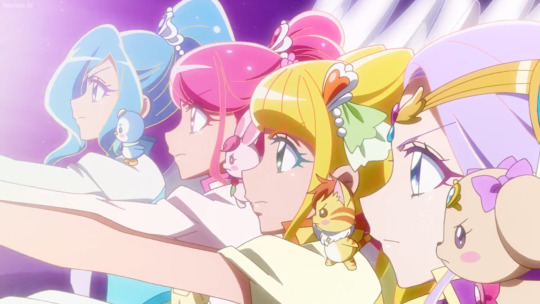
*sigh* Where do I start?
Well, one thing I’m pretty sure of is that COVID definitely affected production somehow. By that, I don’t just mean the show needing to go on hiatus, resulting in a shorter run compared to previous seasons. I’m also talking about any possible changes that might’ve been made to the original narrative, if there was one.
Much like how Suite’s story had to be altered in the wake of the 2011 Tohoku earthquake and tsunami disaster, I believe Heal underwent a similar treatment in response to the pandemic becoming more widespread as 2020 went on.
Especially since it dealt with health and nature, HealPre is probably the season that has come the closest in relevancy to real life events.
Frankly, that can be quite scary because this virus was and is still a fucking nightmare on a massive global scale. From that view, I can understand why the writers/producers would be concerned of the anime hitting too near home. At least for their main demographic’s (children) sake, maybe they were compelled to shift to something lighter and less edgier so that the kids could find some comfort and enjoyment in the midst of the world’s current crisis.
So I can’t fault Toei for that, if that’s really the case. Going through a pandemic is terrifying, infuriating and exhausting and UGH. We could use something that can help ease our worries or momentarily distract us even a little bit.
Though would it have killed them to dedicate one episode to the importance of wearing a mask or washing hands? (-_- ;;)
HOWEVER! Seeing as I am not a fragile child, I’ve still got several (oho~) criticisms to air out before I put this season behind me. This review isn’t particularly scathing but...there is a lot of discontent so you’ve been forewarned.
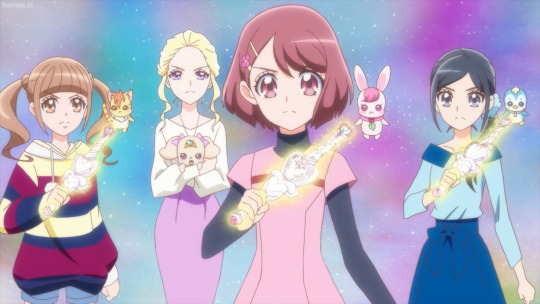
But first, let’s tediously review what structure means in Precure.
We all know that there are certain things that will forever (?) remain fixed in the series formula.
The plot is always going to be “magical girls fight evil doers threatening to ruin the world”.
There are plot points to indicate story progression but in reality, are put there to correspond with toy releases which are usually marked by these five: introductions, first power up, midseason Cure, second power up, and build-up to the climax + finale.
There is usually a specific message (a theme) to be told with every season and motifs (narrative tools) to aid in getting that across. For HealPre, the theme is “living is fighting” and its motifs are “health” and “nature”.
I left out “animals” b/c 1) it didn’t hold as much significance as the other two did, 2) animals are part of nature anyway and 3) let’s be real, it’s just a synonym for “mascots” which we already get every year. :P
Right. I’m probably forgetting something but for the most part, these are immovable pillars of Precure.
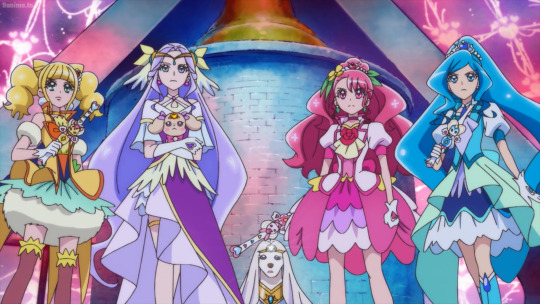
Story, on the other hand, has more variables you can work with.
Story is how you tell the plot, how you convey the message.
Precure, as a tv series, is unarguably carried by its main stars, the Cures. So it only makes sense that a huge percentage of a season’s success owes itself to how much of an impact its characters had on the audience as well as how effective their individual story arcs were as sub-plots tying back to the bigger picture (the message/theme).
Ideally, these arcs would shine the brightest in the filler episodes, where the plot (“good guys vs. bad guys”) is less of a focus so there is more space for personal development and growth.
Also, not all character arcs have to be directly related to the plot but they ought to be written well in order to support the overarching message (the theme).
Now, has HealPre done that? Has each girl’s story demonstrated a good example of what “living is fighting” means?
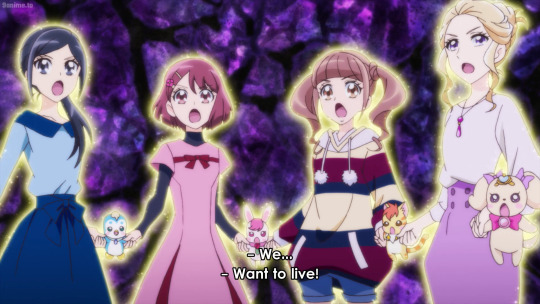
...nnnnnnyyeeee... look, even I can’t give a straightforward answer on that because while technically they did, by virtue of Nodoka’s observance in ep 44 recounting it as such, there’s also actually not enough to make it feel substantial from a viewer’s standpoint.
At least, that’s what I thought while watching HealPre.
With the exception of Nodoka’s, there was a lot of saying but not much doing to convincingly back the other girls’ arcs up. The fillers themselves were very weak, loosely composed in relation to the motifs and, if I may be so blunt, downright boring that if Nodoka didn’t phrase those episodes as things that counted towards the theme, I probably would put up more of a fight on disagreeing. so shoot me, I’m soft for her :P
And I know that sounds confusing right now but I will elaborate as I continue.
Before that though, to be utterly fair, some seasons keep their respective themes shrouded in vagueness until they’re given a more concrete form in words around the finale. So it’s not like we can do much except make educated guesses on what they really are. Most of the time, we’re just measuring everything against our perception of a standard in the fog. Or maybe that’s just me?
Nevertheless, you can just tell, y’know? By simply watching and observing the whole show, you can tell if the characterization, the development, and the outcome (essentially the content given) really live up to what the season claims is endgame.
So let’s go through that first then. The characters, starting with our lead Cure...
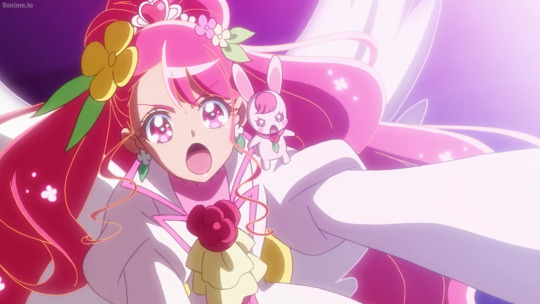
Nodoka being the only Cure in her team to have an arc deserving of the praise “exceptional” should come as a surprise to no one.
She was the most solid in terms of direction on how her story was going to proceed. Out of all the girls, her journey had the greatest connection to the subject “health”, repeatedly delved into it every time the spotlight was on her and fulfilled everything it seemed to promise from her debut in episode 1.
Her struggles on the road to recovery from a long-term illness and the strength she’s drawn from that traumatizing experience as well as her time as Precure did more than establish her as the strongest character in HealPre.
She has also rose to become one of the most memorable Pink Cures in the entire franchise (personally, I rank her in the top 5).
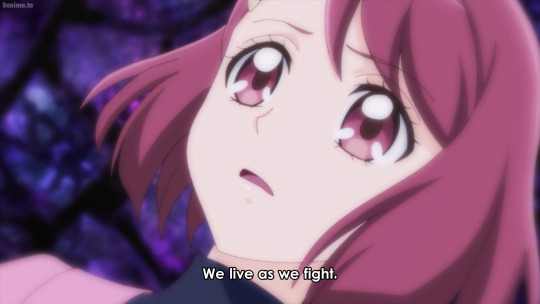
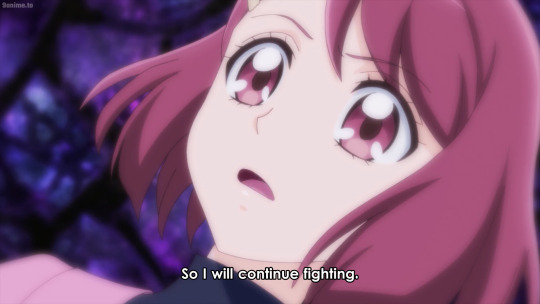
And it’s not hard to see why she’s earned such high regard in a lot of fans’ hearts.
The writers clearly worked a lot on her character composition to the point where she can pretty much embody the theme of “living is fighting” all on her own.
She came into HealPre fresh out of the hospital and full of earnest desire to make the most of her newfound freedom but she also wasn’t without knowledge on what hardship is. From there, she only got stronger, even when she was stumbling and trying to figure things out along the way. She grew more fortified in her beliefs on what it means to be truly live a healthy life.
She bravely defied the ones who attempted to take advantage of her and twist her cause against her. And she learned that taking care of herself is equally as important as wanting others to be safe from harm.
It was never about winning or coming out on top. It was about protecting a fundamental yet precious truth. That one thing any decent human being should never have to concede: the right to live well.
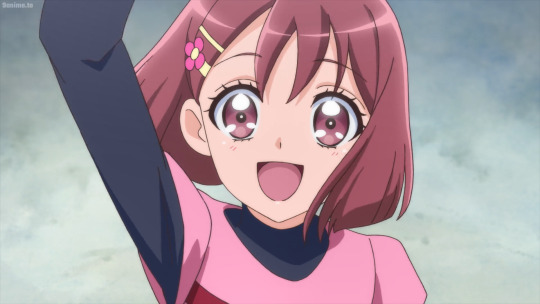
Honestly, Nodoka is absolutely inspiring all around, as a fictional character, a heroine and a normal everyday person.
Everything about her arc went satisfyingly right like it was meant to and the best thing is, we don’t need to question it because we saw how it all happened with our very own eyes.
I sincerely wished I could say the same for the others but sadly, they were just too flawed.
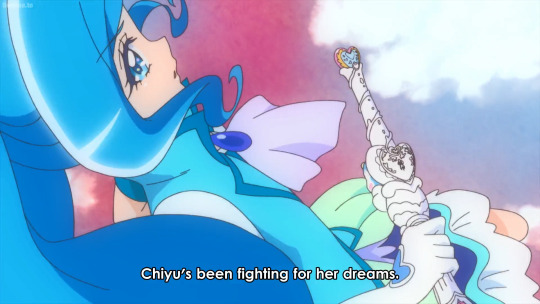

And Pegitan can throw flippers with me all day if he wants but as undeniable as the above statements are about Chiyu, her arc failed to leap over the increasingly mounting disappointment I had with every episode that’s been assigned solely to her.
Two of which weren’t even about Chiyu. One centered on Pegitan’s admiration for his partner and the other focused on her brother, Touji. Which, while nice to give to supporting/secondary characters, is a fat waste of valuable screentime and not what I’m here for.
It also didn’t help that the conflict of her arc (the indecision over choosing between two dreams) started really late in the game and was resolved so quickly within two episodes. There was no time for me to get invested into it, there was no powerful sense of conviction like how Go!Pri or Hugtto handled theirs and really, it just felt like Chiyu was only following what the script dictated for her rather than genuinely awakening to her own competitive passion towards track and field.
It was almost like it didn’t matter. Almost as if the writers procrastinated in thinking up something worthwhile to further her development...but then settled on grabbing an old idea off the shelf without refining it to suit Chiyu when they ran out of time.
This happened similarly with Minami in Go!Pri and Elena in StarPre, both of whom left me angry at how their arcs were executed. Yet theirs don’t compare to how pissed off I am about Chiyu’s. Because while Minami’s took a while to arrive, it wasn’t done poorly and linked back to Go!Pri’s theme well enough. And while Elena’s was over crammed last minute, at least it was unique to her character and had lots of potential ways to play out if they actually started it earlier on in StarPre.
Chiyu’s arc is like a discount version of the former with hardly any of the intriguing qualities of the latter. Sure, she had two early episodes that laid out the two most important aspects of her life (her family inn and her dedication to her sport) but after that, they weren’t brought up again until we were only weeks away from the ending. Y’know, just to fill up episode slots and meet the minimal requirement of saying they did give Chiyu some issue to resolve.
It was not engaging at all.
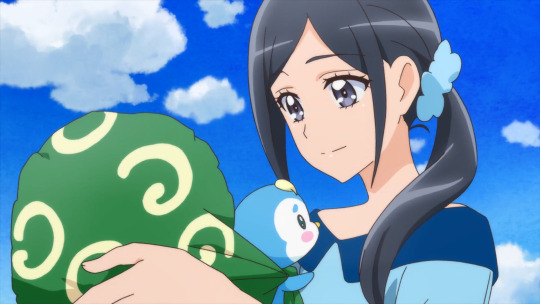
Furthermore, the fact that her arc had very little to no relation with either “health” or “nature” hurt my appreciation of her character somewhat. I just...don’t think her kind of story really matches with the central topics of HealPre?
...but maybe I’m being bitter about this all wrong and that’s screwing up my rational thinking on this matter.
Because Chiyu’s arc is valid under the logic of the overall theme, I would never say it isn’t. And again, character arcs don’t have to be close to the plot nor is it necessary to employ the “suffering builds character” method to make them interesting.
Chiyu always does her best every day. That’s sufficient argument on why her story does fit within the frame of HealPre’s premise.
Guess I’ll just have to wrangle my resistance into acceptance somehow.
...still, her arc could’ve been done so much better than what we were given. Chiyu at least deserved that much.
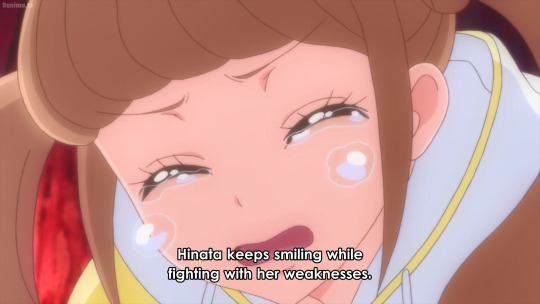
Next, Hinata.
Since the beginning, I knew she was gonna be runner-up to Nodoka for having the (for lack of better term atm) “best” arc because it was heavily implied that she has ADHD and therefore, immediately checked off the “health” trait. She was even more obvious about it than Nozomi was.
Difficulty paying attention, hyperactivity, impulsiveness. Hinata didn’t just display all those signs, she also showed how hard it was for her to deal with the downsides to them on a regular basis.
She kept apologizing and put herself down excessively for inconveniencing her friends even though they never blamed her for her condition. Got them annoyed a few times, yes, but didn’t stop them from staying friends with her and definitely didn’t make them hate her either.
Everybody was understanding of Hinata...except Hinata because she always took her failures to heart and considered quitting several times to avoid the crushing dejection of making mistakes over and over again.
She got better, though, and no one could have summed it up more heartwarmingly than Nyatoran with the encouraging words he gave her at the conclusion of her arc.
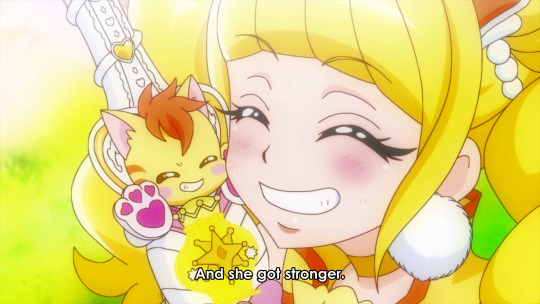
But it still feels like there’s a huge chunk of development missing between the start and finish. Or rather, it seemed like all of it occurred offscreen and we were only informed later that it did in fact, happen.
To recap, iirc, Hinata had around 5 episodes that focused on her (ep 9, 13, 23, 35 and 40). Ep 18 doesn’t count because that was a Nyatoran-centric filler more than anything.
Ep 9 and 13 did their jobs of introducing and highlighting the details of Hinata’s troubles while also suggesting she will eventually learn to overcome her insecurities. The ones after, though? They pushed those issues to the backseat.
In Ep 23, she had to share the (uneven) spotlight with Asumi. Hinata’s improvements were briefly mentioned but the majority of the ep went to teaching Asumi what “cute” meant and how to get along with puppies. I mean, I get that Asumi recently joined the group and bonding with her was mandatory by tradition. But since each Cure only gets a limited number of eps to herself, it would’ve been more beneficial for Hinata if she didn’t have to split screentime with someone else’s growth schedule.
Ep 35 is slightly better but not by a whole lot. Sure, Natasha was able to reconcile with Elizabeth which was very sweet and heck, it was the goal for that episode. But again, nothing was really done or addressed about Hinata’s main conflict. She tossed it back with the rest of her homework to deal with later. ahaha, a TroPre hint
Then ep 40 came to formally close the curtains on her story and apparently, Hinata screwed up lots of times since...whenever but she picked herself up every time after and kept on trying. Awesome. So WHY didn’t we get to see that?
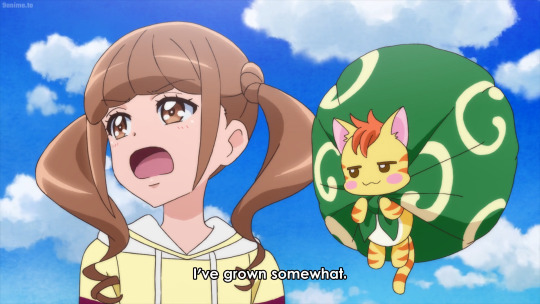
I’m not asking for the impossible here. I’m not asking for Hinata to be cured or anything miraculous like that. There is treatment available for ADHD but it is not curable.
Also, forcing Hinata to find a way to get better at studying, the thing she struggles with the most, is not the solution either because that would only make her more stressed and anxious over her own disorder.
What I want is to see how she moved from wailing “I can’t do it! I don’t wanna! I’m so scared of failing so why bother?!” to determinedly declaring “So what if I failed 1 or 100 times? So what if I fail another 1000 times? What matters is that I don’t let that stop me!”
That confidence is not something that can be built up overnight. It’s gradual and it takes numerous tries to reach from where Hinata was to where Hinata is now.
Telling me she grew emotionally stronger can only allow me to believe so much. I need to actually witness the changes as well.
If it weren’t for that, Hinata’s arc would have been a lot more impressive. Shame.

Finally............... Asumi.
Asumi, Asumi, Asumi, Asumi, Asumi, Asumi, Asumi... *sighs & drums fingers*
...she has no arc, ok? Seriously, what story is there to speak of, much less write a hefty analysis on?
A spirit born for the sake of Latte who just went along with the Precure ride because Latte didn’t want to abandon her duty. She made friends with those who aren’t Latte, extended her knowledge and understanding and gained valuable human experience during her stay on Earth. But ultimately, she will always define her entire existence around a puppy.
Nothing is more important than this puppy.
...... to be honest, Asumi not having a storyline isn’t what bothers me. It’s her lack of depth that does.
Hell, even the giant burger she ate had more depth than she did!
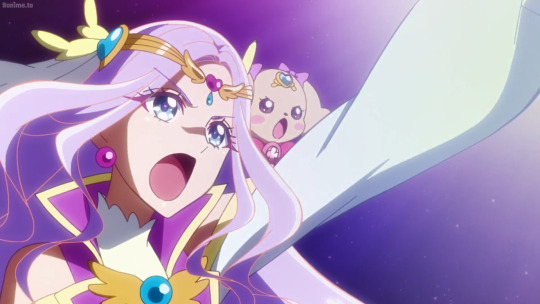
Oh, Asumi does have a personality alright. She’s consistently and unfailingly polite, utterly devoted to her raison d’être and in crucial moments, gives pearls of wisdom when the girls are in a pinch. She’s good.
But if that’s all she is, then she’s also painfully dull.
She has nothing to contribute to the discussion of health or nature, despite being created through an element of the Earth so you’d think she’d have an opinion of her own. At least worry about the planet that gave life to her as much as she frets over Latte all the time. But nope.
She shares the exact same face as Teatine’s past Precure partner so you’d think we’d explore that connection to see if it would influence or affect her in any way. But nope.
90% of the time, her role was just being Latte’s constant, fawning satellite.
Not only did that irritate the hell out of me but it just reinforced my stance that this type of character is one of the worst you can ever insert into any narrative.
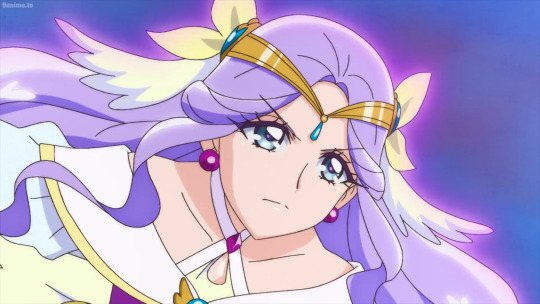
Because if someone keeps reiterating how much they’re obsessed with this one thing and seldom talks about anything else without bringing their obsession into it... then what’s so special about them on their own?
You’ve practically surrendered the different qualities you could have had for worship of something else. That’s not a fair trade-in.
Asumi’s character is so packed with Latte-related stuff that there’s not much space left for anything that can be considered uniquely Asumi.
I mean, maybe it’s because I can never see myself or any normal person comfortable with living like that.
Living for the sake of being together with the one you love? Okay. But living with your whole universe revolving around that one thing? Making most if not all decisions based on this one thing?
No. That’s absolutely crazy, alright? Nobody with a healthy amount of awareness and self-worth would live like that.

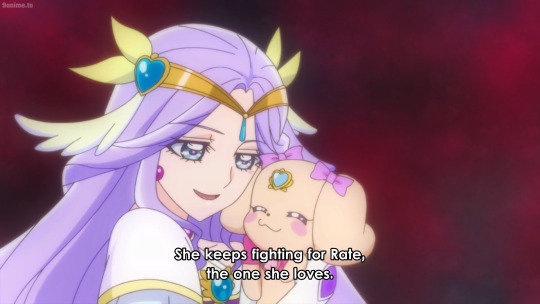
And you can counter that Asumi’s just born like that. That she can’t help her origins because Teatine’s wish to protect her daughter is essentially what brought Asumi into existence so of course, her biggest concern would be Latte. At least, she wasn’t forced into it, right? As long as Asumi chose of her own will to follow Latte, it should be fine, right?
You can even use the fact that Asumi isn’t human. That she’s a spirit and we shouldn’t apply our human standards too strictly to her.
Yea, but those are feeble defenses in the face of her being a good main character, a good main heroine.
There are many ways to make a decent MC. The way Asumi was written proves she certainly does not possess traits that can classify her as true protagonist material. A protagonist has to be more than one amplified feature, which Asumi is not.
For the record, I don’t hate Asumi (she’s not interesting enough to generate a feeling that intense). I'm just severely let down because even if I don’t end up loving the midseason Cure for whatever reason, I can usually count on them to bring something intriguing to the table to dissect and analyze. At least I should find something to care about them.
Didn’t happen with her. :(
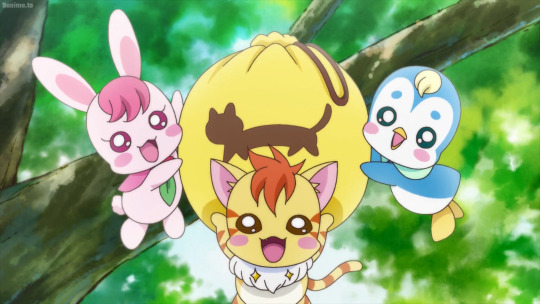
Oh god, I’ve been working on this post for days now and I’ve got a headache and with the baton pass happening in less than a few hours as I type this, I just really need to get it done and over with so please forgive me for speeding up through the rest, I’ll try to keep it as coherent as possible. NYARGH! (@_@ ;;)
Mascots.
Would you be surprised to hear that I’m not surprised that they were actually written very well?
Like I said early on, I suspected the return of fairy partnerships were going to improve the mascots’ significance in the story and, well, I was right.
This time, they didn’t just fill in the usual expectations of relaying exposition, serving as the Cures’ transformation devices and looking cute for the merchandise. The Healing Animals had to make progress on their own training to become doctors as well.
And they did through their relationships with their human partners.
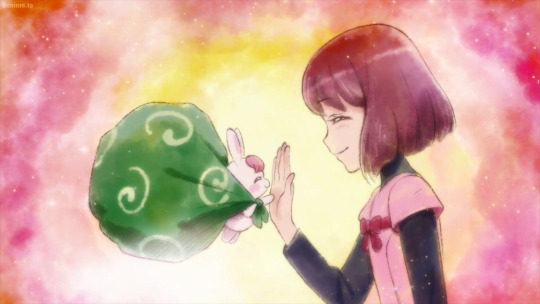
It was a refreshing take on the mascot aspect of the series because the friendships felt really symbiotic. When the trainees arrived on Earth, they relied on the girls to help them perform their jobs as well as provide them with shelter, food, the occasional peptalk about their trainee status, etc.
Then as the story continued and they got to know each other better, the mascots were able to return the favor by giving support when the Cures needed it. Rabirin when Nodoka was frightened and confused about how to deal with Daruizen, Pegitan when Chiyu was having trouble choosing between two dreams and Nyatoran who made sure to always lift Hinata’s spirits up when she got upset at herself.
In short, they achieved their objectives of learning what it means to be good doctors by being there for their friends! How wonderful! :D
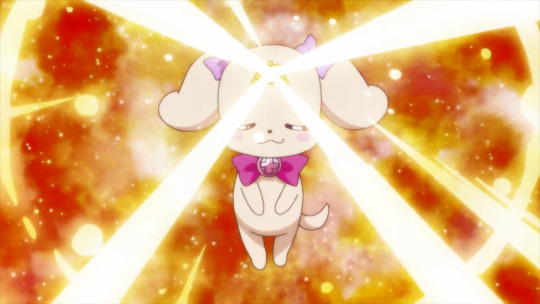
My memory for Latte is hazy, unfortunately, since she’s coddled by everyone all the time (can’t blame them, she’s friggin’ adorable! <3) but I’ll never forget how she stood firm on the battlefield to see things through, to fight for the Earth like she promised her mother. She started out so babie but showed us all there was enormous bravery behind her cute face and ugh, we should all be very proud of her! <3
The only major issues I had about the mascots were these:
1) Too many irrelevant fillers went to them. They only needed a maximum of two for their entire mascot group.
2) Latte kept getting sick even after she acquired a Precure partner of her own. I was hoping it wouldn’t hurt her as much as it did before Asumi arrived or that she would build up a stronger immunity but noooo, they insisted on torturing the poor pupper! T_T
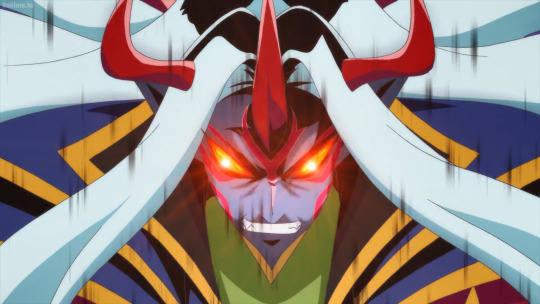
Villains + Finale Battle
Not a lot needs to be said for the first part. We’ve had mediocre antagonists before. HealPre’s just happened to be extra annoying as they were despicable.
Which is worse because jerks you can just leave in the trash but assholes won’t stop harassing you unless you pummel them into their graves, set fire to their corpses and leave no trace of them behind! >:(
Y’all know who I’m talking about. Opinions on him continue to vary depending on who you talk to and if they’re avid fans of his face or not but whatever. The son of a bitch served his purpose and is dead now. That’s all that matters to me.
Anyway, the King was flat like his two lesser generals. He was neither intimidating nor distinguished enough in the brand of evil to really make us think of him as a serious threat and because of that, it ended up making the boss fight look like any run of the mill boss fight.
I know, they tried so hard with all that shiny animation but it just didn’t have that glorious sense of vindication that previous seasons (or ep 42) gave and I blame it all on this Rumiko Takahashi reject.
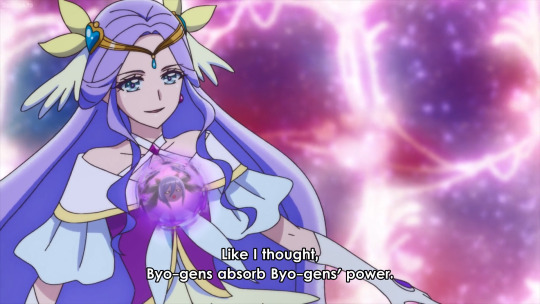
Also, this strategy was pretty useless?
They built it up like Earth was gonna sacrifice herself and die or something (she wouldn’t and even if she came close, deus ex machina would’ve kicked in to prevent that and COVID-induced caution too I guess).
But there were no signs of pain (well, that’s a relief) after absorbing Shindoi-ne and they really pissed King Byogen off more than they did any damage with the absorbed byo-gen power.
...so yea, this tactic was just to kill some time and budget, nothing more. Meh.
By the way, did Asumi eject Shindoi-ne’s pathogen out of her body yet or did they just leave it in there to bounce around until it eventually dissolves on its own?
Because that’s eww. I mean, it’s obviously not gonna hurt Asumi they can both relate on hyperfocusing their affection for someone so maybe the compatibility helps :P but still, ewwwww.
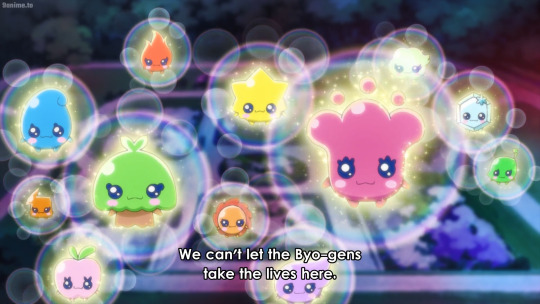
Fillers + Underused Motifs
In hindsight, perhaps HealPre didn’t exactly promise the content we I wanted about “health” and “nature” if their objective was to teach that any manner of “fighting” can count towards “living”.
......but fuck you Toei, you’re still cowards! >:/
Fillers will be fillers but it’s always better to try and make some of them as meaningful as possible. And they wasted the opportunity to inform an impressionable audience (during a very crucial period of our time, I must add) on a lot of things related to the HealPre’s motifs. Especially about the environment which for some ridiculous reason, they chose not to touch on for the main stretch of the overall story.
Proper hygiene, good diet plan and sleeping habits, regular exercise (already done by the girls a few times but could use another example), meditation, counseling/therapy (especially for mental health!), etc.
Real life pollution, climate change/global warming (IMPORTANT!!), deforestation, preservation vs conservation, endangered species, recycling, volunteering to clean up your community, etc.
These just came off the top of my head but yes, there’s more and no, I’m not saying that the writers need to cover all of them in extreme detail or replace the slice-of-life episodes.
But they should be able to mesh both serious and light-hearted together in harmony somehow. Like those fillers where the mascots saw people cleaning up littering at the park or that interaction with that arborist who taught them about wild animals and trees when the group went to visit a lake.
For health, maybe let the girls visit patients with chronic illness in the hospital or have them converse with a medical professional on some matter. Particularly if it’s got something to do with mental illness because stigma in Japan on those who are afflicted with such conditions is still prevalent and has caused a number of sad and shocking tragedies that could have otherwise been avoided if people didn’t have such outdated, judgmental mindsets.
That last part might be too dark for a children’s anime but there’s a lot more out there that is doable.
Do that without reducing it into a footnote, Toei. It is so necessary for your target audience to be aware of these issues at the age they are now. You have an almost 20-year old franchise to serve as a very effective platform. Make better use of it if you truly care about the message you’re conveying through your show!
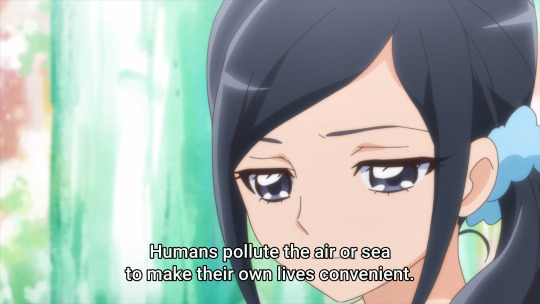
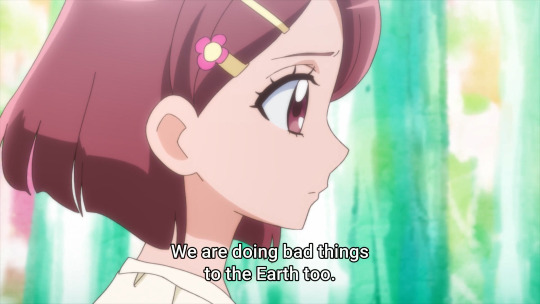
Also, what the fuck.
The last episode was a mess. Why are you only mentioning this now when the season is already over?
This should’ve been brought up months ago!
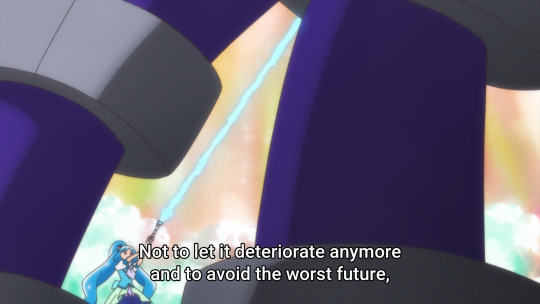

All the things we could’ve seen the Cures done to protect the Earth without magic.
The excuse of “I didn’t know humans were so horrible!” is a shit one because everybody knows humans are deplorable trash when it comes to abusing the Earth. All the more reason why you have to persistently drill it into people’s heads that they should not be like those who don’t care or choose not to care.
One crack episode isn’t going to cut that.
God, I so want to unsee this ep just so I don’t have to end HealPre on a more sour note than it already was. *big aggrieved sigh*
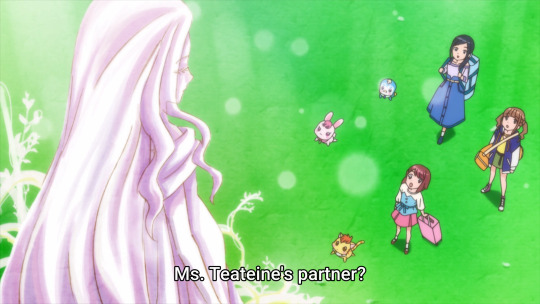
Lastly (and this really is the end of my long ranting, I promise), the missing undisclosed lore.
There are few Precure seasons without a past lore of its own in the recent years. Is it a wonder, though?
Lore is mysterious and fascinating. If it involves a past Precure, even more so.
Sometimes fans might just hang onto a show because they’re curious about what happened before the main story. We’d never get the full tale of those adventures but at least, it’s fun to imagine the “prequel”.
Also, past Precure are just badass. Fact.
Strangely enough, we didn’t get that for Heal. All we know is that she was called “Fuu” and was very close to Teatine.
Hmm. Probably one of those changes caused by COVID interference cuz I can’t imagine the writers choosing not to tell her past in the original draft.

With all that finally off my chest, I’m ready to part ways with you girls until the next All Stars (Nodoka, I’m gonna miss you so much! T_T)
HealPre wasn’t the worst and it was nowhere near the best that it had the potential to be. But it’s passable. At least for those who loved it even with its flaws, I’m genuinely glad it was good for you.
For those who are thinking about picking it up (although why you would read this spoilery post before watching, I have no idea), if you’re looking for a standard magical girl anime to enjoy casually, then this is a safe pick. If you really want to invest your attention and heart into it, though? Then perhaps it would be in your interest to ask someone who saw it already to help you filter out the episodes that are worth watching. You don’t need to worry about the rest, they’re inconsequential. :P
Ok then! Thanks for reading as always, brave souls who have reached this point.
Stay healthy and safe out there and I’ll see you at the beach next week! Tropic underwater paradise here we coooooommmmmeeeeee!!!!!!!!!!!! xDDD
#i rage quit two drafts and an outline before i got anywhere with this#now if you'll excuse me i gotta catch up on my workout and play pokemon and eat pho later#and catch up on the ccs manga#livin' the healthy life oh yea~#healin' good precure#cure grace#cure fontaine#cure sparkle#cure earth#hanadera nodoka#sawaizumi chiyu#hiramitsu hinata#fuurin asumi#rabirin#pegitan#nyatoran#latte
10 notes
·
View notes
Text
this summer, me and my brother watched four whole shows. at long last, here is my comprehensive review of all of them!
in the order we watched them, these shows were:
avatar the last airbender (ATLA)
mob psycho 100 (MP100)
demon slayer / kimetsu no yaiba (KNY)
fullmetal alchemist: brotherhood (FMAB)
they were all very very good!
i’m not going to try to rank them, but, as is probably obvious by the state of my blog, my favorite was FMAB :) if i had to pick a least favorite, then, it would probably be KNY—not by any fault of its own, but just because it didn’t appeal to me quite as much as the others. still a very good show!
i will review each show by:
giving a quick plot-based pitch discussing the show’s hook or appeal
discussing one element that i believe it does better than any other show on this list—in other words, a quality that i think it stands out for
discussing one element that didn’t appeal to me or that i had issues with—a criticism
putting forth my favorite character and favorite episode or arc, just for funsies
including various other commentary. mostly positive, as, again, i did really like all of these!
(i’ve tried to make this whole thing free of specific spoilers, but if you’re planning on watching any of these shows and want to go in more-or-less blind, it might be best not to read this.)
first of all, i’d just like to discuss all four of these shows as a whole! it was definitely interesting watching one after another and noting similarities between them.
all of them have siblings in them! which is, perhaps, fitting, as i watched them with my brother
two include a pair of siblings in which one has powers and one doesn’t (at least at first), and part of the narrative involves getting better at using those powers (ATLA, MP100)
two include a narrative centered around a pair of siblings and something tragic that happens to them, resulting in the older one being traumatized and forced to train to become a soldier, and the younger one turning into something (arguably) inhuman. the protagonist’s major goal is to return his younger sibling to the way they were before (KNY, FMAB)
ATLA and FMAB are both fantasy political dramas, which is rapidly becoming a favorite genre of mine
most of these are historical, or historically inspired in some way, which is interesting!
all of these shows are really really good at character building. all the main characters are interesting and complex, and the relationships between those characters are similarly nuanced and very well written. they make you really care about both the protagonists and the side characters!
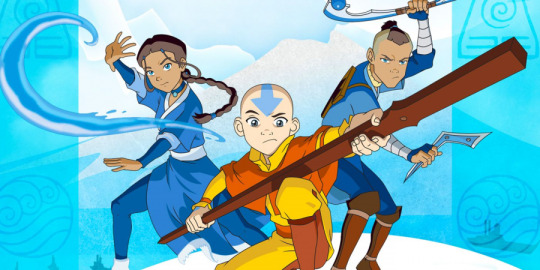
avatar: the last airbender
pitch: as the ever-growing imperial force of the fire nation threatens the earth and water nations, a kid from the long-lost air nation turns up and it turns out he can control all four elements and he has to save the world and all that. sorry i tried to write this pitch like five times and realized that well at this point i think everyone reading this will know the plot of avatar
stands out for: avatar has possibly the best worldbuilding i have ever seen in a show—it takes the time to introduce us to so many places and aspects of its world, both explicitly and subtly. the main highlight of this is the magic system. by creating a magic system based in body movement, the process of using magic and learning to use/control it better becomes immediately obvious to the viewer. combine that with the philosophy behind each type of bending and the way that characters take bending inspiration from types different than their own, and you’ve got a system that is complex, flexible, believable, internally consistent, and just plain fun! it makes action sequences a blast. i especially liked the moments when bending was stretched to its limits in totally logical ways (metalbending, bloodbending). not to mention the way that bending is seamlessly integrated into the world of avatar! the example that comes to mind is the earthbending-powered transport system of omashu. a whole essay could be written on that topic alone!
criticism: i know this is a sentiment shared by many people, but the first season was kind of boring to me. some of the humor and the plots felt hit-or-miss. of course, it needed to take that time to establish the world, and it does a great job of doing that. it just didn’t hook me until the second season.
favorite character: i love toph she’s so much fun :) iroh is a close second! and zuko is great, too, of course
favorite arc: i loved ba sing se a ton, especially the episode when they get there and everything feels off. it felt so resonant with real life, in a very fun way. there’s a reason “there is no war in ba sing se” is a meme…
other commentary: what can i say? it’s a classic for a damn good reason. the plot is tight, and it does a great job raising tension and introducing new elements and twists. i also love the care put into the antagonists, especially azula, who has a fascinating arc.

mob psycho 100
pitch: a middle schooler and a charismatic con artist team up to smite ghosts using extrasensory powers. thing is, only the middle schooler actually has ESP, and it happens to be really, really powerful. can he navigate the difficult world of middle school while also getting a better grip on his powers—and his bottled-up emotions?
stands out for: the way that MP100 uses animation is excellent. it takes a little getting used to but it’s just so fun, combining all sorts of different techniques to create an experience rich with drama and emotion. it’s playfully exaggerated and self-parodying, adding to the show’s fantastic sense of humor as well as its truly emotional moments.
criticism: the way that ESP works makes suspension of disbelief tricky. it’s a great feat to introduce a character who is essentially all-powerful and still make them interesting (even in fight scenes), but at times (especially the second season finale) it felt like a magic system with too much breadth and too few limitations. this might just be my bias for hard magic systems talking, though.
favorite character: other than mob and reigen? probably teru. he’s loads of fun AND all the season 1 episodes he’s in slap hard
favorite episode: the one where the girl asks mob out on a date as a dare.. it’s super cute
other commentary: thank you mp100 for being the leftist propaganda we all deserve <3
in all seriousness though, this show is a blast!! it does a great job switching between silly and serious in the blink of an eye. i also really appreciate the way that it balances comically huge stakes with much smaller, more personal stories. for example, the conflict between mob and reigen in season 2 is especially well-done. in general the emotions just feel so real? characters whose emotions tie into their powers are an excellent trope, and mob is a wonderful protagonist who exemplifies this really well.
finally, on a more critical note—there are so many characters in this show! and it feels like only a handful are fleshed out? however, this may be due to the fact that it’s not an adaptation of the entire manga (which i haven’t read). there’s a lot more to go! more characters to dive into! so i probably shouldn’t try to critique it in the same way as a finished work.
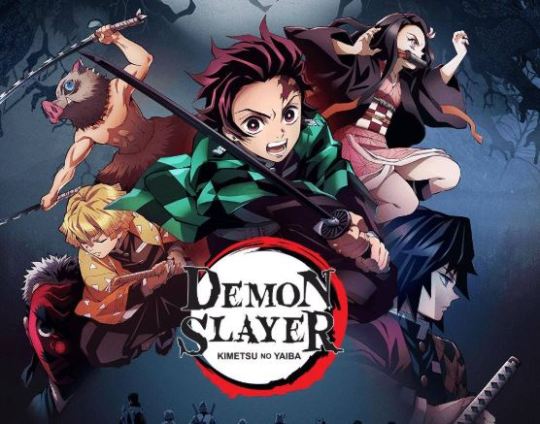
demon slayer / kimetsu no yaiba
pitch: demons kill a boy’s family and turn his sister into a demon, so he decides to try and figure out a way to turn his sister back into a human. what follows is a demon-killing adventure that’s in equal parts harrowing, poignant, and hilarious.
stands out for: there’s not much i can say about this other than “please just take a look” but the art and design is phenomenal. it does a much better job of integrating 2D and 3D than a lot of other animated series, and overall it is just so so pretty! all the character designs are complex, memorable, and fit the characters perfectly. the color choices are interesting and satisfying. i also really like the sound design? not often that i notice that in a show. i’ve watched so many KNY amvs by now lol it’s just amazing animation
criticism: the narration style leans too heavily towards tell instead of show. this is mostly an issue with the first few episodes, but i got super annoyed by how much the show would narrate every single one of tanjirou’s thoughts instead of letting us infer those thoughts through his actions and reactions—the latter, i think, would have been more emotionally impactful. sometimes silence speaks louder than words! tanjirou was also not the world’s most compelling protagonist in my opinion, though i think that mostly has to do with my own tastes.
favorite character: *holds up zenitsu* I Just Think He’s Neat. i actually kind of lost it when he first used his powers, like… damn i love characters with weird relationships with their magic like that. i also think the narrative about how having a solid foundation is sometimes more important than knowing a ton of different moves was really powerful. and he’s just funny! pathetic boy i love him
favorite arc: really just the whole spider arc. fucked up man… i love it. they pulled off that last twist so well, and all the family stuff was so weird and complex and emotional…
other commentary: it’s just a really solid and very well-written show! the team of tanjirou, zenitsu, and inosuke is so much fun… bro bonding :) i also quite like the horror elements; it’s fucked up but in a good way. finally, this is very specific, but the demon that can alter buildings/rooms through drumbeats? appealed to me very much. it’s a cool and unique power!

fullmetal alchemist: brotherhood
pitch: two kids do some fucked up alchemy and end up getting parts of their body stolen by god. now they’re on a quest to get their bodies back, but find themselves wrapped up in crazy government conspiracies and alchemy more powerful than they ever could’ve imagined…
stands out for: plot. by this i mean less overall concept (though the overall concept is pretty great too), and more that the pacing and progression of the story is extraordinarily tight. for the most part (the first few episodes are a little weak but i’ll let it slide), it does an excellent job establishing its premise and building on it logically, adding layers and layers that extend naturally from what we already know. everything has a reason for happening; everything is revealed in good time and all the twists are super satisfying. there’s great balance between exciting moments and quiet moments. it’s just very good at being a story!
(fun fact: i’m reading the manga right now and so far it’s even better paced than the show, which is super interesting! it’s especially good at how it lays out pieces of the backstory and then fills everything in later in a really satisfying way.)
criticism: this is incredibly specific but it’s what comes to mind as something that bothered me: winry’s character arc was really disappointing. for most of the series she’s a pretty strong character, but in the end it feels like she gets pushed aside, defined only by her relationship with ed. what happened to her wanting to take action more? that was a specific desire she expressed—wanting to be less passive! since she’s such an important character, i wish she could have had more presence in the last season other than as a sounding board for the elric bros’ emotions. (even though her one scene in the last episode was really good and emotional…)
favorite character: other than the elric bros, absolutely ling. he fits into multiple of my favorite character archetypes (fun, silly, bastard, gets possessed…) and he’s just overall a delight. plus his relationship with greed is really really good. bro bonding at its peak!! (my other favorite is pride. i will not say why because spoilers. but if you know me.. you know)
favorite episode: this is really really hard to choose but i’m gonna go with envy’s death because. holy shit.
other commentary: i’m a really big fan of the complex and nuanced way in which FMAB breaks down militaristic, imperial regimes from the inside. many of the characters have done awful things, and the story forces them to grapple with that and accept that all they can do now is be better in the future. the moral complexity is just really good! characters with flaws—we love to see it!
finally, parts of this story seem so so catered to Me Specifically that it’s no wonder i got so into it. like just the entire premise? the way that so much of the conflict is built out of identity crisis and exploring the nature of consciousness and human vs inhuman? beautiful. i love ed and al so much
*
if you made it all the way to the end, thank you so much for reading!! glad to have finally gotten this done (3 months late…) and put all my thoughts down. i hope this inspires someone to try watching one of the shows i discussed!
#avatar the last airbender#mob psycho 100#kimetsu no yaiba#fullmetal alchemist#my post#long post#then for my own tagging purposes..#atla#mp100#kny#fmab#i really hope some people read this! i put a lot of thought into it
14 notes
·
View notes
Note
abby can you talk on how deancas and tenrose are the same?
okay so i need to preface this with the usual…. cannot believe i am enlightened enough to be seriously discussing this in the year 2020, but i’m happy for my teen self. also there is about to be a lot of unhinged earnestness to follow, so if you’re easily succebtable to cringe… don’t read on. ALSO RIP I WROTE 1800 WORDS about just the most general and nonspecific concepts…… brb k wording myself
first off i think it’s so funny that i just went back and looked and i typed cas/ten as a one and dean/rose as a six completely independently so… that’s where my head is at.
i think the meat of the issue is the way that tenrose and deancas function both in relation to the overall narrative and each other. there are many differences of course, but at the end of the day, both relationships are positioned as the ultimate working example of what their shows are trying to be About.
i could write an entirely separate essay on the intersections between cas and the doctor, but essentially…… these are figures introduced to the audience as Beyond Human Understanding. they exist as celestial beings unconstrained by the rules of space and time, more closely connected to god than humanity. we meet the doctor farther along in his journey than castiel, but both of their character arcs are rooted in a Godlike Creature observing humanity and becoming enamored with it/driven to protect and care for it. by the time the doctor meets rose, it is well established that he has a soft spot for humanity, she’s not the one who teaches him that. but she is the one he reaches out to and leans on for support and healing post-time war, and she is the one who influences ten’s regeneration so deeply that he is made in her image/for her. castiel rebuilds dean atom by atom is hell, and upon rescuing him from the pit, finds himself similarly irrevocably altered. it is revealed to us that castiel also has had a long affection for humanity, but nothing swayed him from his ultimate duty before he met dean. and just as the doctor finds himself with a family for the first time after gallifrey with rose and her mother on the estate, castiel finds himself cut off from his family/realm, but with a new family, team free will. they lose everything, their attachment to the heavens, and find a new family and a new reason to continue, in these humans.
dean and rose also are the ultimate Human Credentials. we all know this term to be indicative of someone who confers humanity onto the other, someone who, by mere accompaniment, allows their beloved to more safely/easily navigate life. and it’s true in this sense. rose is constantly reminding ten how to Be Human (”am i being rude?”) in both big and small ways, just as dean more or less badgers castiel in the same way ( “dude. we talked about this”). neither cas nor ten would be as intimately connected with their “human sides” with their partners. but dean and rose are also Human Credentials in a broader sense, in that….. they act as character references for the rest of humanity, and by virtue of their own selves/their partner’s attachment to them, guarantee investment in the rest of the human race. castiel is more-or-less content to watch from heaven and take orders until he rescues dean and becomes involved with his life (”the moment castiel laid a hand on you in hell he was lost”). his love and affection for dean and his willingness to bend everything to keep him safe means that castiel learns to defy heaven for the good of humanity. ten has always loved humans, but he loves rose a little differently. The Doctor Needs Someone, and we see rose’s power as his human credential most strongly when she’s gone. Without rose, ten is more willing to put himself/others in danger, to make choices that will result in death, to be callous and reckless and thoughtless. rose’s presence is a constant reminder that humanity is Worth the Trouble, that he’s never met anyone who wasn’t important.
for rose and dean…. these are two, completely Normal, Average People. or so they think anyways. the burdens they carry and their inner lives are very different, but in very simple ways, they both would’ve continued their lives believing there was nothing special about them, getting up to Do Their Duty, never asking for anything special. both view themselves are caretakers, although this manifests differently bc rose is a bratty 19 year old and dean never got the opportunity to be a teenager. but both Feel Deeply in ways/levels that others don’t. each has an extremely open heart and a need to protect/provide for the little people. what ten and cas give them is an entirely new perspective, whereupon it starts to be possible to believe that even the smallest person can affect the world for better, and that they, specifically Deserve More.
THEN we have the ideas of religion/free will/fate that intertwine both shows. rtd’s doctor who was explicitly and obviously written with the intent to show an atheist universe where the human spirit and mind are enough on their own to be holy, to determine right and wrong, and to decide the events of the universe. obviously ten is often situated in christ-like positions, but he learns from humanity as much as they teach him. supernatural is a little more complicated, with an alternate vision of accepted figures of christianity, but both shows heavily emphasize the power of human kindness, passion, empathy, and individual choice. ten may not live within the confines of space and time, but apocalypses in doctor who often hinge on one small person doing The Next Right Thing, just as supernatural’s base credo is We’re Writing a New Chapter. castiel bursts onto the scene and is literally taught the importance of free will by dean, and perhaps even the importance of his own desires/needs by dean. both core relationships exemplify what it means to make choices outside the realm of fate (even whilst allowing for the existence of soulmates). yes, castiel was ordered to raise dean from perdition, but their human connection is what allows the winchesters to subvert God and move outside the printed narrative - love for a human is what makes an angel CHOOSE to fall from heaven. and ten…. well ten knows that rose is going to die. ten understands from the moment he allows himself to care for her above all others, that he is dooming himself to pain and regret and loss. but he decides to do it anyways, because isn’t the best thing an otherwordly being in love with humanity can do is to eperience love and loss on a human level? both cas and ten understand that there is no love without pain, that they will be the ones to watch their beloveds leave them, but that the Choice to love out of free will is worth it.
there’s also the element of Expression/Repression. here is where the underlying emotion remains similar but the freedom of how exactly to illustrate these feelings could not be more different. tenrose is a heterosexual relationship at the end of the day, and their storylines require them to be alone in each other’s presence nearly 100% of the time. thus, we get LOTS of familiar touching, lots of body language and casual intimacy and teasing. dean and cas…. lol. not so much. instead of physicality, we get looks, both because of dean’s own upbringing/sexuality and because they exist on the show that they do. deancas deals in the unspoken - the acts of service, the grace healings, the tense moments of battle, the lack of personal space. the expression is different, but the emotion is the same. ten and dean hold themselves back from the more Obvious open-book partners, for their own personal reasons. the end effect being that everyone on screen understands/insinuates what’s happening, and their relationship is so thick with subtext its a wonder no one suffocates. Words are seen as the ultimate step, once which cannot be overcome in normal life. both pairs use death/separation as the final step towards full transparency, but even then we are never granted the ultimate catharsis of an I Love You. castiel couches his confessions in generalizations towards groups, and dean swallows his truth even in prayer. rose says the words through a veil of uncrossable distance, but she doesn’t get to hear them back. they can Know, and we can Understand, but we cannot hear it.
lastly (for now)…. and perhaps as an ultimate summation…….. death and parallel universes and fate cannot stop them, those who are drawn to each other through heaven and hell, through time and realities. it is to be understood that will all four individuals fight to ensure that each human being is safe, protected, and able to make their own choices they are soulmates. they are soulmates who are bound to each other to be sure, but they’re not Fated in a way that takes away their free will. they’re fated by the series of choices they make, over and over again, to prioritize each other, to traverse time and space and dimension and hell to get back to one another. god cannot see castiel in his plans for the world, and yet castiel has evaded death again and again, to give dean a win. nothing could tear rose away from her doctor, and even while trapped in another dimmension, she hears his voice, she runs to him, and she finds a way to get back to him. each and every choice they make brings them back to one another, regardless of the ultimate ending. we don’t know yet if we will ever hear castiel and dean get their doomsday moment, but we do know that in order for castiel to leave dean’s side, an entirely new dimmension (the empty) will have to be in play to keep them apart.
ultimately, castiel and ten are both celestial beings with self-worth issues but a burning and true desire to see humanity thrive, directly and indirectly because of their attachment to dean and rose. dean and rose make castiel and ten more human, all while exemplifying why human is a good thing to be. dean and rose become more themselves under cas and ten’s influence, both are given more opportunity to bloom into who they are meant to be. all four become More in the presence of each other, and save the world while doing it. ultimately there is a heavy dose of tragedy in both - whether or not dean and cas get their moment is yet to be seen, but these are still Soulmates with differing relationships to mortality. but is there anything sweeter than defying god’s and fate and our own doubts to grab love with both hands, even when we know there will be pain?
#JESUS MOTHERFUCKING CHRIST#the way i could write an additional 2k words on any one of these sections/elements#anyways happy high holy day#deancas#tenrose#dw#spn#meta#Anonymous#LMAOOOOOO
46 notes
·
View notes
Text
After having willingly given the last month of my life over to MDZS and it’s Live Action counterpart I wanted to compile a list of my favorite aspects of both (including spoilers). Both the original Chinese Novel and it’s stunning 2019 Summer Release counterpart are breathtaking in different manners, but if you are looking for a quick recommendation, I do recommend going for the drama first as it will simplify the further consumption of content if you decide you want to partake in more.
What I love about THE UNTAMED:
The symbolism of the cliff at Nightless City, and how that entire scene marks a clear shift in Wuxian’s mental state as well as the overarching story. Similarly, how in the end it is Wuxian who throws himself off that precipice to sure death. This detail provides a direct comparison between his mental state at this moments and Cheng’s after his core was squashed, while also touching on an unique level of disparity and regret that is unrealized in the novel at this point (considering how this isn’t how Wuxian dies in the written version)
Xiao Zhan and Wang Yibo. I’ve made posts about this already so I’ll spare you another essay (Here and Here)
Jiang Cheng’s entire character arc. Seeing him fully fleshed out, utilized, and properly human within the drama made it hard for me to swallow how shallow he often felt on paper, especially in the early chapters. I get that this is partially due to the youth sequences in the book being written completely from Wuxian’s POV, but for me there is something incredibly human and genuine just lacking from the version of Cheng on paper that stood out so gorgeously for me in terms of his drama counterpart. Wang Zhou Cheng did an amazing job bringing out his raw emotion and anger on screen, lines were delivered in a manner that truly solidified this characters growth and vulnerability to me. For such a new actor within his field he did a brilliant job, and is the reason I have so many damn emotions concerning Jiang Cheng’s character arc. (I have a million analysis pieces typed up on my blog if that interests you)
The sequential order for the flashbacks was incredibly easy to consume. It helped to keep events and motivations clear. I understand why the book was able to skip around in a more winding mysterious manner, but from a drama standpoint I massively appreciated being able to consume the events leading up to Wuxian’s demise in consecutive order. The first few episodes were initially extremely confusing to me as a new watcher, and it’s only when the flashbacks hit that the plot-line solidified as well.
The female leads! Yanli, Qing, and Mianmian having larger roles and development was absolutely a plus. Everyone had the same intentions and feel as they did in the original, just more fully fleshed out since they were given time to interact within the world. As a bonus note seeing Madam Yu and hearing her bullshit on screen, said out-loud in the bitchy tone her actress gave her, made her 10X worse and from an antagonist perspective I massively appreciate that they were able to make me despise her so damn much.
Everyone important to the past storyline being involved in the Gusulan Study Sessions under Lan Qiren. This was a simple and effective manner of introducing everyone and having characters feel involved and interactive from the get-go. I was honestly a little disappointed that not everyone was included when I went on to read the novel.
Ning and Wuxian’s interactions early on. Their dynamic in the show was given life, and felt genuine in how it shifted over the course of Wuxian’s trails and misfortune. I love how they included Ning in the early on portions of the series, especially the Caiyi Town waterborn abyss debacle where Wuxian saved his life. It just added more layers to an already intriguing dynamic that plays a massive role overall.
The wolf torture scene. This added a whole new layer to Wuxian’s fear of dogs, while still completing its job of giving Ning and Wuxian a reason to interact and grow. Not to mention the example of Wen Sect Torture Tactics really added to the inhumanity of the sect while sparking our main character’s growth and self-sacrificing nature.
The symbolism behind Yanli’s and Cheng’s dreams. These dream sequences give a glimpse into the heads of two complex character’s and honestly added so much background motivation to their storylines. I loved these details and how much analysis us all as viewers can put into them.
The rain scene. Wuxian telling Wangji he would prefer to die by his hands. The first tears watchers see from an incredibly strong and willful young man who has always appeared stoic. (I cannot express to you enough how sad I was that this scene didn’t take place in the novel)
Wuxian’s mask. I understand logistically why they had to do this from a filming perspective (I mean if you have someone as good looking and Xiao Zhan, damnit you are going to let him look like him as much as you can) but I honestly really enjoyed the smaller details they included to make it work plot-wise. I also appreciate how it was designed as a prop considering it actually altered Wuxian’s features in a manner that made him harder to recognize due to its bulky and carved nature.
The secret underground cave in Cloud Recess under the bathing pool. The whole meeting between Wangxian and the female sect leader. I enjoyed this detail and how they expanded upon it when it came to the burning of their sect home and the survival of their people.
Wangxian’s relationship. Their subtle, trusting, gentle way of showing love. On an additional note I appreciate how it never once felt like I needed to discuss consent with the characters (coughNOVELcough) because everything between them was healthy and playful.
The soundtrack, costuming, and bts. I understand that this was a low budget production (compared to the majority of traditional dramas) and honestly I appreciate what we were given taking that into account. They stayed true to the essence and message of the story. I love the manner in which the costumes became a part of the characters and everyone had a clear style. The soundtrack flowed amazingly well with the scene and tone shifts (this is disregarding how fake their instrument playing looked because I’m still not over how off the finger movements appeared at points). The behind the scenes content on its own could win an award - it made completing the show a million times more satisfying because I do believe that the people working on set had fun (somehow even while filming during the hottest time of the year)
The name of the drama. When you reach that moment when you understand why it is called such - it’s a tale of the rise and fall of Wuxian.
The ending scene. I know it’s not the ‘stereotypical happy ending’ fans wanted, but it perfectly fit the tone and message of the piece as a whole. I love the ending. It felt right.
What I love about MDZS (NOVEL):
The Yi City Arc. It’s worth reading for this part alone. Motivations, logic, and everything just hit so much harder. I do appreciate what the drama gave us, but like, once you’ve tasted this version it’s really hard to go back.
Empathy. In general seeing Wuxian use empathy within the novel just works so much smoother. His little anecdotes and analysis while in stasis reliving ghost’s lives gives it a realism that it’s lacking on camera.
Second Siege of the Burial Mounds. The way the novel sets up this part and actually makes it feel scary with hoard mentality makes it work so much better. It feels like there is a weight to this moment. The waves of corpses are terrifying, and the exhaustion of fighting for hours gives it a level of humanity that makes what Wuxian and Wangji selflessly do stand out even more. Not to mention, the leftovers of the Wen Sect fucked me up. I bawled. This is another detail that I would legitimately read the entire novel over for just to experience.
Wuxian being fucking terrifying at points. Playing with demonic energy and losing control is supposed to be scary. In the novel it honestly felt that way. Seeing him slowly get worse was heartbreaking. Watching how people’s opinions on him skewed, and how he dealt with looks, pressure, and weight on his shoulders, took this arc to a whole new level. The way demons and ghosts flocked to and around him in public added a level of horror that was unsettling and necessary.
Wuxian actually losing control. In the drama they added another flute player to sort of work around Wuxian having to accept the result of his failure. In the novel, there is no such thing - and I love it. It’s another dowsing to the pain and suffering Wuxian has to accept and learn to overcome. It makes him coming back a decade later - to live and achieve and get revenge - feel different.
Action scenes and gore. If something is called “The Grandmaster of Demonic Cultivation” you expect some blood, and damn do I appreciate that the author made stuff have impact. I wish the drama had a bigger budget so they could have done the wounds and cgi more justice.
Wangji rescuing Wuxian after the first raid on yiling, and choosing to suffer together, hated by the world, rather than lose the love of his life. I love the use of the cliff in the drama, especially the imagery of Wangji trying to hold Wei Ying up before ultimately falling, but the route the author took in the novel is so much fucking worse. Like I cannot even imagine the pain Wangji went through.
Lan Xichen opening Wuxian’s oblivious eyes. Best brother ever. This entire scene, leading up to the final battle, is like downing a shot and waiting for it to hit. It deserves a standing ovation.
The details in the Xuanyu of Slaughter cave sequence. Every little tell that Wangji gave - he really did fall in love young.
Mingjue’s corpse. The separated limbs, angry spirit, holding bags, and everything made sense because of description.
Wangji explaining how he got the brand mark over his heart. All of his scars. Fuck. There’s inferring, and then there is having it described to you from the person directly and feeling as your own heart dies.
Lan Zhan’s insane arm strength. This is a detail that deserves recognition.
Wuxian’s inner analysis of Nei Huaisang at the end. This was fully formed and actually had some payoff.
The clear comparisons between Mengyao’s fate and what happened to Wuxian himself. Once again you can infer in the drama, but having it clearly implied in the book hits different because when someone becomes a public pariah it’s easier to go with the public outcry than try and defend them. “Nobody knew with more clarity than Wei WuXian that nobody would care and nobody would believe”
Ning protecting Jin Ling and Jiang Cheng in a manner directly parallel to how he killed the people they cared for.
Jin Ling’s realization about being unable to hate anyone in the end. You feel for this kid. You want to see him grow up well.
The beginning set up chapter. Hearing what happened in the past vaguely through spreading rumors and small talk without seeing it for yourself adds a level of intrigue. It has greater mystery than just seeing the scene play-out and cutting away.
Everything making sense in general with no plot holes. It’s one of those things where in television no matter how well you do, you can’t possibly include all the needed details. With the drama you have to infer a lot, and sometimes you will get it wrong. In the novel it really is just much easier to make sense of. This also included the pacing as well. Timeskips make sense.
Kissing. Smut. Damn, it’s so nice to have actual payoff for the slow burn.
#mdzs#mo dao zu shi#the untamed#wei wuxian#cql#the grandmaster of demonic cultivation#mo dao zu shi spoilers#mdzs spoilers#mdzs reaction#mdzs novel#my thoughts#little scene analysis#I love them both for different reasons idk#jiang cheng#lan zhan#wen ning#jiang yanli#the untamed netflix#reupload because tumblr messed up my tags#sorry if this is long the read more button wouldnt work#i wrote this for myself cuz im a sucker for lists
156 notes
·
View notes
Text
Dostoyevsky’s Psychological Ability

A bit of wild (very, very hypothetical) theorizing here.
So, with the reveal of Sigma’s... amnesia, we can presume that he was either created by the book (Fyodor bringing his OC to life, which seems very Fyodor) or that he was a normal person (somewhat similar to Chuuya’s mysterious origin before becoming Arahabaki’s host) completely modified by... something. The book, or Fyodor.
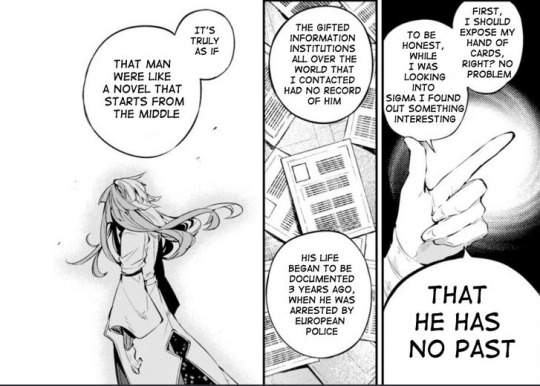
I’m going to run with the latter because it’s more interesting to me, and because it parallels Sigma with Goncharov (and they already have a somewhat similar mindset, as pointed out by my friend @trashyhumanespresso). It seems likely that Fyodor’s ability is something that somehow targets human brains, which fits on a meta level with Fyodor’s namesake, with his foils, and with his strategies.
Thus far in the story, we've seen Fyodor get Ace to hang himself:

Kill a kid by touching his head:
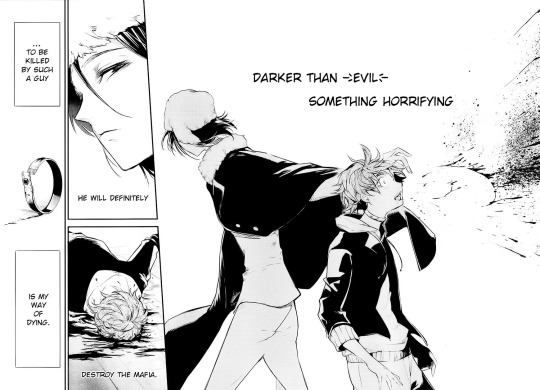
Get rid of the part of Goncharov's brain that feels sadness:

Explode a police officer's skull:

And now, he might have completely altered Sigma’s memories (I’m totally aware he very well might have used the book to do this but. It’s more interesting to me if the book is not involved lol so that’s what I’m running with but, who knows, either could be the case).
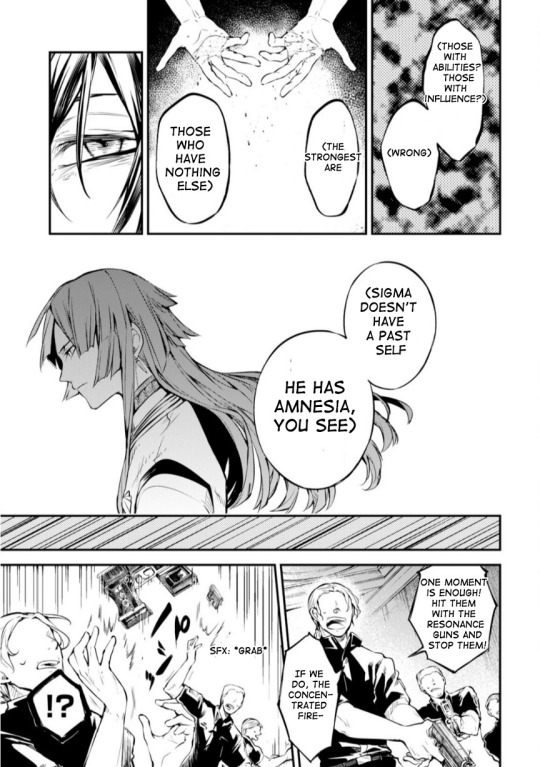
We don’t know how Fyodor’s ability precisely works--whether he manipulates their brains/exploits already-present weaknesses/targets certain parts of the brain--but it definitely involves Fyodor having to touch someone. Which brings to mind his foil also emphasized this chapter (see here for a great meta on Fyodor and Dazai’s foiling by @linkspooky): Dazai, whose ability also requires him to touch someone to enact it.

Fyodor’s match with Dazai is fascinating, as he cannot manipulate nor harm him thanks to Dazai’s No Longer Human instantly nullifying his ability. It also carries symbolic weight: while Dazai’s touch removes a person’s ability, keeping him isolated, Fyodor’s likely literally seems to bring death, which is symbolic of the nihilism he drowns himself in and that Dazai, thanks to Odasaku and his work at the AMA, resists even against his instincts towards it. Dazai is the one character Fyodor is not able to rattle, which means he’s likely key to stopping Fyodor.
In real life, Fyodor Dostoyevsky was a psychologist before Freud even wrote his theories, and he’s still held up as one of the most psychological writers in all of literature. Nietszche referred to Dostoyevsky as “the only psychologist from whom I had something to learn” (ohhh snap Freud) in Twilight of the Idols. Dostoyevsky’s works constantly explore humanity’s psychology at an individual and societal level, and are frequented with references to madness/mental illness as well.
Similarly, Fyodor is targeting the ability-users as individuals and also the larger society surrounding them. For society, he’s particularly aiming to dismantle the three-part agreement Natsume arranged between the Port Mafia, Armed Detective Agency, and the government. First the cannibalism plot pitted the mafia and the AMA against each other, and they were only able to solve it by working together. Now the government is set against the AMA via framing the AMA for that official’s murder, the mafia saves the AMA but at the cost of influencing more conflict over Mori lying about Fukuzawa’s agreement that he can take Yosano, and the mafia itself is now dealing with Tachihara’s betrayal and Gin’s injury (she is not dead), and now the AMA wants to ally with the Hunting Dogs but I doubt that’ll go super smoothly.
As for individuals, I’ll discuss Dazai more in a moment, but: Fyodor’s ability also has potential to foil another character given a fair amount of focus this arc: Yosano. His ability brings death, and her ability brings life even from already-existing pain, which it amplifies but results in them healing, which is symbolic of BSD’s overall message on life: it hurts, it can almost kill you, but it’s still healing in some ways. It is also symbolized by the butterflies associated with her, as butterflies symbolize rebirth, and as @aspoonofsugar has theorized, she also may not actually need to have them so close to death before healing them. (“Thou Shalt Not Die” is named after a poem Yosano Akiko wrote to express her pacifistic beliefs, after all, which seems interesting given that she has to hurt people to heal them.) Anyways, this would also explain Fyodor’s manipulation of the Hunting Dogs and the Port Mafia (as I’d be surprised if he didn’t know about Yosano’s past with Mori) to target her psychologically.
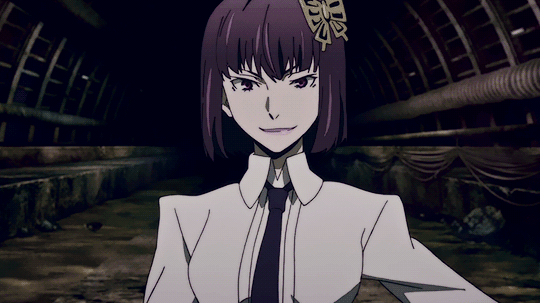
As for individuals, obviously Fyodor is going to target Dazai somehow at some point in an attempt to defeat him. He already surreptitiously is, through the Hunting Dogs dynamic and Tachihara’s betrayal (I doubt he didn’t know) which led to Gin being stabbed, which affects Akutagawa and thereby Dazai.
All of this brings to mind the intense parallels with Dazai/Fyodor and Mimic/Odasaku, in which all the leader of Mimic wanted was to die facing his own abilities in Odasaku and caused chaos to get it--particularly through targeting orphans under his care. Given that every arc thus far has ended in some kind of Shin Soukoku fight, plus given what happened to Gin and his promise to Atsushi, Akutagawa and Atsushi are particularly at risk here. However, they aren’t helpless, and Dazai surely plans for them to take Fyodor down--and they will, in the end.
#bsd meta#bungou stray dogs#dazai osamu#Fyodor Dostoyevsky#atsushi nakajima#akutagawa ryunosuke#gin akutagawa#yosano akiko#bsd theory#bsd 74.5#sigma
437 notes
·
View notes
Note
I know you mentioned that Bill wasn't included in ILM because you didn't know much about his personality. Out of curiosity though, if you had included him in the fic, how would you have integrated his history of being in the middle of a zombie apocalypse that couldn't have happened for the other characters? Or like, what approach would you have gone with?
Oh this is kind of a tough one! I don’t know Bill well, because I haven’t played Left 4 Dead, but that actually wasn’t why he isn’t in the fic. I stopped including survivors after Jane Romero, because DbD updates so much that I hit a point it was either add more characters but know you won’t have time to develop them and give them the character arcs they deserve because you’re nearing the end, or stop adding people, and it’s always better to whole-ass less then half-ass more—especially with characters that are awesome and really deserve some due diligence. While Bill is actually one of the earliest survivors released for DbD (he was...siiixth or something? Like right after Ace? Or Nea?), that’s only for PC. On PS4 and Xbox, he wasn’t added until much later, and I play DbD on PS4. So, for me as a player, Bill wasn’t actually released until after Ash was. When I started writing, I was kind of vaguely aware he existed on PC? But I had 0 personal experience with him, and so I went with my own/console experience when it came to writing.
As for what I’d have done, that’s a dang good question, and I’m not entirely sure— I’d definitely have thought about it longer if I had included him, but I’ll give you what I think I would have done? Obviously, Bill’s not from the world the rest of the survivors are. While almost any of the stories can coexist with minimal changes (NOES 2010, Halloween, Stranger Things, even Ash are more or less fairly easily compatible), zombie apocalypse—couple things I know they’re bound to notice, ya know? Still, I stand by multiverse being both unnecessary and not the best decision for the story I want to tell, so what I think I’d have done is this: (under the cut bc it’s gonna be long af--get ready for some quantum theory lol)
Okay, so the Entity canonically can operate outside of natural time. Meaning it can take survivors from earlier or later, and isn’t on the same space-time fixed relationship the world is. Now, time travel is tricky. Or anything with a complex portrayal of time. But there are three basic setups for time travel potential that actually make sense. They are as follows:
Anything that will happen, has happened (or the Artemis Fowl timetheory). This one is pretty straightforward. Sure, you can travel through time, but the universe you live in right now where you are choosing to go back is the result of the past you caused. The change you’re causing is past-tense already, and the only real agency you have is in causing the circumstances leading up to where you already are. This still allows for some fancy manuvering (for example: want to save a friend’s life? No problem. You can’t remove the motivation to go back, so you in the past still have to believe they die, but so long as you didn’t like, hold their severed head—if it’s a situation like say, you saw them blow up, you can save that person—you just have to make sure your past self still sees them “die” in the explosion and thus chooses, as you did/are, to go back.) This is my personal least favorite theory of space-time, but it’s a solid one.
The second is the The Future is not Set (or the Back to the Future timetheory). This one says time is flexible. You can go back and kill your father before you’re born, and the future will change. How ripple effects happen are varried—for example in strict timeline variations of this theory such as those in Frequency or Back to the Future, if you cause yourself not to be born, time will catch up with you, and while the impact you left on the world remains, you, as you no longer are born, will vanish from existence as the time stream corrects itself. However, more lenient time streams such as the versions in Continuum or Futurama exist as well, where even if your effects on the world prevent you from being born, the version of you currently alive continues to exist as an anomaly. This is by far, in my opinion, the most enjoyable solid timetheory.
And last (unless you count Time Travel is Impossible as a solid theory which I guess technically you can??), theory three (or the Doctor Who timetheory). This theory portrays time as possible to change and allowing for alternatives to be taken, but not in all places and ways. It presents very hard limits on what can change, and offers a much more inflexible time continuum than theory 2, as well as much higher consequences for causing alterations. Rather than direct cause-effect consequences, like vanishing because you caused yourself not to be born, usually the result of tampering and causing a change of large size is that you will create time paradoxes, which the time stream itself desperately will try to destroy/fix, usually horribly and with massive and brutal force. Things like Life is Strange fall into this theory as well, with Dr. Who being on the lenient end of this spectrum and LIS the strict. It offers the technicality of a changeable future, but none of the true and almost wild freedom offered by variations of theory 2. Basically, any large scale or personal change you cause will rip holes in the universe, and either you will give in to fate and re-allow the loved one you saved to die, or you push on through and accept massive time-space damage and casualties for the choice. I’ve got mixed feelings on this one myself, as I’ve seen it handled super well and made a thing that can be fun, but it also is the theory that pisses me off the most when written poorly haha.
Anyway, massive time theory talk over, in Dead by Daylight, the Entity can traverse time canonically. In ILM, the survivors only talk briefly, after meeting Jane, about theories for how that works, but here is what I would say if ILM had included Bill. To preface, there are two timelines that each follow the same set of basic rules, but have a little freedom in how they effect each other (not so much in how they effect themselves): the Survivor’s world/reality timeline, and the Entity’s pocket dimension timeline. Neither timeline can contradict itself and create paradoxes within its own space. So. Bill is from the same universe as anyone else. At one point, the early 2000s followed the narrative of Left 4 Dead, and the Entity grabbed Bill where & when he “dies” in canon. Only, some time after grabbing Bill, the Entity took another person which (completely unintentionally on the Entity’s part) triggered a massive Buttery Effect on the world, and greatly altered reality, causing not only the Left 4 Dead apocalypse to no longer occur, but causing Bill himself to never be born. Bill however was already outside of the world and in the Entity’s pocket dimension at the time, and thus was not there to be “erased” and exists as an anomaly. While he is paradoxical in his own world, he does not at all contradict the Entity’s established timeline—he adheres to it. While the memory of survivors is effected and updated by changes made in reality by the Entity, because there is no version of “Bill” in the world anymore, he did not have his memories altered (there was no “Bill” for the timestream to update at all, as he is entirely an anomaly now, so it would have no reason to try). The world they exist in has a time continuum that operates off a variation somewhere between theory 3 and theory 2 (the future is not set, but also there are fix points—however, these almost exclusively exist in regard to one’s own past. The big rule is that personally making the act of altering your own past intentionally by nature also alters your motivations for acting in the first place, and thus negates the possibility of you doing so. While you can change other people’s pasts, or accidentally effect your own, you physically cannot change your own intentionally, because you’d create either a paradox or a time loop, and it would rip you apart).
Dwight is more or less correct when he hypothesizes that they might have all remembered a world with Jane Romero still in it until an hour ago. However, all of ILM itself is that version of time/reality (ie the “last” or “final” version, as it were/the version that came into being when Jane was taken). Her loss butterfly affect updated people, and so they remember her being missing. While the Entity could hypothetically someday accidentally do things that make it so survivors aren’t born in the external reality, it cannot do so intentionally or accidentally-on-purpose, because it is bound by the rules of its own personal history/timeline, and it can neither intentionally nor accidentally do a damn thing to prevent what has transpired inside itself from happening. Similarly, since the survivors are established as existing inside it, even if they were erased at birth, they would still exit it intact in November of 2019 with all their memories. The Entity thus has no real way to hurt them even in revenge, unless it is willing to risk taking them again from a later point in time. Most small decisions do not have buttery effects that are very large at all, and in general time attempts to smooth out with the least possible changes. What happened to Bill was a one in a billion fortunate/unfortunate chance thing, and was such an unlikely thing to happen in the first place, the chances of a thing like it happening again are astronomically small, and almost completely certainly would not to occur. In some ways it would be nice for him though, because he could escape back to a peaceful reality where many people he lost are still happy & living. While they don’t remember him, people would still have the echos of their past inside them (feelings of deja vu, memories in dreams, attachment and familiarity with people you never “met”) and he could reconnect with them if he wanted and live happily with old Left 4 Dead crew and his new survivor family. : )
#ask#anonymous#writing#In Living Memory#In Living Memory (fic)#dead by daylight#for the record I'd spend /way/ more time fleshing out a time-space theory before /actually/ writing it in a story#but this seemed like a pretty solid take for an 'along these lines' answer
7 notes
·
View notes
Note
"[Arya and Sansa] actually have a bit in common in terms of the skills they are picking up from their individual journeys" Can you please expand on that? I'd love to read more about their parallels!
I’ll speak to the parallels that I was thinking of when I wrote that, but I’m afraid this is not going to be comprehensive because it’s been a while since I read the books. I might come back to it later when I have the chance to do a reread.
Adapting to their surroundings and managing their image
Both Arya and Sansa have a penchant for adapting which develops from an intuitive reaction to a conscious effort that plays on managing people’s perception of them. Sansa approaches it through the medium of a lady’s education; she instinctively employs her socially-approved image as a proper lady and her courtesies to try and sway the court in her favor when she delivers her plea for Ned’s life, then consciously and carefully modifies her mannerisms and her wardrobe to reflect the persona she wants to convince others of as she shifts from playing Joffrey’s dedicated royal betrothed to Littlefinger’s daughter-slash-mentee to the bastard girl the Vale lords think her to be. She takes care of how to present herself to various factions and leans into people’s perception of her as unthreatening and naive to achieve her goals. Who would think that little Sansa was planning her escape in the godswood? Who would pay much attention to the unassuming bastard girl?
Arya also leans into people’s mistaken perceptions of her. She is repeatedly mistaken for a boy which she eventually uses to conceal her true identity and evade capture. We see her high awareness of how to behave while with Yoren to pass as a boy and is conscious of how her dirty appearance at Harrenhal sells her false identity as a peasant and tries to behave accordingly. She learns to be conscious of her mannerisms in the House of Black and White to adapt to the identities she slips between. In fact, one of the main things Arya is taught during her time in Braavos is how to adapt to her surroundings and adjust everything else down to her body language and facial expressions to take on a new persona and she is very adept at it. She has also repeatedly uses the fact that people underestimate her because of her size or her gender to get close enough to do what she wants, whether that’s to get information or to launch an attack as she did with the weasel soup.
That’s three skills the girls are getting better at: learning to adapt, learning how to use self-presentation to support an endeavor or alter perception, and learning how to deliberately play on others’ expectations to accomplish your goal. All of which are extremely handy in political situations.
Experiencing the life of the disadvantaged
The experiences that Sansa and Arya go through in their individual journeys are sure to inform the political philosophy of both girls. As we’ve seen with the example of Aegon V and his pro-smallfolk reforms, a life among the lower social classes can have a significant effect on policy. Aegon V lived with the commoners over the course of his squiring for Ser Duncan the Tall which made him more attuned to the needs and struggles of a social class that often goes ignored by the high lords. Daenerys’ powerlessness and harsh life similarly informs her anti-slavery campaign in Slaver’s Bay.
In the same vein, Sansa and Arya’s arcs in the aftermath of Ned’s death leads them to live the life of the disadvantaged in a way that could only elevate their natural compassion. The girls are innately kind, and Arya in particular has always been sensitive to injustices inflicted on the weak, but it remains that the girls start the series with a great deal of privilege as the daughters of a great lord who, despite his own compassionate nature, doesn’t really know what it is to live a disenfranchised or unprivileged life. That Sansa experiences the prejudiced attitude leveled at bastards and Arya shares in the hardships the smallfolk go through could only bolster their innate kindness in having them able to empathize with the plight of those who suffer from the class hierarchy that tramples the weak in the game of thrones. The degree of separation that the girls had before gets degraded to an extent. They struggle through those hardships and prejudices, through the cruelty and apathy of the noble class towards a population they don’t see as valuable enough. That can only make Sansa and Arya mindful of how their decisions reflect on those below them in the social ladder when they are the ones in charge and enable them to be a source of change to the social attitude towards lower classes.
A similar effect would result from how the girls went through experiences that showed themthe horrors of war. Arya travels through the Riverlands and sees how war, even just and righteous ones, ravishes the people and exacts a toll on the commoners first and foremost. She sees the destruction and the misery Robb’s troops inflict on innocents in a similar way to the Lannisters’. Sansa lives the reality of being a political hostage and what it really means to have your life hanging on the balance. While the Lannisters push and break the boundaries of acceptable practices as always, holding hostages against the good behavior of their family on the threat of death remains an acceptable political tool that everyone freely partakes in. It is also a fundamentally unjust practice that inflicts harm on people for the actions of their kin. The Starklings have all grown up with Theon suffering from that perilous position but none of them really understood it. That builds an awareness of the consequences of these accepted political practice and puts the human side of the game of thrones firmly on their minds.
Leadership skills
The arcs of the Starks girls, different as they get, keep circling back to how they personify an ideology that implanted the Starks into the very history of the North. Despite not being in power the way characters like Jon or Dany are in their own leadership roles, the girls find themselves in spaces that allows them to understand power, whether as a duty or a privilege, and build their own leadership model. The thing to note is that the Stark girls understand that leadership is a duty of protection and care. So it’s not just that Sansa saves Dontos Hollard or talks Joffrey into giving that poor Kingslander with the dead baby money instead of running her down, it’s not just that Arya fiercely pursues justice for those victimized by the Lannisters from Mycah to Ned to Lanna to Lomy; it’s that the girls understand that that leadership is a responsibility. Sansa correctly identifies that ruling through love through easing the suffering of people is the correct principle and considers it a main part of royal role.Arya steps in for her family taking on the role of the Stark in Winterfell when she metes out justice to Daeron in the name of the Starks. Both girls reflect their father’s ideology and teachings, with Arya directly invoking Ned’s leadership lessons to Robb and Jon.
As the story progresses, the girls get more instances where they step up to take charge in time of need. Arya emerges as a natural leader during the attack on Yoren’s group and tries her best to steer her little newfound pack away from danger. She plots with Jaqen to free the Northmen and refuses to leave Gendy and Hot Pie behind when she flees Harrenhal. She takes Weasel under her wing and is very protective of her. Being caring and protective has always been in Arya’s nature but we see her growing awareness of the unfairness of the world and her determination to push back. This is the girl who stepped in between Joffrey and Mycah and was literally the only person who cares about justice for Mycah after all. Justice is a major concern for Arya, but she also clearly understands that justice has to be tempered with mercy as shown in her reaction to the Karstark men dying in crow cages.
Where Arya leans more towards the protector role, Sansa leans towards the providing aspect of leadership. She is associated with the wish to provide foodstuff to the starving population of King’s Landing, with successfully getting Joffrey to give money, with giving comfort to the terrified women during the Blackwater, with helping Lancel and calling for medical attention. Her more traditional feminine skills like sewing and running the household has always been cited as majorly important skills to surviving in winter. Sansa’s story associates her with relief efforts which she is positioned to do as winter kicks in with a vengeance considering that Littlefinger is currently hoarding food up in the Vale. I’m quite invested in the theory that she’ll be the one to hold Winterfell during the thick of the War for the Dawn as the castle becomes a refuge for those fleeing winter and the Others. I think both girls will embody the historical roles of the Starks in that war, with Arya protecting the North with her wolf pack and Sansa comforting and taking care of the civilians inside the castle.
Political analysis and deduction skills
The girls are each developing a mind for political analysis that is being bolstered by the crash course they are receiving in the Vale and the House of Black and White respectively, under mentors who actively encourage them to hone their observation skills and connect the dots to a larger picture.
Sansa’s skill shows when she starts looking closer at her maids in the aftermath of Ned’s death and concludes that they are spying on her for Cersei. Her affinity for political analysis shows itself when she thinks over what Margaery’s betrothal to Joffrey and Loras’ appointment to the Kingsguard mean in light of Joff’s temperament, unknowingly putting her finger on the design of the Purple Wedding. In the aftermath of the wedding, she connects the missing amethyst in her hairnet and Dontos’ insistence that she wears it to the wedding to Joffrey’s murder, a fact Littlefinger confirms later. She also figures out that Petyr framed Tyrion from the information that he was the one who arranged for the jousting dwarves. In the Vale, Sansa understands the significance of Petyr’s act in granting Nestor Royce the Gates of the Moon as a political play, and pays close attention to the Lords Declarant upon their arrival in the Eyrie, noting the purpose behind the seating arrangements and deducing that Lyn Corbray is working with Littlefinger. Her training montage with Littlefinger includes lessons her about inheritance, the intricacies of social interactions and the interpersonal dynamics of Vale nobility which is immensely valuable in a political setting. Sansa is also basically running the Eyrie right now and her idea about the tourney of the Winged Knights and organizational skills shows budding political skill.
Meanwhile, Arya is developing a knack for gathering information from multiple sources and how to separate hard facts from her own deductions. She has always been good at listening and her underfoot tendencies gave her access to a lot of important information ahead of time, even if she does not always realize their importance in the moment. From the plotting of Varys and Illyrio to the design of the Red Wedding, Arya gets bits and pieces about some rather significant events. Syrio Forel hones her skills by teaching her to be fast and silent, to look closely and observe carefully which Arya consciously employs across her arc, most notably when she sees the guards in grey cloaks waiting by the Wind Witch and figures out that they are not her father’s men. The kindly man only bolsters Arya’s perceptiveness by forcing her to rely on her other senses and furthers her awareness of body language and facial expressions, both her own and other people’s, which helps her see through people’s lies and also sell her own lies capably. The kindly man also encourages Arya further to observe and listen once in Braavos by asking her to learn three new things every day, and the things Arya bring ranges from mundane (jabes, riddles) to important politically (sailor’s tales about the war in Slaver’s Bay and Dany’s dragons) and economically (”tricks of this trade or the other”).
On top of that, Arya’s time in Braavos exposes her to adifferent culture, ruling model and political atmosphere, which she we see her use to build a growing understanding of the politics of Bravoos and how it compares to that of Westeros. Her political ability shines through when she uses the data she gathered to deduce that the death of the current ill Sealord will bring a conflict and assassinations till a new one, who she identifies as Tormo Fregar, comes out on top. Arya’s knack of making friends with any and everyone, whether highborn and lowborn, Westeros native or not, means she is quite capable of building a huge network of relationships and diverse sources of information.
Parallels also exist in the way Sansa and Arya are both learning to recognize cues that they are being played or lied to. To slip between personas as befits their circumstances but without losing the core of their identity. They are gaining a lot of knowledge about political intrigue and learning the tools of diplomatic relations. The methods and the aspects of their training montages may differ, but I don’t think the skills they are each acquiring are all that divergent. In fact, I think the girls’ skills are rather complementary, and they are each meant to enhance and round off the other’s skillset.
206 notes
·
View notes
Text
Voltron: Legendary Defender—an Unfulfilling Copy of Award-Winning Mecha Predecessor and Market Competitor, Transformers Prime?
Note, this comparison post has major spoilers for both Transformers Prime and Voltron: Legendary Defender. It contains screenshots/topics from the shows that some may find sensitive or disturbing.
The Transformers franchise and Voltron franchise have been direct market competitors, in toy sales and in (primarily boy-targeted) cartoons, since 1984. Both franchises have various iterations and reboots spanning decades. But in June 2011, Voltron: Force aired and stumbled. It was cancelled after a single season and achieved zero awards. In comparison, the competing Transformers franchise had aired Transformers Prime in November 2010, and the cartoon gained immediate critical acclaim, winning over older fans of highly successful previous Transformers cartoons—and pushing the content limits of the (US-rated) Y7-FV mecha genre.
By the time Transformers Prime (TFP) ended in 2013, it had earned several awards and set high standards for mecha cartoon shows in regards to animation, directing, plot complexities, and moral ambiguity, with a very extensive budget per episode.
This 2010-2013 show ultimately wasn’t your average kids show. Executive Producers Robert Orci and Alex Kurtzman admitted to using this show as their way to deepen the characters they fell in love with from writing the PG-13 live-action film, Revenge of the Fallen.
But did the show tone down its PG-13 origins? Not by much, if at all. TFP deals with very dark, edgy content, as well as sophisticated introspection into various characters. And it got away with it, in part, because it handled controversial topics so well.
Transformers Prime, under a TV-Y7-FV rating, boasts:
Multiple instances of major character death (even within episode 1, complete with blood splatters)
Graphic body horror and mutilation
Zombies
Physical and mental/emotional abuse
Electrocution, near-death experiences with major health consequences, betrayals, and torture
Amputation, disabilities, and characters actively experiencing PTSD and having mental breakdowns
Horror-genre monster chase scenes
Major trolley problems and moral ambiguity
War crimes
Good guys doing questionable/bad things, bad guys doing good things, and good guys working with mass murderers to defeat a common enemy
To an extent, transformers themselves do not exhibit a fully human image, which decreases the possible emotional reaction one might have to the graphic content. At the same time, this show dropped its money hard on developing the characters and making them as “human” as possible, and even having the human characters struggle with that realization, which resulted in a suspenseful, emotionally invested viewing.
The show still, to this day, enjoys an involved and productive fandom who delight in its characterizations, its plot, and its core message (which executive producer Jeff Kline explained as “the universal need to find or forge a family and a home”).
But why does Transformers Prime matter to today’s children mecha show environment? And why does it specifically matter to the audience who watched Voltron: Legendary Defender?
Executive Producers for VLD, JDS and LM, were still working on Legend of Korra, which ended in 2014, when they pitched a reboot for Voltron only months after TFP had finished in late 2013.
Hilariously, a lot of what happens in VLD had already happened in Transformers Prime, but with the twist of following through on a positive or morally meaningful message. So if you’re looking for a show that does what VLD did, but did it well—check out Transformers Prime. This show accomplishes:
Powerful female-gendered characters who live to enjoy their heroism and achieve their dreams
Individuals overcoming their PTSD and reintegrating socially
Humans not being the center of the universe and actually learning moral lessons
Multidimensional, dynamic villains, antagonists, and self-aware heroes
Abuse victims and villains breaking the cycle of evil
Deceased warriors being consistently remembered for their sacrifice and value
Socially and physically nonconforming individuals rising to great moral fame and recognition
A powerful character dying for the greater good, in which they transform into something even more powerful
Heroes being held to high moral standards
Still not sure about checking out TFP? Then enjoy this list of the vast extent to which VLD mimics TFP, as well as how TFP handles such topics with increased complexity and finesse compared to VLD:
Updates to Worldbuilding and Backstories
TFP, in keeping with live-action films, boasts aged-up human companions compared to previous transformer cartoons (Sari from TFA was only 9 at the start of the show). Transformers has, time and again, more typically aligned itself with bildungsroman (coming of age) storylines. Not surprisingly, VLD followed suit in adjusting its pilots to more strongly align to the teenager age group. For the Voltron franchise, however, this meant de-aging the pilots, which made them more fallible in a franchise where they were traditionally the center point of morality as adults. This is unlike the young humans in TFP, who are traditionally schooled by or in dialogue with the transformers about moral decisions and the hardships of growing up/becoming more responsible.
TFP’s synthetic energon or Synth-En, drives people crazy similar to VLD’s quintessence overexposure, bringing out the worst in them. Dark energon, which glows purple and is a mystical science-magic, is derived from a source of great chaos and lends disturbing powers, including reanimation of the dead and mind control, to one willing to bond with it. This is similar to quintessence manipulation as well.
The war between Decepticons and Autobots ultimately resulted in the destruction of their planet. Similarly, for the first time ever in Voltron history, both Daibazaal and Altea are destroyed in the war, leaving both people groups (or their remaining warriors) homeless and roaming the galaxy in guerilla warfare.
TFP boasts characters who live through incredible spans of time. VLD, for the first time in Voltron history, expands with a world of basically immortal aliens as well.
Updates to Characters
VLD also majorly expanded or revised previous Voltron lore, characters, and character arcs. In doing so, it brought Voltron characters closer than ever to their Transformer counterparts in TFP:
(A quick list of characters discussed, for reference if you need it)
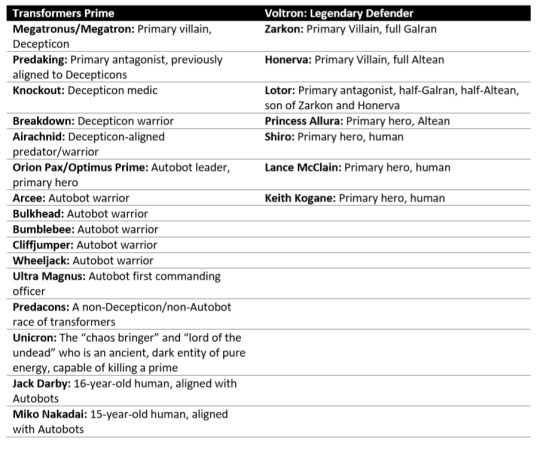
Honerva copies Megatron, both before and after his corruption. Honerva’s new history was entirely unprecedented within Voltron lore, but it was a core staple within TFP.
Both Honerva and Megatronus start off as good people, with very close friendships with the protagonist leaders, Alfor and Orion Pax. Both Megatronus and Honerva see societal ills, inequality, and want to fix them, challenging the traditions/hoarding of power by those of higher authority. Both Megatronus and Honerva are told their ideas for improving the world are wrong because they involve force and a demand for access to great power (For Honerva, it’s the quintessence field. For Megatronus, it’s the powerful Matrix of Leadership, which would result in making him a prime). Both characters ignore the concerns of Alfor/The High Council and grow increasingly more frustrated with the balance of power, desiring to usurp it for themselves. Both suffer the consequences and jumpstart a millennia-long war.
Their names change upon corruption. Megatronus becomes Megatron. Honerva becomes Haggar. Neither Megatronus nor Honerva are ever again able to truly separate from who they’ve become. The good part of them is permanently marred.
They’re both obsessed with a magic that can be used for great evil, from a questionable, destructive source (Dark Entity/rift creatures in VLD, the chaotic dark entity Unicron in TFP).
Both shows include an episode of the protagonists/heroes diving into the mind of Honerva/Megatron for more information, and having a harrowing experience in doing so.
Both Honerva and Megatron reanimate, to an extent, a dead soldier (Lotor/Cliffjumper) and use his body/weapons for their own purpose.
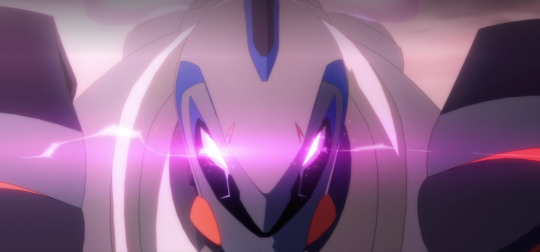
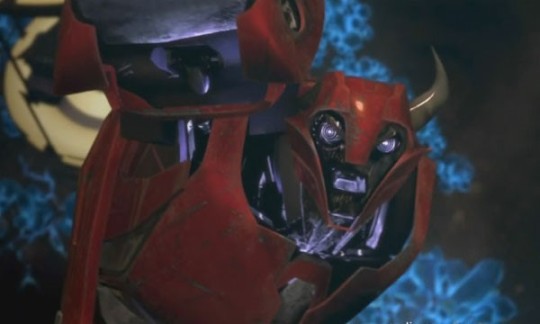
Honerva and Predacons Rising Megatron
In the final movie that ended TFP, Predacons Rising, Megatron’s character gets taken to a whole new level. Honerva’s arc eerily matches:
Both Honerva and Megatron are overwhelmed when the Dark Entities/Rift Creatures and Unicorn decide to destroy the world(s) most precious to them.
Both die and are reanimated back to life by dark power.
Upon reanimation, both can wield purple magic.

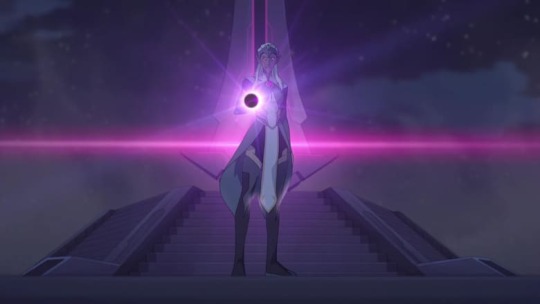
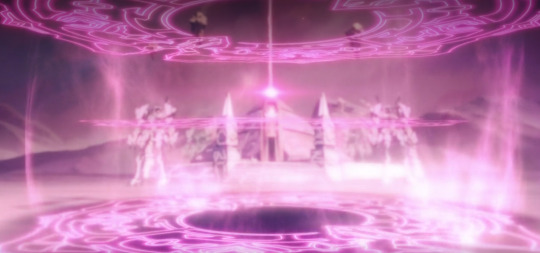
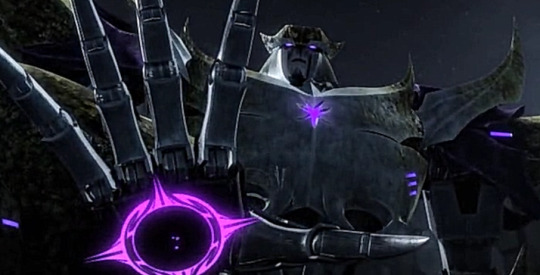

In TFP, Unicron, an ancient dark entity who is the source of all chaos and evil, says, “Your husk will simply be an instrument of my will.” Megatron undergoes a painful transformation that alters his usual form. In VLD, through contact with a dark entity and through the corruption from pure quintessence exposure, Honerva becomes Haggar. She is heavily altered visually, and is little more than a puppet of Zarkon’s will until she remembers who she is and fights back to regain herself, just as Megatronus does with Unicron.
They both gain the ability to peer into the minds and even alter the minds and behaviors of others.
Megatron cannot join the Allspark (go to the afterlife) because he’d been joined to the lifeblood of the chaotic Unicron, and he spends a deal of time cursed inside the mind of Unicron. Honerva’s soul does not move to the afterlife in death, but instead, being infused with quintessence, she is reanimated. They’re both the immortally undead. In addition, Honerva had “cursed” the souls of the OG paladins. They were inside her mind with her, unable to be in the afterlife because of it, similar to the plight Megatron finds himself in within Unicron’s mind.
They both give themselves over to scorched-earth policy. Honerva refuses the title to run an empire and goes on to nearly destroy the multiverse. Megatron, as Unicron’s puppet, admits to fellow Decepticons (who are subsequently disturbed by him), “I do not wish to conquer this world—I wish to eradicate it.” Honerva follows suit in her desire to achieve the past at any cost to the future of an entire multiverse, carrying Megatron’s banner that, “The past shall consume the future!”
A quasi-redemption arc: Both Megatron and Honerva achieve what they want. Megatron gets bonded to the spark of a great, chaotic power, able to warp time and space as a new, all-powerful being. His abilities allow him to quickly fly to a regenerated version of his home world, Cybertron, which had been destroyed millennia ago. Honerva gets access to Oriande, transreality materials, and achieves entry to a dimension with a still-living family on her home world of Altea (which was living, unlike the Altea she know, which had been destroyed millennia ago).
Once they’re given over to the power or end they desired, they do not achieve the true effect they wanted. They have a moment where they lose their own personal agency within that situation, only to rage to destroy everything at great risk to themselves, and then from out of the rage, fall into a daze of distaste for what their desires have brought them.
Then they both act defeated, whiny, and salty over how nothing’s like what they wanted.
They both disappear off into the sunset in a disquieted, defeated sense of, “Whatever, I guess I’ll be good now and do my own thing because I’m tired.” (Paraphrasing here.)
In TFP, the insanity of Predacons Rising Megatron is described by Predaking (another character) as, “Dark magic…perpetrated by the demon who lives in Megatron’s skin.” In a similar manner, Lotor accuses the Oriande-infused Honerva of being “an abomination.”
Zarkon is a mirror to the standard, more well-known Megatron. But in VLD, he boasts similar characteristics, like Honerva, to Megatronus, picking up Megatronus’s gladiator history. Class issues are important to both Zarkon and Megatronus as well.
It’s implied that Megatron was born into a very low class and rose to power through the gladiatorial ring by rite of combat, bolstering his political career. As a gladiator “in the pits of Kaon,” his rise to become the leader of the Decepticons mirrors Voltron’s brand-new lore of Zarkon rising to imperial power through the Kral Zera, which is a ceremonial gladiatorial arena to establish the new leader through rite of combat.
Zarkon functioned as a military mentor for Alfor; Megatronus was a political mentor to Orion Pax.
According to the lore of the original Thirteen Primes, Megatronus Prime got into a fight with his brethren that resulted in the death of his lover, Solus Prime, a weapons forger. Megatronus Prime’s title as “The Fallen” being closely related to in-fighting specifically over a lover in many ways echoes in the ultimate breakdown of friendship between Alfor and Zarkon, specifically over Honerva and her abilities to manipulate quintessence into tactical advantages/weapons. The end result is that Zarkon “falls” as well through Honerva’s death, just as Megatronus Prime falls through the death of Solus Prime.
Zarkon is massively injured and in a state of unconscious for a time, disrupting the empire. Megatron as well is massively injured in a state of unconsciousness for a time, disrupting the order of command for the Decepticons. In both instances, this is a major plot device to introduce other characters to the show and deepen political conflict.

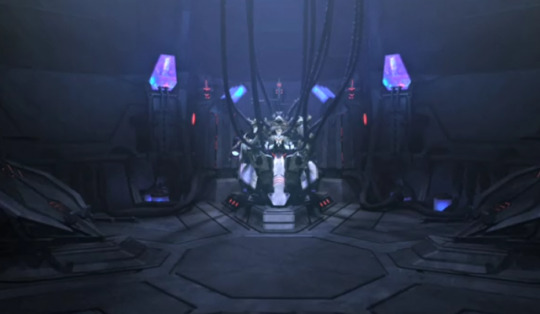
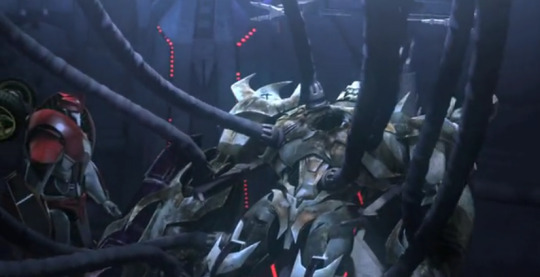
Zarkon’s armor and facial reconstruction for the reboot more closely mimic Megatron’s elongated face and eye-set, as well as his very wide-shoulder, spiky armor, complete with angled armor lining his cheeks. It’s similar enough that others have poked fun at their similarities.
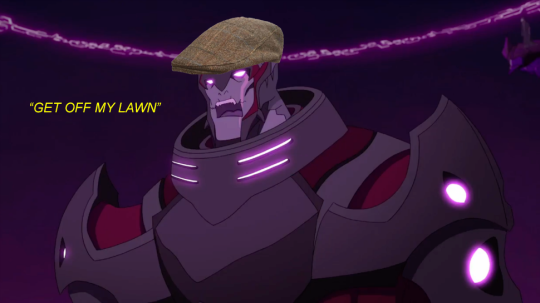
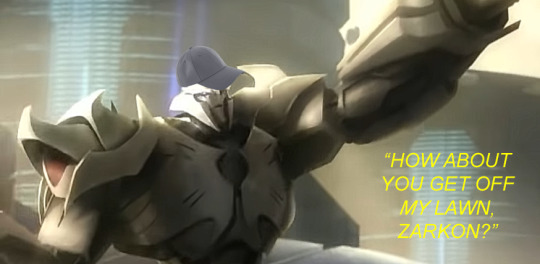
Alfor’s history more closely mimics that of Orion Pax. They’re both initially great friends with the very person who would later seek to kill them and their friends.
It’s implied that Megatronus suffered through the very issues that he was critiquing to the High Council. Meanwhile, Orion Pax was of a higher class and coddled from experiencing the same societal ills. In many ways, this echoes how Alfor critiqued the behaviors of Zarkon and Honerva, while standing from a place of incredible power through Oriande, as well as physical peace and comfort.
Alfor and Orion Pax are both very scholarly individuals without the military expertise as touted by their counterparts, Zarkon and Megatronus.
Alfor and Orion Pax are both initially deceived by the heartfelt words of their friends, only to realize in horror what their friends actually desired beneath it.
Orion Pax and Alfor stand as the ultimate inheritors of the powers and status coveted by Zarkon/Honerva and Megatronus.
When Orion Pax is converted to Optimus Prime, his old self somewhat dies, and he becomes a more perfected, all-powerful version. Alfor, likewise, dies in the war…and his legacy is inherited by Allura, who is canonically shown as even more powerful. She carries on the mantle/legacy as previously set before her by her predecessors.
And last but not least of the Big Four, Princess Allura’s arc in VLD very closely mimics Optimus Prime’s arc in TFP.
Like Optimus Prime, Allura becomes locked into a millennia-old war that she did not start herself.
Optimus Prime is the last of the primes. Princess Allura is the last of the royal Altean line. Both primes and royal Alteans have access to deep knowledge and mystical abilities coveted greatly by others of their race.
The High Council bestows the Matrix of Leadership, which is the core of Optimus Prime’s power. The Ancient Alteans of Oriande impart their wisdom and knowledge to enhance Allura’s power. Megatronus’s failure to achieve the Matrix, receiving only rejection in return, is echoed in Lotor’s rejection and fall in Oriande, who like his father sought to obtain such power through Galra-standard force.
Optimus Prime is a member of an endangered species, believing his few Autobot comrades to be some of the only ones remaining after the great war. In a similar way, Princess Allura struggles with the isolation and fall of Alteans. Both Optimus and Allura are separated by vast distances of space from other possible survivors of their own kind.
They both agree to truces with great enemies and unknown powers for a specific end. Allura accepts the dark entity and works alongside Lotor. Optimus makes several deals with Megatron, at great hesitance from his team.
Both wield great power that no one else currently can.
They both sacrifice their lives and own energy in the end to restore life itself to worlds, because they cannot separate themselves from the power it takes to restore life.
They both pass down a “transformation” to one of their brethren before dying. Princess Allura gives Altean marks to Lance. Optimus converts Bumblebee to a warrior.
Their comrades all stand and watch as they willingly sacrifice themselves, and they have first-row seats to a major visual outpouring of light and life.
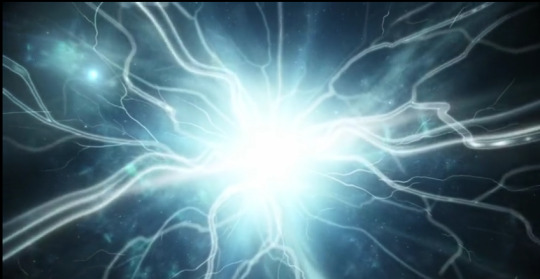
(Screenshot explanation: The visual effect of Princess Allura sacrificing herself to restore life to the multiverse.)
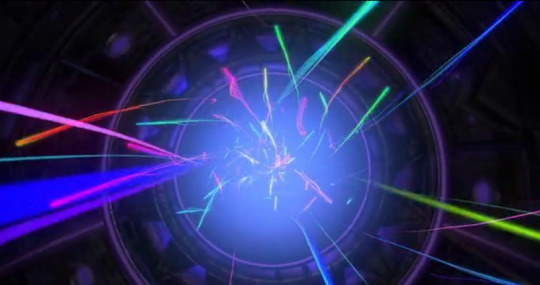
(Screenshot explanation: The visual effect of Optimus Prime sacrificing himself to restore life to the Well of All Sparks.)
Aside from The Big Four, there are other TFP characters with extreme similarities to VLD supporting characters.
Knockout/Breakdown/Predaking as Lotor
The Knockout connection to Lotor
According to Hasbro’s vice president of development and scripted entertainment, Mike Vogel, Knockout as a character received several upgrades because his previous iteration as “Lugnut” wasn’t considered sexy enough. Similarly, Lotor in VLD was upgraded to be a prettier bad boy in several ways that he hadn’t been before, especially in regard to physical clothing and behavior. Both pretty bad boys ultimately boasted a tight waist, spiky shoulders, great eyeliner, and heavily angled paneling on their torsos:
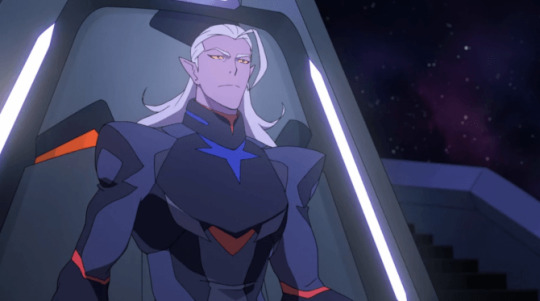
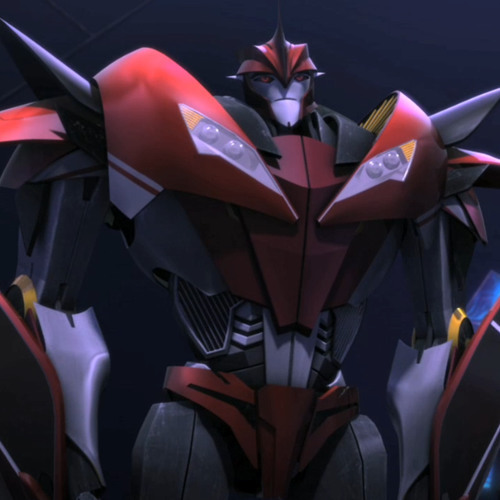
Knockout is coded as being “different” than most of the other Decepticons and is looked down upon for having a road-based alt-mode instead of an alt-mode that affords flight. In being so, he is more similar to the Autobots despite being born as a Decepticon. Likewise, VLD heavily increases the amount of attention and derision given to Lotor for being half-Galran and half-Altean. Both Knockout and Lotor profess great confidence and satisfaction in what they are, though, regardless of anyone else’s critique.
Knockout is summoned to Earth after the fall of Megatron, who remains in an ill, unconscious state. This is reflected in how Lotor is introduced into the revised Voltron series, to assist his reigning father in a time of need.
Knockout is a medic and is tasked with preserving life—or taking it out. Lotor’s base motivation is also to preserve life, but he maintains Knockout’s underhanded side of also deciding when to eliminate a loose or unproductive end.
Unlike previous iterations of Lotor, the VLD Lotor is excessively more evasive and less likely to barge in bull-headedly into battle. Knockout uses similar tactics.
Knockout gets melded into a ship (although unlike Lotor, he does get out and isn’t dead).
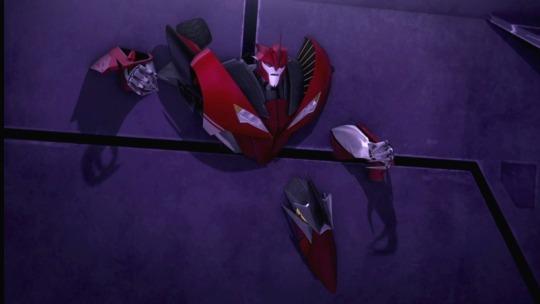
Knockout constantly schemes for more power and prestige, using underhanded tactics. He has very little loyalty but does have a deep bond with fellow Decepticon Breakdown, who functions as the muscle to Knockout’s intelligence. They’re usually seen together as two halves of the same brotherly unit. In a similar way, Lotor is the scheming commander and point of intelligence in his own small group. His generals are overall the brawn, like Breakdown.
Knockout provides confidential information about his old Decepticon comrades to help the Autobots while in custody as a prisoner of war. (Although unlike Lotor, Knockout demands, “We’re prisoners of war; we have rights!”)
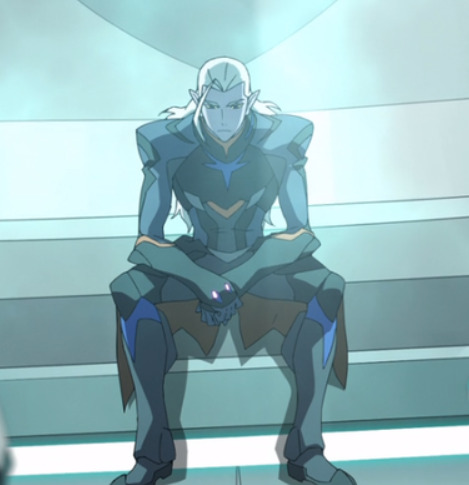
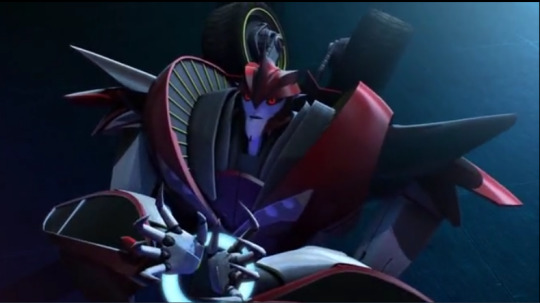
The Predaking connection to Lotor
Predaking is a type of Predacon, an ancient beast that died long ago but is brought back to life through experimentation. In ways, his ancient status and the strange circumstances of his “birth” echo in the way Prince Lotor is a vestige himself from ancient times and was still growing in Honerva when she died, suggesting that he died as well or was somehow preserved by his infusion with quintessence. The result is that his life is unnaturally sustained by quintessence itself, when he would have otherwise been dead. Similarly, Predaking’s existence was not possible without intentionally overriding natural limitations, since his kind could not be “sparked” naturally.
Predaking is groomed to be a weapon for Megatron and initially assumed to be a dumb beast. In doing so, he endures ongoing physical and mental abuse by the Decepticons, particularly Megatron’s second in command, Starscream. As he grows more intelligent and powerful, he increasingly balks against the treatment he receives and loses loyalty to Megatron. This is similar to Lotor being groomed as the heir to the Galran throne via brainwashing but yet suffers abuse for what he is. He, like Predaking, ultimately grows to reject much of what he’s been told to believe about himself and his place in the world. Both Lotor and Predaking are strong enough to challenge and nearly defeat the main heroes of the shows, Voltron and Optimus Prime, respectively.
Predaking, in hatred for Megatron who tried to make him a weapon, attacks him with the intent to kill. Lotor, likewise, attacks his father, Zarkon—although Lotor does achieve killing him.
Both Predaking and Lotor are core to the dismantling of various alliances upon the discovery of a colony of innocents being killed in the name of tactical war advantages. In both cases, the innocents were people in tubes being groomed/harvested for war purposes.
The Breakdown connection to Lotor
Decepticon Breakdown is betrayed by one of his own team members, whom he had found attractive and had flirted with. The Decepticon femme Airachnid kills him. The distorted remains of his body end up being used for spare parts for a terrorist’s horrifying fusion of organic flesh and mech technology. Ultimately, Breakdown’s body is a victim of being used post-mortem to further the military aims of another person who wanted to exploit him. Breakdown’s personal agency is completely removed, and his body receives no rest.
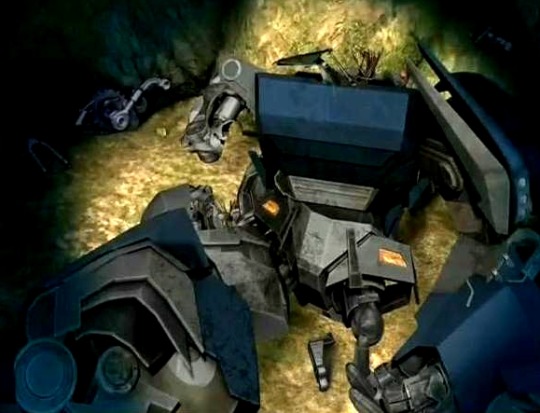

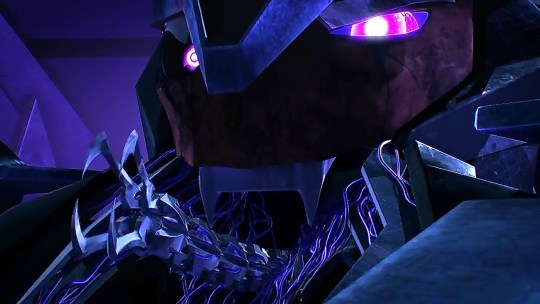
Lotor, likewise, is betrayed by Voltron and specifically by Princess Allura during an alliance. Princess Allura, as his love interest, kills him. The distorted remains of his body, which are fused to the Sincline ship, end up being used post-mortem to further the military aims of Honerva. Lotor’s personal agency is completely removed, and his body receives no rest.
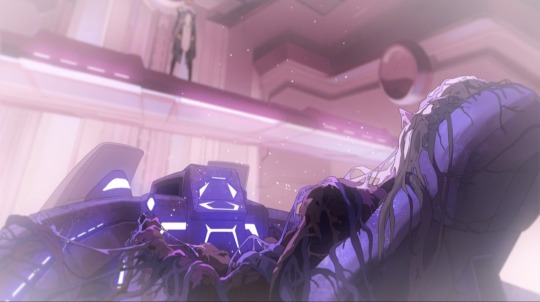
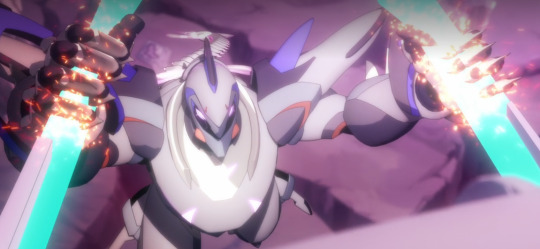

Bumblebee as Lance
Bumblebee and Lance, as the beloved young but inexperienced warriors, are both killed and brought back to life.
Bumblebee has progressively taken over as the frontrunner of the show within the Transformers franchise. Likewise, Lance gained more screen time and heightened significance in VLD compared to previous Voltron iterations.
Lance in the VLD finale and Bumblebee in the TFP sequel both struggle with the dissonance between who they were during war and now who they are as guardians or people look up to, but who are somewhat vestiges of the past.
Optimus Prime, prior to his death, changes Bumblebee from a scout to a warrior, which was not what Bumblebee was originally designed to be. Princess Allura, prior to her death, alters Lance from being purely human to exhibiting Altean characteristics.
Arcee as Shiro
They both suffer from PTSD, having been tortured by the enemy, interrogated, and experimented on. Arcee, being mechanical, has had her visible scars repaired, but the nightmares remain. Shiro similarly experiences PTSD.
They both have lost a significant other to war. They’re both afraid of losing the children they’re responsible for.
They both find family and are able to find happiness by the end, putting to rest any conflict they had over their previous partner.
Nemesis Prime (a Clone of Optimus Prime) as Kuron (a Clone of Shiro)
Nemesis Prime is a “clone” of Optimus Prime, developed by the human terrorist group M.E.C.H. He exhibits a physical appearance similar to Optimus Prime but, when activated, carries out their will of death and destruction.
Similarly, Kuron is a clone of Shiro developed by Haggar. He exhibits a physical appearance similar to the true Shiro, but when activated, carries out Haggar’s will of death and destruction.
The reputation of Optimus and Shiro are temporarily called in question before others realize what’s actually happening.
Jack Darby as Keith Kogane
Both have missing/dead fathers. Their mothers are alive, and they’re very close to their mothers, but said mother is often not a part of their daily life, given her own missions.
Both are loners and go through an arc of no longer wanting to be a part of the team, during which the team has to remind them of what they’ve gained and how important they are.
Both have a high sensibility to wanting to do the right thing, but not feeling worthy or wanting to have a position of power.
Both are constantly annoyed by the bull-headed antics of their teammate (Miko/Lance), often rolling eyes or getting on their case, but end up bonding with them in the end.
Both are the “human” lead for their team.
Both inherit great power. Optimus Prime, when no longer able to complete the mission, hands Jack the Omega Lock key. When Shiro is no longer able to be Black Paladin, Voltron chooses Keith to carry it forward.
And there’s so many other character similarities.
Moral Ambiguities
VLD also copies the moral ambiguity standards set within Transformers Prime.
In an Afterbuzz interview at the 12:52 mark, JDS and LM uplifted VLD as fairly groundbreaking for children’s shows, per its moral ambiguities. JDS said, “The finale is almost, I don’t know—I don’t wanna say unlike anything that you would see in other like-minded shows, like let’s say, like, Transformers or Power Rangers, or….something that Voltron was like, by outward appearances, being compared to. But it was something I think really exciting for us to explore because we did create villains and create heroes that worked within this very kind of, like, shades of gray spectrum. There was black, there was white. But we played in this weird morally ambiguous zone a lot of the time. And that was—I think, it was important for audiences of every age group to see that.”
Lauren Montgomery agreed at 13:33, stating, “We also came from working on shows like Avatar the last Airbender, and Korra, which very much pushed those boundaries as well, and were extremely ground-breaking for children’s programming. And it was not something that was coming out of western animation.”
Afterbuzz Interview: https://www.youtube.com/watch?v=MudCcj6QRzA
However, the vast majority of what VLD did plot-wise with moral ambiguity was already used inside TFP, a western animation cartoon airing well before Korra:
The Colony Problem
In TFP, Autobots Wheeljack and Ultra Magnus knowingly and willingly commit massacre against innocent beings. Predacons (a different race of transformers, based on ancient beasts) were being groomed in test tubes in Megatron’s facility for the purpose of becoming Decepticon warriors. In fear that Predacons would hurt humans, the Autobots choose to kill them all. This decision comes back to haunt them dearly, through Predaking’s discovery of the massacre.
Predaking, who is a Predacon himself, is an antagonist of incredible moral ambiguity. He expresses great frustration with both the Autobots and the Decepticons. He despises the abuse he endures from the Decepticons, despises Megatron for betraying his kind to the Autobots, and then despises the Autobots, who knowingly commit massacre against his own kind. His tactics and perspectives, as he refuses both sides of the war and fights to create his own space, result in him becoming an ultimate antagonist to both Autobots and Decepticons.
The Trolley problem as experienced by the Autobots (sacrificing some to save many), and the resulting political fallouts, are mirrored within VLD.
In VLD, Prince Lotor had faced a similar trolley problem as well, in which he was instrumental in how several innocent Alteans were sacrificed for an unknown military aim against the Galra. The slain Predacons and second-colony Alteans are both shown in tubes in an experimental lab, represented as victims/cannon fodder of a much larger military function.
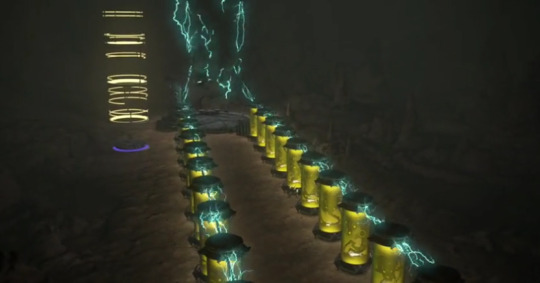

In VLD, the discovery of the Altean colony results in an utter destruction of previous alliances. Similarly, Predaking breaks ties with everyone in total disillusionment and rage, never again believing Autobots when they say they believe in peaceful coexistence of two races. His sentiments are echoed into VLD, in which the Galra are suspicious of Voltron and call them traitors.
Moral Shades of Gray: Characters Who Fall on a Spectrum
TFP’s Predaking has his own code of honor and is a primary example of a morally ambiguous character. He absolutely despises the Unicron-reborn version of Megatron. He snarls, “Dark magic…perpetrated by the demon who lives in Megatron’s skin.” This implies that Predaking ranks himself higher in his ways than Megatron. But Predaking, in his desire for revenge and power, also falls short of the stated moral standards of the Autobots. Similarly, Lotor absolutely despises the witch Haggar/Honerva, calling her an “abomination,” and yet he fails to meet the moral standards of Voltron and is therefore named an enemy despite their alliance.
Moral Focal Points: Have the Good Guys Always Been Good? And Have the Bad Guys Always Been Bad?
In TFP, the Autobots are said to have been the moral standard. However, they also bear a dark history of class issues / inequality and political corruption.
Similarly, in VLD, Alteans posit themselves as the moral and diplomatic standard, desiring peace for all. However, the Ancient Alteans hoarded Oriande’s power for only a select few of their kind. Alfor had no problems barreling in and using force against other people groups, in s3 flashbacks. He also created the most powerful weapon in the universe to enforce his version of peace, in which Voltron itself feeds off the life force of its paladins. Alteans additionally were able to terraform entire planets, the technology of which would have required immense power (where did they harvest that from?), and the result was the massacre of all life on said planet, for them to use to their will. These canon details suggest the Galra’s “komar” life-harvesting technology may have originated from Alteans themselves.
In VLD, the Galra (through Commander Lahn) express frustrations with Princess Allura’s coddled mindset, which mimics Megatron’s own frustrations with Autobot morality, which is derived from a position of power and comfort.
So, in general, there’s a moral similarity between TFP and VLD, in which the “heroes” have these dark pasts and yet attempt to smooth it over, while the “villains” are victims of a much larger, oppressive order and are calling the heroes out for their hypocrisies and crimes, demanding access to the same power as they wield, or committing similar crimes as the heroes and suffering harder for it.
So given all these similarities, how in the world is TFP so much better than VLD, message-wise?
1. TFP actually understood moral ambiguity.
In TFP, Megatron disbands the Decepticons, tired of bloodshed, without turning to the Autobots or acknowledging their perspective as the morally correct one.
The humans in TFP are excessively fallible, just like their transformer counterparts. There is a human terrorist group, M.E.C.H, who paces both Autobots and Decepticons, desiring their technology to enforce their will upon the world. These humans commit great horrors against both sides of the war, resulting in difficult decisions, odd truces between the Autobots and Decepticons, and humans fighting other humans. In other words, humans are NOT the moral center of the universe.
Some Autobots have looser morals and less self-control than others, which grates against the sensibilities of the more morally sensitive and results in a lot of disagreement and problems.
TFP consistently reflects on lessons learned. The heroes admit when they are wrong or fail to achieve moral perfection in their actions. They have to struggle through those decisions, the consequences of those decisions, and are bolstered to do better, be better.
The villains are not simply obsessed with power and are also capable of having empathy and doing things outside of pointless destruction. Breakdown is pleasantly surprised when one of the humans asks, “How are you?” And Breakdown responds politely. He also expresses sympathy for the hard work and struggle of the vehicons, who are servant-class workers on the Decepticon ship, similar to Galran robots. Likewise, Knockout expresses a love of human zombie movies and going to drive-ins to watch them, along with appreciating human vehicle design and street racing.
TFP shows villains scared and in pain, with a tremendous range of emotion and dreams. This is way more complex than how the villainous Galra are shown in VLD, who are consistently on a war path.
The heroes are willing to side with the villains (who killed their own people) to defeat common foes. The tension and resulting conversations from those truces are hilariously more complex than VLD, in which Voltron refused to work with Emperor Lotor, who is implicated in killing Alteans in the larger war against Galra. Instead of pursuing the tactical advantage of an ongoing alliance, Voltron simply assassinates him without due process for his war crime, asserting Voltron as the only morally unfallible point in the universe.
TFP shows the human heroes learning when they’re fallible and trying to be better.
TFP actively struggles with how human children/teenagers are endangered by the war, even when the children themselves don’t understand the danger.
2. TFP does a lot of other things well.
TFP always maintains a perspective that the true battle between good and evil is not a physical one—but one fought within the heart. Per Optimus Prime, “As even Megatron has demonstrated on this day, every sentient being possesses the capacity for change.” This is vastly unlike VLD, which stumbles to handle the perspectives of Voltron antagonists or the belief that people can truly change.
Megatron endures the very suffering he’d inflicted on others and comes to the decision on his own to stop his violence and disband the Decepticons, also ending his own “stereotypical toxic masculinity” arc. This contrasts heavily with Honerva, who goes into the afterlife without an understanding of why she can’t be happy as she is, demanding happiness and a family after she’s caused so much pain even to that family, perpetuating her own “stereotypical toxic femininity” arc.
There is a significant difference in the sacrifice of Optimus Prime compared to the death of Princess Allura. Optimus Prime’s sacrifice was a major power move, as well as not unexpected, given Transformers’ history of killing him off. (Although back in his first death in 1986, this was a horrifying shock to children who looked up to Optimus as a father). But within the context of TFP, Optimus had undergone a low point in the story prior, only to be rebuilt stronger than ever and growing in power and confidence as the re-energized leader of the Autobots. He had everything to live for (family, friends, regenerated planet, power) when he chose to sacrifice himself for others. Additionally, he knew there was hope in choosing to sacrifice his material body to restart the Well of Sparks, so that life could be regenerated on his planet. Optimus Prime even contextualizes his death in terms of rebirth and hope. His last words to his friends are: “Above all, do not lament my absence, for in my spark, I know that this is not the end. But merely, a new beginning. Simply put…another transformation.” He flies into death, more powerful and revered than he had ever been. He has a peaceful expression on his face. All of these details are wildly different from VLD. Princess Allura, like Optimus Prime, hits a low point beginning in s6 when Voltron’s alliance with Emperor Lotor unravels. But unlike Optimus Prime, Princess Allura continues to be progressively stripped of identity, power, and personal agency, careening into utter despondency until she willingly kills herself, with nothing to live for. She constantly gives up her own personal power to others, increasingly isolates herself from others, grows more emotionally volatile, denies her own people, and sinks into the background as other characters determine her life and decisions. There is nothing personally identifying about her by the end, with even her crown and state of dress removed/replaced with the uniform of a basic human soldier. Sorrow for her value and death comes too late in the story, when she has already become the most expendable character. It’s of additional significance that no one in VLD tries to help Princess Allura by offering other ways to resurrect the multiverse. There are only some paltry sniffles and weak, “No, don’t” responses. This is a huge contrast to TFP, in which several characters immediately are incensed by the thought of losing Optimus Prime. They jump in with ideas for how to possibly save their beloved leader, willing to endure more personal hardship on his behalf. They express that they didn’t fight this hard to resurrect Cybertron, only to lose someone they cared about. Optimus Prime explains why their ideas would not work, but in doing so, reveals that he is already one with the All Spark (meaning, that his spark is already part of a mystical collection of souls with the capacity to be born/reborn, and that continuing to live, bonded to the All Spark, would be denying all other souls from experiencing life). It is his explanation that bolsters the necessity of his sacrifice and converts his final words from being a hollow comfort to a genuine conviction that this was not the end. That they would all someday meet again.
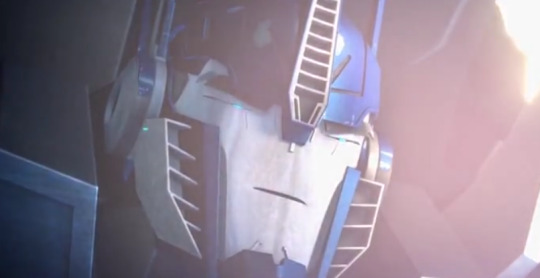
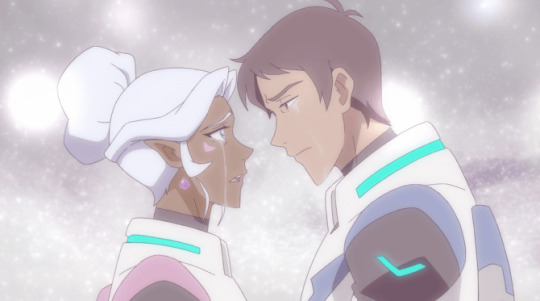
In the TFP sequel, Robots in Disguise (2015), it’s revealed that Optimus Prime, in death, has become an interdimensional being, capable of still interacting with and providing guidance to Bumblebee on the “human plane,” all while being spiritually tested by greater beings with even more interdimensional power than him (the Primes). Interestingly enough, this topic is mirrored within VLD. Such interdimensional beings are confirmed to exist via season 7, in which the Voltron paladins are whisked away by an all-powerful interdimensional entity, who tests their worthiness as warriors. Additionally, some of the VLD meta by @leakinghate posits that an afterlife existence for Princess Allura and Lotor as interdimensional beings was supposed to happen in the VLD finale, but was ultimately not published. Had such been published, Princess Allura’s final arc would have further matched Optimus Prime and better maintained the hope and meaning associated with his arc.

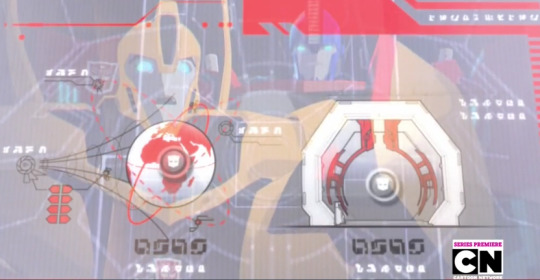
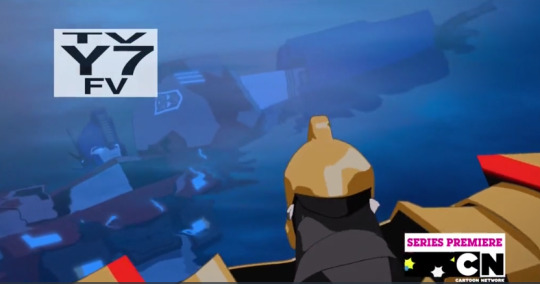
Transformers don’t always save the day. Sometimes, it’s a little human girl with a baseball bat, or a little human boy with coding skills, or a teenager willing to put themselves in harm’s way to protect them. This greatly humbles the Autobots, some of whom struggle with their pride and the reality that they don’t have all the answers all the time, and that sometimes, they need to be protected too.
TFP actively struggles with both positive and negative prejudices assigned to humans and transformers. The humans originally think the transformers are just robots without souls—they think it’s all a game. They soon discover that transformers can bleed, and have emotions, and have a soul than can die. Likewise, some transformers find the humans to be a nuisance and despise their “fleshiness,” but soon overcome those perspectives to grow very protective and attached to humans. In other words, everyone struggles through their own perspective and learns on the way.
Optimus Prime remains the consistent point of morality for TFP. When he does controversial things, like engaging in an alliance with Megatron or allowing medical aid to be provided to Decepticons, he acknowledges those things and explains his reasoning. This is unlike Voltron, who engages in action without reflection while still demanding a position as the unquestionable moral center of the universe.
Knockout, as the Lotor bad boy of the series, defects and actively becomes a member of the Autobots. He admits he didn’t have the best role models, and it’s shown throughout the show that he endures physical and mental abuse by some Decepticons as well. He makes a cameo in Robots in Disguise (2015), suggesting he is still alive and well as an Autobot. Optimus Prime at the end of TFP includes Knockout when he says each of his teammates had acted as a prime, offering a tremendous weight of value and respect to Knockout.
Even Predaking, the antagonist, ends up helping the Autobots when it counts and otherwise remains distant with them.
Predaking gets justice against his abusers.
Autobots and many Decepticons are consistently horrified and disturbed by the crimes perpetuated against Decepticon Breakdown, whose body is taken and mutilated by terrorist group M.E.C.H.
Arcee manages to positively cope with her PTSD and remains as an active, plot-intrinsic character to the end, with several episodes dedicated to her own character arcs and the advantages she provides the overall team. She lives to see and experience her dream of a restored planet come true, without being turned into an example of the sexy lamp trope.
The transformers are able to achieve their goal of restoring Cybertron and generating new life, which allows several other characters to begin healing from the trauma of war and regain what they had lost.
The humans who make villainous decisions have dire consequences.
The human Miko rises up to become an Autobot Wrecker in her own right, without sacrificing or compromising anything about who she is, how she presents herself, or what her other interests are.
Bulkhead originally despises Decepticons but ends up rescuing his own sworn enemy from torture and dismantlement because he learns to put justice for and the safety of all people first.
The number of parallels between Transformers Prime and Voltron: Legendary Defender extend even beyond this list. And yet as seen above, TFP succeeded in so many of the major areas where VLD ultimately failed.
Transformers Prime, even years after its finale, remains as the award-winning show that transformed dark and edgy content into messages of hope, redemption, gender equality and social acceptance, moral responsibility, the power of teamwork—and did it as a Y7-FV show geared primarily for young boys.
So, if you were disappointed in VLD and how it ended, check out the edgy but satisfying TFP for what a real children’s mecha show should be like.
(Special thanks to @mermaider00 for being my TFP buddy and for suggesting some of the points discussed in this post!)
#Voltron#vld#Voltron Legendary Defender#Transformers#Transformers Prime#tfp#s8 critical#meta#AN ADVERTISEMENT FOR TRANSFORMERS PRIME#Y'all need to watch this show#TFP was the VLD I had wanted all along and already had#I watched tfp when it first ran#then I had deja vu when I went back to rewatch after watching VLD#it's not a perfect show#still has flaws#the show even garnered a convention panel in 2015 about various production and show bible and budget issues#but it stands the test of time#i love transformers prime so much
51 notes
·
View notes
Text
Spider-Man
Marvel's Spider-Man from Insomniac Games is one of the most anticipated games of 2018, but did the developers manage to create the best project in the history of video games about this defender of new York and, most importantly, meet the expectations of players? Let's take it all in order. It is worth noting that the author of the review played on an ordinary PlayStation 4 (Slim), so the screenshots are made on it, and the impressions are based on this version. The article was written after receiving the platinum prize, which means that the opinion will be weighted as much as possible.
Marvel's Spider-Man, an action-adventure game developed exclusively for the PlayStation 4, was first unveiled on June 13, 2016 at E3 electronic entertainment. And now, after a little more than two years, we can enjoy it on our own.
You don't need wings to fly
The game greets newcomers with a smooth transition from the opening cut scene to the gameplay, resulting in you being in the air while flying on a web. After learning which button is responsible for throwing the web in the direction of buildings (R2), there is an instant habituation to this method of movement. It seems that you have not just launched the game, but are a veteran of it. Swinging on the web works exactly as it should in terms of convenience and realism. At this time, the character moves in an arc and maintains inertia, so you can slow down the flight or, conversely, increase its speed by using a jump at different times. If you constantly hold R2, Spider-Man will automatically release a new web and move forward. Similarly, it is easy and fast to change the direction of movement: when you press the jump button during a free fall, the main character will perform a jerk on the web, which will allow you to accelerate in the right direction. As previously stated, the web clings strictly to real objects, not to air, unlike many previous Spider games. Therefore, in places with low buildings, you will have to go down, and in Central Park you will have to cling to trees, being on the verge of hitting your heels on the ground. By the way, in order not to wait for the protagonist to fall to the height where it will again be possible to use the web, you can accelerate in the fall by clicking on the left stick.
The movement system is designed so that the dynamics of movement around the city is maintained at the same pace. Thus, if the character runs into a skyscraper, then when holding R2, it will continue to move along it in the selected direction without stopping. While running on a horizontal surface, the same button will allow you to overcome obstacles using parkour without additional manipulations. Jerks on the web, among other things, while running vertically will help to reach the roof as quickly as possible, and immediately after push off from it, continuing the path. Some of these techniques can be opened as you level up spider-Man, acquiring the appropriate skills.
The project is completely translated into the great and mighty, and in General, the Russian voice acting is not so bad, but in some places its quality is greatly reduced. But the fact that it will not be changed separately from the subtitles will probably shock some players. The only option left is to change the console language, but the whole game will be in English.
No longer a novice
Insomniac Games Studio decided to focus on an experienced superhero, who has more than one year of practice, but the plot of the game is independent. Of course, you will meet familiar characters here, but the story will develop in a new way. However, on August 21 of this year, the official prequel of this game was released in the form of a novel authored by American writer David Liss, which was subtitled Spider-Man: Hostile Takeover. Unfortunately, at the moment the book is only available in the original, in English. It tells the story of Wilson Fisk's return to new York, where he appears as a philanthropist to the public. Peter Parker knows very well the true face of Kingpin, so he will have to bring it to light. But not everything is so simple, because at the same time in the city there is a double of Spider-Man under the pseudonym Blood Spider, with a similar costume and abilities, which substitutes the hero, committing crimes. The game's plot begins at the very moment when the book ends.
Avoiding disclosure of details of the plot, so as not to spoil the impression of the readers of the article, I will only Express my opinion about it after full passage. The scenario is generally good, but, unfortunately, quite predictable and not surprising. But the animation of the characters and the environment is very lively, and the setting of plot tasks is performed at the highest level. Because of this, it is quite interesting to take a direct part in the development of history. However, the boss battles were somewhat disappointing. They look spectacular, but feel too scripted and ordinary, unlike the rest of the game. It is clear that the project puts a lot of emphasis on cinematography, but it would be possible to implement them more rich in gameplay terms. Sometimes you have to fight several strong mutants at the same time, which looks pretty cool, but again, the gameplay seems to be in the background. It is not surprising that the health scale is displayed only for the protagonist, even during a boss battle.
Peter Parker and his alter ego Spider-Man is not the only playable character in Marvel's Spider-Man. In the story, you will also have to take control of a couple of other actors, which radically changes the gameplay and makes the game more diverse. As a rule, in scenes with them, you need to act covertly. It should be emphasized that the control between the characters is also transferred during the same episode to, say, help your friend. This is not new in video games, but nevertheless, this solution is quite interesting. During the game, not so often, but there are QTE, and the transition from cut scenes to the gameplay is performed imperceptibly.
During tasks and in the lab at Peter Parker's place of work, there are two types of puzzles. In the first, it is necessary to make an electric chain of components, where the voltage often has to be taken into account. The latter are aimed at recognizing an unknown substance by the absorption spectrum. In them, you need to take fragments of an unknown substance and try to combine its absorption lines with the template.
The storm of the underworld
Battles in Marvel's Spider-Man are one of the most important components of the gameplay. When creating the combat system, the developers were probably inspired by the Batman: Arkham series, since they have obvious similarities. However, unlike Batman, Spider-Man uses more acrobatic techniques, relying on his enviable dexterity. However, he often uses a web and lifts opponents into the air, continuing the battle there. What is important, fights look like a continuous dance, in which one movement smoothly flows into another.
You can instantly eliminate enemies when they don't see you, or when you accumulate a concentration scale, use the suit function, or use the Spider's cunning devices, which will be described in more detail later. Several types of knockouts are used for undetected elimination. To perform a silent knockout, you need to sneak up on the enemy from behind. For a web strike, you must be above the target. In addition, you can discreetly eliminate an opponent by wrapping it in a cocoon and hanging it, for example, on the edge of a roof or on a street lighting pole.
1 note
·
View note
Text
Amazing Spider-Man: Renew Your Vows Vol 2 #10-12 Thoughts
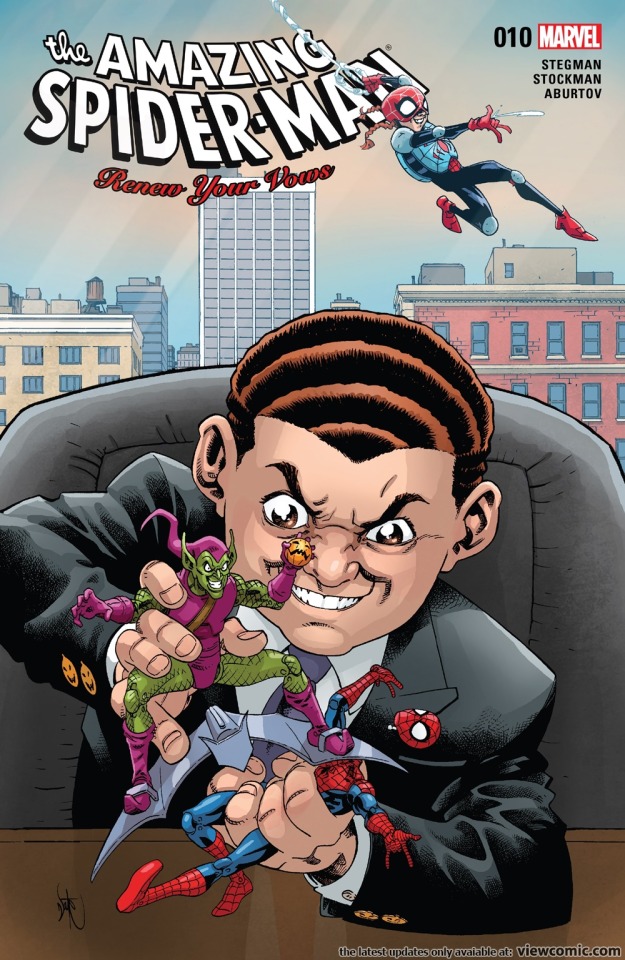


Previous thoughts here.
Even though issue #10 is a done-in-one and issues #11-12 two-parter, to all intents and purposes the three issues form a three parter, issue #10 acting as a kind of precursor to the latter issues.
First things first the elephant in the room to address is Ryan Stegman as the writer and by extension the artists filling in for him.
Whilst neither Stockman nor Level are the measure of Stegman, they both do respectable jobs, with Level’s art in particular being a better compliment to Stegman’s. This isn’t to say Stockman’s art is ill suited because like in issue #5 his style excels at expressive almost Rugrat looking child characters and issue #10 features one such character as the lead.
Stegman for his part, whilst he may be working off of ideas leftover from Conway, does a surprisingly good job. There are some problems with issue #11-12 I will talk about later, but issue #10 is great and over all his dialogue, pacing and handling of the characters is solid, shockingly solid for someone who I do not believe has much (if any) writing experience. This applies to his writing contributions to issues #8-9 too.
His work is not as layered or as nuanced as Conway’s but it’s still good, still cuts to the heart of this series (family) and still delivers on the emotion when needed.*
This arc as a whole provides a decent enough wrap up to the over all subplots across the series and the 12 issues as a whole did a good job in the pacing department.
I despise decompressed storytelling but RYV up to this point has handled it really well. The first 4 issues were the guiltiest in this department but their style of pacing was justified. Beyond that it’s been done-in-one stories or else two parters or in this case a pseudo three parter. This keeps things nice and breezy and makes you feel like things have actually advanced quite a bit since issue #1.
Of the three issues though it must be said issue #10 was the strongest and most interesting.
I said back when I covered issues #8-9 how I appreciated that each story across the series was mixing up which characters get the focus (last arc being Peter and more noticeably MJ) and that continues here. Whilst technically Normie is the lead character of issue #10 it’s Peter and Annie who’re the Parkers getting all the focus here, and it’s adorable.
This is something we haven’t seen before outside of that back up from issue #1 and it’s nice to call back to that (along with the fact that Peter pumps Annie full of sugar when MJ’s away). The clever part of the story is how the focus upon Peter and Annie is complimented by the Lizard and Billy’s opposition to them. This recalls Mr. And Mrs. Spider-Man #1 from 2009 but also emphasises the key point of this story: Normie’s loneliness.
The whole issue is an exploration of Normie, his attempts to live up to his father and grandfather’s toxic legacy and how that quest and their absence in his life has left him alone and unprepared. He thinks he’s grown up to cope with the challenges facing him but he is still ultimately a sad little boy who misses his family.**
In particular in this issue and the next two Normie’s problems are highlighted when contrasted to Annie. Annie expresses gratitude for having a loving family like Normie lacks, calls out Normie on the depressing state of his young life and behaves (comparatively) more like a real child of around their age.
But it is also Peter’s treatment of him with small sympathy that highlight’s Normie’s childishness and pitiful emotional state. We see his anger is born less from a desire to honour his legacy, or even plain old revenge but more a childish anger about just not having his parents (specifically his Dad around). And Stegman and Stockman just sell it!
You see the shades of Norman and Harry’s vendetta cropping up in him but just from a different angle. This permeates through the arc actually and both directly and more subtly recalls DeMatteis and Buscema’s Harry Osborn arc from the early 1990s.
It’s not just fun or coincidental references either it taps into the idea of how family legacies can be toxic which is contrasted nicely with the family dynamic of the Parkers.
This comparison and contrast between the Osborns and Parkers deepens in issues #11-12.
The most obvious example to bust out is the one already drawn (but done better here imo) from the Venom arc. That of MJ and Liz Allan both being mothers who will go to extremes for the sake of their children, with their confrontation in this arc being pretty juicy.
But we also see it in Peter’s protectiveness over Annie too. In another potentially genius call back to Spec #190 by DeMatteis and Buscema (and possibly RYV vol 1 #2), a rage fuelled Peter beats the crap out of the Rhino due to him threatening his family. This is both a realistic reaction for a parent to have and also very true to Peter’s established character in both RYV and the 616 universe, and something not displayed much in RYV vol 2.
In a way this arc marries (if you pardon the pun) the kind of extremes Peter was shown to have regarding Annie from vol 1 with those MJ had been given in vol 2 as the story shows both becoming aggressive in pursuit of rescuing Annie.
In having Peter hunt down Annie, Annie confront and attempt to redeem Normie and MJ get to the bottom of her Venom situation with Liz, issue #11 does a great job of closing out the over arching story of volume 2 by having the Parkers all equally be the focus. Issue #12 kinda does the same thing by involving the X-Men and similarly the use of a Regent power draining mech helps tie-back into the original RYV.
Issue #12 in regards to balancing out the family has a few more mixed results, but it depends what you want out the conclusion.
The story again provides us with a nice change up in the dynamics as it’s more Annie and Normie’s story than it is Peter and/or MJ’s. So it’s something different, but for a wrap up arc maybe having the Parkers fight all together was more thematically appropriate.
It certainly isn’t poorly done though. Annie comes into her own, Normie is believably redeemed and the story has a great message about how words can sometimes win out over fists.
There is also a great twist (kind of) in having the background character Ms. January wind up as the main villain, allowing for Normie to be redeemed and allowing him to break the Osborn Curse of which the arc is named after. It also ties back into the theme of family as Ms. January’s actions stem from a kind of motherly instinct towards Normie.
The action is pretty decent as are the stakes.
Giant robot = Bad.
Giant robot vs a powerless Spider-Man and Mary Jane = Very bad
Giant robot vs a powerless Spidey and MJ whilst it also has the powers of four of the X-Men = How ARE they gonna get out of this one?
Speaking of the X-Men, the arc handles them in a way I appreciated. Not only does their presence recall RYV #1 but it also ups the stakes whilst not allowing them to take away any of the spotlight from the Parkers.
Specifically Annie who comes into her own as I said and this then leads into a pretty organic transition into the new 8 years later status quo.
So...all great right?
Well...not exactly.
Let’s put aside how the Goblin mech having the X-Men’s powers was somewhat underutilized. Let’s put aside even how as I said it maybe should’ve been better if all three of the Parkers were involved in bringing down the threat.
Let’s instead talk about the three big elephants in the room.
Elephant #1: Venom
When I finished RYV #9 even though MJ was still wearing the symbiote I presumed that she’d beaten it and was going to get rid of it. Seemed like the obvious and natural ending to that arc right?
Right...except that didn’t happen.
I was truly surprised when I saw MJ in the suit during this arc. It got me thinking her absence and trip to the hospital in the prior issue made more sense.
But narratively it served little purpose here. It gave MJ something to do in issue #11 I guess but equally MJ could’ve gone to confront Liz without the symbiote simply to learn why Liz had done what she did.***
So why did MJ keep the costume? My suspicion it was purely to justify her still wearing it in Venom-Verse and thus milk MJ in the suit more given how the marketing department (or whoever) were the people who pushed that onto the series in the first place.
It wouldn’t be much of a problem if not for the fact that it’s disposed of so cheaply and easily in issue #12 and you have to No. Prize why she couldn’t have gotten rid of the suit earlier.
The Fantastic Four were mentioned in issue #10 and since they were the guys who got Peter and the symbiote separated in the first place you’d think this wouldn’t be a problem. The ONLY explanation I can dream up (and this isn’t present in the story mind you) is that the symbiote was altered somehow by Liz to be resistant to fire and sonics, hence why in issue #9 MJ punches a flamethrower or something with no problem.
Elephant #2: Ms. January.
Conceptually a background character turning out to be a villain in a twist is great. Problem is we never learn why.
At first it seems like Ms. January just cares for Normie that much but not only is this an offhand motivation in the first place but more poignantly Harry (not Normie) is brought up more than once by Ms. January in issues #11-12.
So it has something to do with him but we never learn what exactly.
She just switches on everyone, goes nuts and it’s because of Harry.
????????
I think this is an example of Stegman being an artist more than a writer tripping up, it may well have been Conway’s original plan for Ms. January to be the final boss but he hadn’t fleshed that part out and Stegman just plugged it in.
Elephant #3: This arc takes waaaaaay too much stuff from Spider-Girl.
I love Spider-Girl. She is my second favourite Spider character behind Peter himself. Her series was a triumph and an underrated all time classic.
And one of the key parts of that series was Normie Osborn being a sad lonely young man self-destructively trying to live up to his father and grandfather’s legacy as a Goblin, and avenge what he perceived as his father’s death due to Spider-Man. The subplot wraps up in Spider-Girl #27, my favourite issue of the series, in which Spider-Man’s daughter is captured and at the mercy of Normie, calls him out on his BS, expresses sympathy for him and with kindness talks him into changing his ways, finding redemption and becoming an ally to her.
Sound familiar?
Here is the thing, putting aside how Spider-Girl did it better, there is nothing wrong with repeating the same ideas to an extent.
But it is the fact that they repeat the redemption part and the manner in which it happens that is the problem. No Normie isn’t borderline suicidal in this story but he’s still on a path to destruction and still has Annie at his mercy and she still is the one who redeems him.
It would’ve been a better take had it actually been Peter who talked him down.
The comparisons to Spider-Girl are not helped by many fans feeling RYV and Annie supplanted Mayday in certain respects and more poignantly that from here on in the series would be borrowing waaaaaaay too many elements from Spider-Girl, starting with the epilogue to this issue where Annie becomes a teenager.
So...in a lot of ways this arc had the weakest writing of RYV up to this point, but I think it’s strengths in spite of it’s weaknesses combine to render it stronger than the X-Men arc and thus only the second weakest arc of the series thus far. In particular I have to commend them for making so much of it work as they did in spite of Conway leaving.
I doubt I’d be complaining this much had I read these at the time of their release though simply because back then these would’ve still been infinitely better Spider-Man than Slott’s clownshow.
Were I to give issue #10 it’s own grade it’d be an A-.
But the 3 issues collectively get a B-.
Good, worth a read but very flawed nevertheless.
*Which is very damning when you consider Stegman, an artist, was a better Spider-Man writer in 3-5 issues than Slott was across 10 years.
**Also the story explains why Normie seems more intelligent than he should be, it’s because of the Goblin formula which helps resolve what otherwise would’ve been something of a contrivence.
***Speaking of which how did Liz know Spinneret would’ve taken her bait about the symbiote? Not saying there is NO explanation but we don’t really get one ever.
P.S. How the Hell can this random orb contain Peter’s powers? His powers stem from being altered on a genetic level!
#RYV thoughts#renew your vows#Spider-Man: Renew Your Vows#Amazing Spider-Man: Renew Your Vows#Spider-Man#Spinneret#Spiderling#Anna May Parker#Peter Parker#mjwatsonedit#mary jane watson#mary jane watson parker#Ryan Stegman#Normie Osborn#the lizard#green goblin#gerry conway#norman osborn#harry osborn#Liz Allan
29 notes
·
View notes